

Cruise The Greek Islands On Your Private Yacht
The Mediterranean, and especially Greece and the Greek Islands, represents the ultimate charter yacht cruising vacation or holiday. No better way to visit this incredible archipelago of islands than from the deck of your own fully crewed sailing or motor yacht vessel. Charter or hire your special luxury or mega yacht from Luxury Yacht Vacations, Ltd..
The Mediterranean and especially the Greek islands have fascinated sailors, poets and scholars for thousands of years. Today the islands offer an intriguing look at our cultural and political heritage and, without getting too thoughtful, give us what we are all looking for in a vacation: polite peaceful locals, superb food, unbelievable scenery, clear waters, great diving, and a choice of quiet time or endless partying. Your one or two week Mediterranean Greek Island cruise should be limited to one of the five major groups of islands described on the menu at top right, or perhaps two of the groups if you have the time. Let us plan your cruising vacation; Call or Email Us: Cruise The Greek Islands On Your Private Yacht for availability and rates.
Use our expertise to your advantage – let us do the hard work of finding the right vessel in the right place at the right time. Luxury Yacht Vacations can find that unique and special luxury boat for your charter holidays. Call Us, we are available 24/7.

Mykonos Santorini & Cyclades
The Cyclades (from the Greek word for ‘rings’ or ‘circles’) is the central group of islands in the Aegean, so named because of the way they seem to surround Delos, the ancient centre of trade and worship.

Athens & the Peloponnese
On the south eastern side of Peloponnese this route combines beautiful islands and the magnificent eastern coast of the Peloponnese. Along this route you will explore many cosmopolitan towns, ancient temples, small peaceful fishing villages…

Rhodes Kos Dodecanese
The Dodecanese, which means ‘ the Twelve Islands’ in Greek, lie in a crescent chain down the Asiatic Turkish coast curving west towards Crete. The name “Dodecanese” is of comparatively recent origin.

Corfu & Ionian Islands
To those of you who visualize a country of sun-baked rock dotted with dazzling whitewashed houses, the Ionian comes as a gentle surprise. This is not the Greece of the popular travel brochure but a shaded green country, sheltering…

Sporades Skiathos
The Sporades islands lie in the Northwest Aegean Sea, off the East coast, near the peninsula of the south Pelion mountains. The three main islands in the Group are Skiathos, with its own international airport, Skopelos…

Crete Island
The Crete island located in the south of Greece is one of the most famous islands. The island has everything to offer: mountainous landscapes, a coast with many beautiful beaches and rocky coves, beautiful towns and charming …
Choose Your Yacht Type
Motor Yacht Sailing Yacht Turkish Gulet Other
Your Question
Please leave this field empty.

- Cyclades Islands
- Ionian Islands
- Saronic Islands
- Dodecanese Islands
- Sporades Islands
- Northern Greece
- Booking Procedures

SAILTHEGREEKISLANDS.com
The ultimate way to discover and sail the greek islands is on board your own private, comfortable, economical and environmentally friendly sailing yacht..

SAILING DESTINATIONS

CYCLADES ISLANDS

IONIAN ISLANDS

SARONIC ISLANDS

DODECANESE ISLANDS

SPORADES ISLANDS

NORTHERN GREECE
Did you Know?
THE WHOLE TRIP CAN COST LESS THAN JUST BOOKING A HOTEL WOULD.
When you organize your family and friends to share in the trip with you, a yacht charter will cost less than booking a hotel would, and your transportation from port to port is included . Our yachts can accommodate from two up to twelve persons.
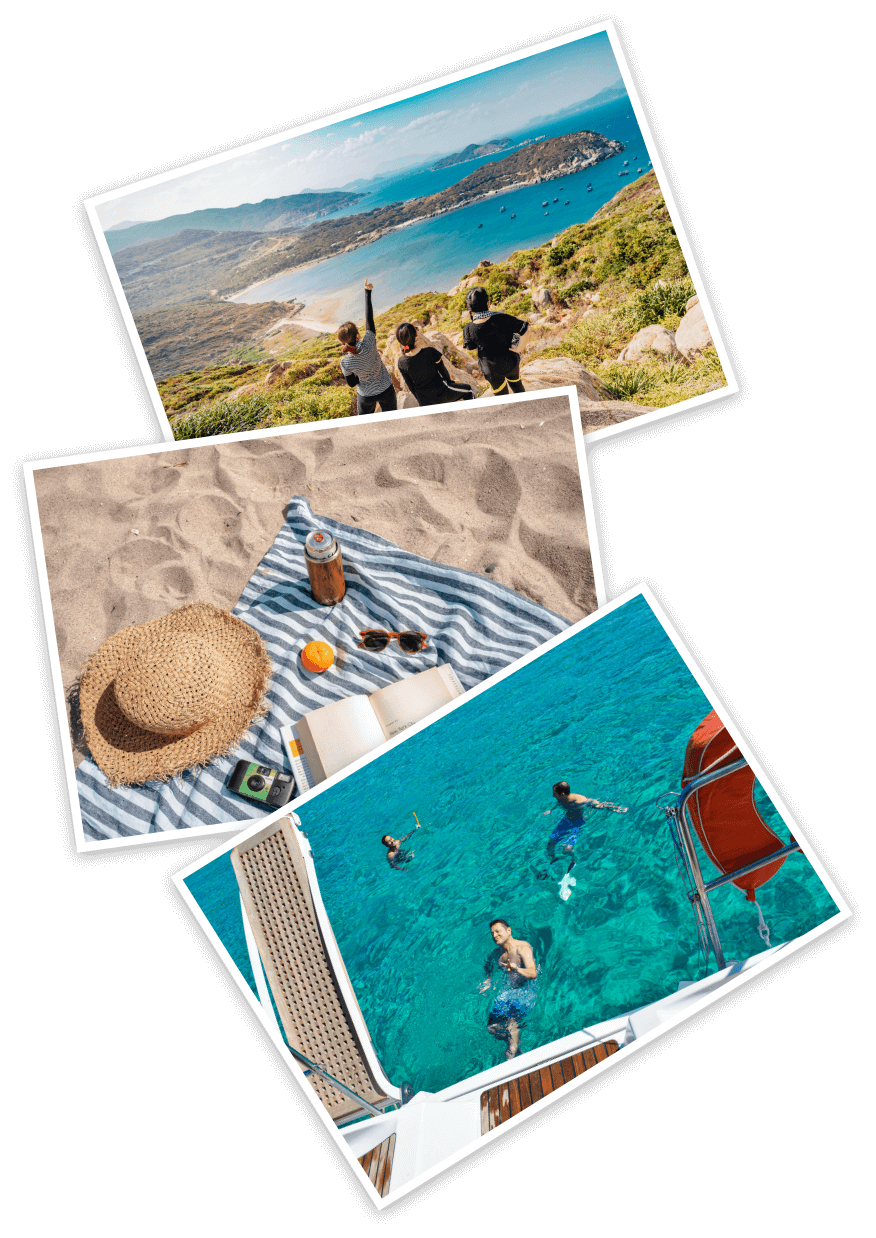
TWENTY-TWO YEARS OF
5-Star Reviews!

From the moment of initial contact with Captain Yiannis, everything was seamless.
Our experience has been nothing short of exceptional.
From the moment of initial contact with Captain Yiannis, everything was seamless. This company and the entire team could not have been more helpful! We live in the USA and never had a problem with communication. The Catamaran we selected was the Lagoon 450F. It was beautiful, spacious, clean, and easy to live on for a week as we sailed to beautiful beaches.
The Ionian Islands we visited were breathtaking, especially Kefalonia – it was our favorite! Above all, the feeling of safety that Captain George ensured throughout our trip made our journey even more memorable. We can’t wait to experience it again.
So, if you’re looking for an unforgettable sailing experience around the Greek Islands with a professional company and a knowledgeable and friendly guide, look no further!
Caroline Groeneveld July 7, 2023
Read More Inspiring Experiences...
The Great Greek Adventure
We have seen many islands thanks to Yannis, who has an unsurpassed knowledge of the, and we might add amazing docking skills! Matoula has been an amazing hostess, a wonderful cook and always gracious with a beautiful attitude. We will never forget our Great Adventure!
Danny and Karen June 7th 2019
A safe pair of hands, experience and unlimited knowledge.
We’ve just spent a week sailing the Greek islands with Captain Yiannis. If your looking for a safe pair of hands, experience and unlimited knowledge of the Greek islands then Yiannis is the captain you need.
Jeff Brown May 10th 2019
Great knowledge of the area and its history.
Excellent week of sailing in the Greek Islands with Yiannis. He has great knowledge of the area and its history. He showed us unique beaches and key sites on the islands. A memorable week of adventure, drama, and weather. A great first visit to the country of Greece and its islands. Recommend Yiannis as a skipper and guide for your trip.
David and Suzanne Kelly September 25, 2021
The kids enjoyed jumping off the boat and even steering.
We made it back safely and happily to Paros today. Yianni showed us secluded beaches, surprising chortas and agreed to take us to santorini even though he hates sailing there! The kids enjoyed jumping off the boat and even steering it on occasion. It’s a beautiful part of the world and we’d definitely recommend exploring it.
Christine August 22, 2021
Yannis is a superb captain
First and foremost, Yannis is a superb captain. He is a true professional and puts the comfort and safety of the guests first. We had a superb week and thanks to the knowledge of Yannis we visited hidden beaches and places that were sublime. Yannis is passionate about sailing, and we all improved our sailing skills and learned about sailing this magical part of the world.
We cannot wait to return and know that Captain Yannis is our go-to Greek master of the seas.”
Kim Cornwall and friends October 14, 2021
The best tavernas for dining and the most interesting places to visit.
My friends and I had a terrific sailing trip with Cpt. Yiannis. We sailed islands from Athens to Milos for a week. [...] Captain Yiannis was not only an outstanding skipper, but he also is a very knowledgeable tour guide. [...] Also, he had tremendous knowledge of any island we stopped on the way and recommended the best tavernas for dining and the most interesting places to visit.
The captain was very professional and sailed extremely safe and responsible. Great guy, a great captain, thank you, Captain Yiannis!
Remis – Boston, USA June 26, 2021
Yannis gave us the ideal family yacht
We had a wonderful week of sailing in the Saronic Gulf end of August. Yannis gave us the ideal family yacht for this bareboat charter trip . Together with the charter company we felt us in very good hands, for all questions we had. Except in this year 2020, with these special conditions!
Thanks Yiannis.
Marc Schwarz September 6, 2020
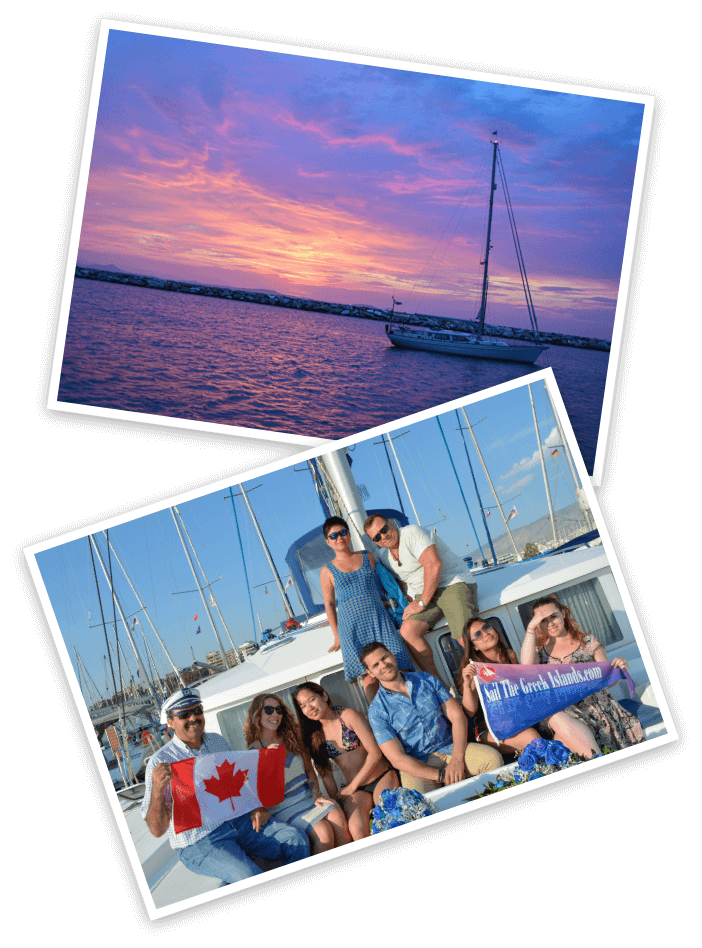
WHY SAIL WITH US?
“We are a Reputable Yacht Charter Agency with Over Two Decades of Experience. Our Authorization, Reliability, and Trustworthiness Have Been Affirmed by More than a Hundred 5-Star Reviews from Highly Satisfied Guests.”
“We Serve as the Authorized Representatives for All Yacht Charter Companies in Greece.”
“Our Expertise Allows us to Meticulously Search, Evaluate, and Provide You with the Best-Priced, High-Quality Yachts that Meet Your Requirements, Precisely at the Location Most Suited to Your Needs.”
- We have 99 % Happy Clients in 22 years of Sailing.
- Your number one choice for VALUE Yacht Charters around the Greek Islands!
- Personalized Top-Quality Service.
- With our knowledge YOU WILL GET The Perfect Yacht for Your Requirements.
- Wide Choice of Top-Quality Yachts on 15 Bases for the Greek Islands.
- Over 2,000 Top of the Line Monohulls and Catamarans.
- Damage Waiver Insurance with Low Security Deposits.
- Easy booking and payments.
- Well-Equipped And Maintained Fleets.
- Fully trained and experienced teams.
Book Your Sailing Holiday Now!
It's High Booking Season!
Save your dates for this Summer 2024 and get the Early Booking Discount!
What extra crew members will you need? Skipper Host/Hostess
This site is protected by reCAPTCHA and the Google Privacy Policy and Terms of Service apply.
We'll get back to you with offers to choose from within a few hours.
This Summer Discover
- The Crystal Clear Waters
- The Herb and Salt-Scented Winds
- The Secluded Beaches & Swimming Spots
- The Temperate Climate
- The Bright Sun
- The Fabled Mountains
- The Cycladian White Architecture
- The Picturesque Ports
- The Ancient Cultural Heritage
- The Welcoming People
This website uses cookies to improve your experience. You can opt out of non-necessaty cookies below. Privacy Policy.
ACCEPT Reject Settings
Privacy Overview

- Why Charter with Istion
- Find Your Dream Yacht
- How to Charter
- Special Charter arrangements
- Frequently Asked Questions
- Motor Yachts
- Power Catamarans
- Sailing Yachts
- Mediterranean
Private Yacht Charters in Greece and Beyond
All inclusive, fully crewed sailing holidays on amazing luxury yachts, luxury yacht charters in greece.
All of our boats are spotlessly clean, fully equipped, maintained to the highest standard and are manned by the best crews in world! Simply choose a boat from our fleet of fully crewed yachts , catamarans or motor yachts and decide which islands you want to visit. The choice is yours and we are here to assist, simply contact us to get started!
Yacht Charters
All Inclusive 5 star luxury on magnificent private boats with experienced full service crews!
Find the perfect yacht, catamaran or motor yacht for you!
Destinations
Start dreaming about your perfect sailing holiday!
Impressions
Our guests' perfect holiday is our first and only priority!
Yacht Sales
Looking for a luxury yacht of your very own? Let us take care of the details!
About Istion Yachting
Fine yachts & top quality yacht charter services in Greece.
Learn about our latest news and events.
Contact Istion
Or... get inspired:

- About Istion Luxury Yachts
- Guest Impressions
- News & Events
- Yacht Sales & Management
- Privacy Policy

- Skip to main content
Greece Yacht Charter
The perfect private luxury cruise holiday.
Greece yacht charter is the perfect private luxury cruise holiday. Nicholson Yachts offers a wide choice of charter yachts and cruise itineraries.
With over 6,000 islands in the Aegean and Ionian Sea combined, a Greece yacht charter takes island hopping to a whole new level. Greece comprises six major island groups. Each is determined by geographic location: Cyclades, Sporades, Dodecanese, Saronic, Ionian Island, and North Aegean Islands.
Immerse yourself in the local culture with a Greece yacht charter holiday. Cruise through sparkling turquoise waters. Here you can experience a bygone era. All islands are rich with ancient landmarks, pristine beaches, clear blue water and a vibrant culture. Of course, there is regional Mediterranean cuisine to sample. As a result each island has its own unique story to tell.
Highlights: Santorini and Mykonos
A private luxury cruise through the Cyclades leads to the buzzing islands of Santorini and Mykonos. Explore the Western coastline of Greece cruising through the Ionian Islands. Visit the infamous Shipwreck beach on Zakynthos. Noted for its pristine stretch of sandy beach and deep turquoise waters, Zakynthos is home to some of the best diving in the world. Undoubtedly, any island group you choose to discover will offer an exciting history lesson and vibrant cultural experience.
Greece Charter Yacht Itineraries
With over 6,000 islands to explore, Greece offers a variety of private luxury cruise itineraries. If you find it hard to make choice, then contact Nicholson Yachts. We can match you with the right charter yacht and cruise itinerary for you.
If flying into Athens, the Saronic and Cyclades Islands are the most convenient. Accordingly, they are the most popular Greece yacht charter destinations. These islands are easy to reach. As a result there is much to explore within a week's time frame. Beginning your Greece yacht charter in Athens to either Ionian or Dodecanese Islands requires at least 10 to 14 days minimum. However, both the Ionian and Dodecanese Islands have international airports. Thereby allowing easy access to embark and disembark.
Saronic Islands - Located 25 miles from Athens.
Major islands include: Poros, Hydra, Spetses, Aegina.
Because of their proximity to Athens, the Saronic Islands were one of Greece’s first island vacation destinations. As a result, they remain a popular cruising destination today. Recommended time frame of 5-7 days.
Cyclades Islands - Located 45 miles southeast of Athens.
This island group consists of 220 islands, the major islands are:
Mykonos, Santorini, Sifnos, Serifos, Naxos, Paros, Antiparos, Delos, Amorgos, Milos, Folegandros.
These islands are further apart than Saronic Island group and because of this, the distance should be considered when chartering a yacht. Additionally, the wind is another point to consider. Because the Cyclades are located in the center of the Aegean Sea, they lie unprotected by the mountainous mainland. When meltémi kicks up, it results in rough weather and potential for the Port-Authorities to impose sailing bans. This is a strong, seasonal north wind of Force 5 to 6, sometimes higher. The meltémi usually occurs in late July through August.
Dodecanese Islands - Located in southeastern Aegean Sea.
12 Islands located about 250 miles from Athens. If you begin from Athens, then it requires at least two weeks of charter time. Major islands include: Rhodes, Kos, Kalymnos, Kastellorizo, Symi
Sporades Islands - Located in the Northwest Aegean Sea.
Islands: Skiathos, Skopelos, Skiros, Alonissos.
Ionian Islands - Located off the West Coastline of Central Greece
Situated to the south of Peloponnese. Corfu, Zakynthos, Kefalonia, Lefkada, Paxi, Kythira.
The Ionian Islands are approximately 200 miles from Athens. If departing from Athens, the transit requires an expensive transit through the Corinth Canal and charterers should plan for a 10-14 day charter minimum.
Greece Charter Yacht Season
April through October
Peak season is early July into late August.
Let Nicholson Yachts plan your Greece Yacht Charter
With so many islands, itineraries and activities to choose from, it's best to have an expert charter agent to help you. Nicholson Yachts can help you plan every part of your private luxury cruise. From yacht selection to itinerary to activities, Nicholson Yachts will help you every step of the way.
Greece Charter Vacation Activities
Saronic islands activities:.
- Explore Plaka District in Athens
- Donkey ride in Hydra
- Explore Aegina, Greece’s original capital
- Explore the famous Lemon forest in Poros
- Windsurf in Paros
- Diving in Agistri
- Amphitheatre in Epidavros
Cyclade Islands Activities:
- Akrotiri in Santorini
- Mystique Spa in Santorini
- Scuba Dive in Nea Kameni and Santa Maria Wreck in Santorini
- Scuba Dive Anna II Wreck in Mykonos
- Nammos Beach club in Mykonos
- Cruise to Delos, an uninhabited island full of archeological delights
Sporades Islands Activities:
- Visit the Church of Agios IonnisKastri in Skopelos. Also known as the Mamma Mia church, this is where some scenes of the movie were filmed.
- National Marine Park of Alonissos. This is an animal sanctuary and an important breeding ground for many species of fish, birds, reptiles and mammals.
Ionian Islands Activities:
- Zakynthos Shipwreck Beach the infamous sandy cove home to an iconic shipwreck and dramatic cliffs.
- Blue Caves on Zakynthos
- Diving off of Lefkada Island
- Paxos Music Festival in September
- Old Town of Corfu (UNESCO Heritage Site)
- Melissani Caves
- Explore Vlicho Village in Lefkada
Dodecanese Islands Activities
- UNESCO World Heritage Sites in Rhodes
- Palace of the Grand Master of the Knights - Rhodes
- Acropolis of Rhodes
Plan your Greece Yacht Charters here
Nicholson Yachts welcomes your inquiry. For U.S. citizens seeking guidance on travel to Greece , the current information is available from the U.S. Embassy and Consulate in Greece. However, we are always on hand to answer your questions when planning a private luxury cruise anywhere in the world.
Questions, Comments, Inquiries?
Contact us today for more information.
Contact Us +1 401.849.0344
Popular Greece Charter Cruising Destinations
Saronic islands, cyclade islands, ionian islands, dodecanese islands, north aegean, greece luxury charter yachts, contact nicholson yachts.
Questions? We're ready to help. Please just contact us today.
- LATIN AMERICA
- MEDITERRANEAN
- Latin America
- Mediterranean
- Adventure Travel
- Private Lodging
- Private Yachts Charters
- Private Jet Charters
- About Blue Parallel
- In The Media
- For Travel Agents
Greece Private Yacht
Discover the Greek Islands from your own luxury private yacht
LUXURY YACHT GREECE
Charter a private yacht in Greece and enjoy a luxurious island hopping adventure in the Cyclades Islands. Begin your luxury tour of Greece in Athens, the birthplace of Western civilization where you will visit ancient highlights such as the Acropolis, the Museum of the Acropolis, and the ancient Agora. Then, board your luxury yacht in Athens’ port and cruise towards the Cyclades Islands. Spend the following days hopping from island to island where our expert team members will be awaiting you, disembarking for a variety of active adventures, sightseeing, and immersive experiences. While on your Greece private yacht adventure, visit popular islands such as Mykonos, known for its lively beaches and active nightlife, and Santorini, for a magnificent sunset hike around the caldera. You will also have the chance to explore islands that are less frequently visited. Stop at Polyaigos Island to swim at deserted beaches, enjoy a delicious dinner at a local tavern in Sifnos, and wander through the most charming white streets of Paros. Along the way, there will be plenty of opportunities for swimming, snorkeling, and relaxing aboard your luxurious yacht. Blue Parallel will handpick the vessel for your private yacht charter in Greece based on the needs of your group. All of the luxury yachts are fully staffed with an attentive captain and crew.
A Taste of Blue Parallel's Insider Access
- VIP Airport services in Athens
- Exclusive private opening of the Acropolis Museum
- Private luxury motor yacht with expert crew in the Cy clades
- Visit a local’s home in Paros where you can learn about the ancient weaving techniques of the region
- Traditional culinary experience in a private home with breathtaking views of Paros
- A surprise musical performance in a spectacular natural setting in Santorini
- Private volcanic wine tasting experience in Santorini
- Private helicopter services
The Discovery
The adventure, when to go.

PRIVATE YACHTING GREECE
or speak to your Travel Professional
Athens (2 Nights)
Your private tour of Greece begins in Athens, one of the world’s oldest cities. You will be taken by private transfer to your hotel in downtown Athens with views of the Acropolis. Once a powerful city-state and a center for the arts, learning and philosophy, Athens was home to Plato’s Academy and Aristotle’s Lyceum, and is often referred to as the cradle of Western civilization and the birthplace of democracy. Its heritage of the classical era is still evident and represented by ancient monuments and works of art dotted throughout the city, the most famous being the Parthenon.
After you settle into your luxury hotel, visit the innovative Acropolis Museum with your expert guide. The museum’s glass design is equal in size and shape to the Parthenon, and rotates the marble sculptures and findings exactly as they were placed at the Parthenon centuries ago. After your immersion into the rich history of the Acropolis, dine at a nearby restaurant with breathtaking views of the Acropolis.
The next day, visit the Acropolis itself, a UNESCO World Heritage Site and the most important ancient site in the Western world. Later, explore the Plaka neighborhood built on top of the residential areas of the ancient town of Athens and finish at the Ancient Agora and Roman Forums, all walking distance from your hotel. Enjoy lunch at a traditional tavern before heading back to your hotel to spend some time at leisure. Later in the evening, dine at a gourmet restaurant in town.
Yachting through the Cyclades Islands (7 Nights)
Your Greece private yacht charter begins at the port of Piraeus in Athens, where you will board your luxury motor yacht and embark on a 7 night private cruise through the Greek Isles. The yacht will be equipped with a dedicated crew giving you the flexibility to alter the itinerary when needed, according to weather or personal preferences. Please see below for a suggested Blue Parallel itinerary centered on privacy and beautiful, secluded locations. Services of personal hosts or guides will also be provided during land excursions when applicable.
Sifnos (1 Night)
On your first day, sail to Sifnos Island where you can take a scenic hike to Kastro, a picturesque, car-free village with over 3,000 years of history, for a walking tour through the ancient streets with your expert guide. Later, enjoy cocktails on the terrace of a local cafe, enjoying impressive views over the surrounding sea and mountains before continuing down to the bay where you can enjoy a unique dinner at Cantina, overlooking the water.
Milos (1 Night)
In the morning head to the uninhabited island of Polyaigos to swim in its crystal clear waters and enjoy its deserted beaches. You will make stops at different emerald bays that explode in blue color due to the underground white clay at the ocean bottom. In the afternoon, continue your Greece private charter with a visit to Milos Island, an idyllic place for those who want to experience Greece in all its beauty while skipping the crowds found on the more popular islands. On the way, stop at Sarakiniko beach located on the north shore of Milos island for an afternoon swim. Dock for the evening at the main port and enjoy dinner at a local taverna.
Santorini (1 night)
Continue your private yacht tour of Greece in Santorini, the largest island of a small circular archipelago in the southernmost point of the Cyclades Islands. Enjoy boating along the caldera with stops at the famous red and white beaches made of solidified lava for swimming and snorkeling. In the afternoon, take a private transfer to Imerovigli where you can start your hike to Skaros Rock and later continue along the caldera to Oia. This is an awe-inspiring 2.5 hour hike along the cliffs of the caldera, passing charming white churches and traditional cave houses with views of the Aegean Sea. End the hike at Oia in time to watch one of the world’s best sunsets and enjoy a fresh seafood dinner right on the water at Ammoudi port.
Antiparos (1 Night)
The next morning, you will explore Akrotiri, a Minoan Bronze Age settlement that was destroyed in a volcanic eruption around 1,500 BC. Later, enjoy a private volcanic wine tasting at an exclusive vineyard near Akrotiri. Return to your yacht where you can enjoy lunch onboard and in the afternoon, sail to Antiparos where you can enjoy an incredible sunset at Captain Pipinos.
Paros (1 Night)
Your private Greece tour continues to Paros where you spend the morning exploring its northern beaches such as Santa Maria bay where you can snorkel or dive. After lunch onboard the yacht, continue to Parikia and Naoussa, both known for their traditional Cycladic architecture, shopping, and little cafes. Then, in the late afternoon, head to a private home where you can enjoy a traditional culinary experience and cooking lesson in a traditional farm house. Following the class, enjoy the fruits of your labor for dinner with an unforgettable view of Paros.
Mykonos (1 Night)
In the morning, depart for Mykonos Island. Before reaching the main island, enjoy a private archaeological tour of Delos Island, a UNESCO World Heritage Site and ancient administrative center. Continue on to the uninhabited island of Renia for swimming in remote coves. Enjoy fresh grilled fish for lunch, then disembark at Mykonos town – the famed cosmopolitan destination and nightlife hotspot – for some shopping and sightseeing. In the evening, enjoy a gourmet dinner at one of Mykonos’ best restaurants.
Kythnos (1 Night)
Head west to end your private yacht charter in Greece in Kythnos. Kythnos Island is known for its traditional villages, beautiful beaches and rolling hills. On this agricultural island, life is simple and most of its beaches are unspoiled. Upon arrival, head to the stunning Kolona beach which connects the island of Agios Loukas with the rest of Kythnos and forms a golden stretch of sand with crystalline sapphire waters on both sides. Only reachable by boat (or on foot), this unique characteristic creates a romantic and tranquil atmosphere. End the day with a farewell BBQ on the beach, prepared exclusively for your party.
Disembarkation / International Departure
Your luxury Greece tour ends with an early morning departure for Athens port. Upon arrival, enjoy a private transfer to Athens international airport to catch your flight home.
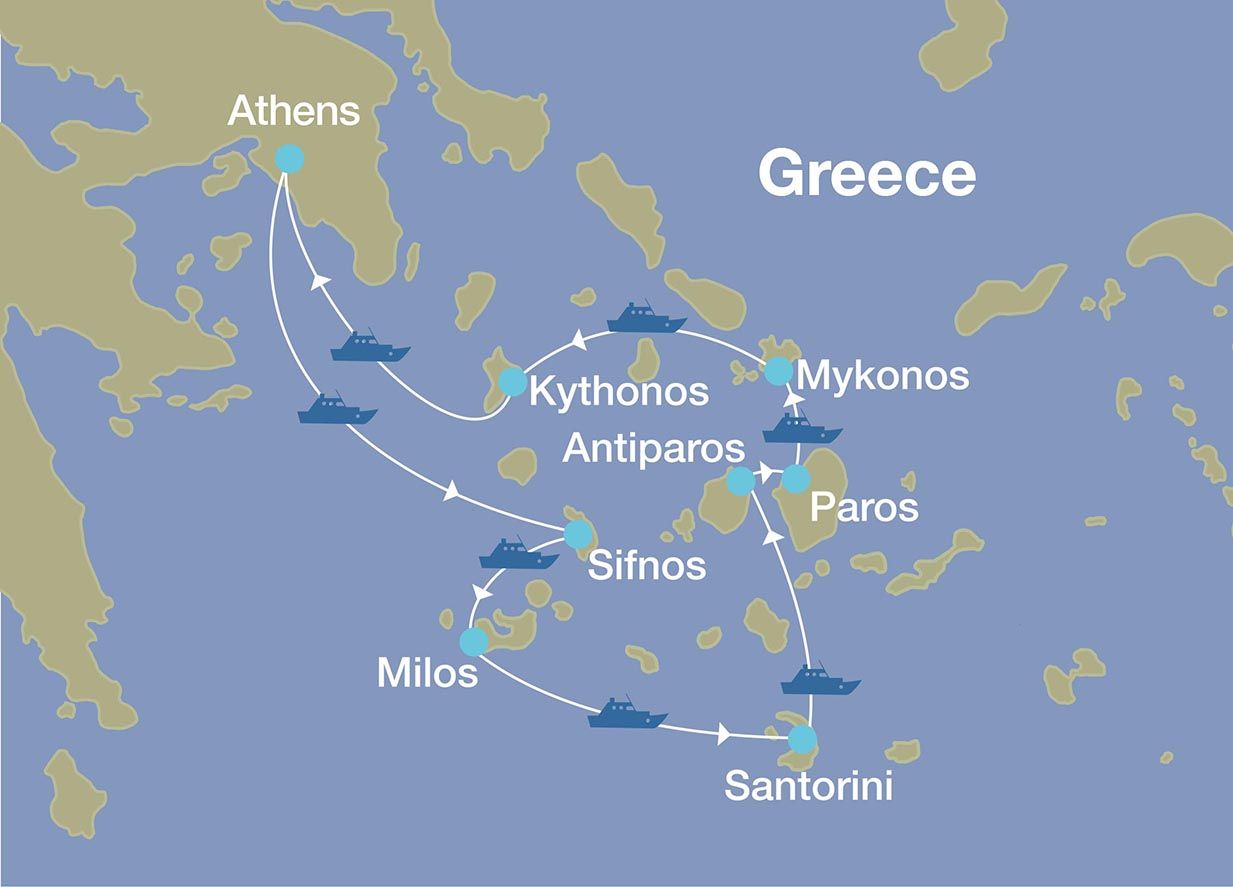
MAKE THIS ITINERARY YOURS
Photography.

PRICE REFERENCE
Note: Prices will vary based on the specifics of your itinerary and the number of passengers in your party.
Our trips to Greece are highly customized and include a choice of sea-based and land-based adventures. Pricing varies depending on the type of itinerary, period of travel, and accommodations, which ranges from a private charter, luxurious land-based lodgings, or a combination of both. Please get in touch with our team of travel experts at +1-301-263-6670 or [email protected] to find out more about pricing and itineraries for our tailor-made Greece journeys.
RECOMMENDED EXTENSIONS

Greece Luxury Travel
Private Helicopter to Delphi from Athens (1 Day): Private helicopter transfers to see Delphi’s ancient ruins.
Private Helicopter to Meteora from Athens (1 Day): Go by private helicopter to visit Meteora’s various monasteries.
Ionian Islands : Take a private yacht charter to the Ionian islands, known for some of the most beautiful beaches in all of Greece.

Turkey Luxury Travel
Explore the rich history of Istanbul from ancient Byzantine times to the modern republic, visiting highlights such as the famous Hagia Sophia, Süleymaniye Mosque, and the Taksim Square.
Soar above impressive rock formations of Cappadocia ’s rugged landscape, before discovering how the region’s history and culture have been shaped by the area’s unique geology.
Discover one of the Seven Wonders of the Ancient World – the Temple of Artemis – when you visit the Ephesus Region , also home to one of the best-preserved ancient cities in the world.
Enjoy relaxing by the beach in complete luxury when you visit the sophisticated Amanruya resort, located along Turkey’s Aegean Coast .
Take a private gulet (a traditional wooden sailing boat) along the Aegean Coast, discovering the inlets, islets and pristine beaches of the region.

Croatia Luxury Travel
Wander through the streets of the historic old town of Split , many of which were once part of the palace built by the Roman Emperor Diocletian.
Discover the most beautiful islands of the Adriatic, as you hop between the bustling harbor of Hvar , to the famous blue grotto of Biševo , the quaint townhouses of Vis , and more.
Witness the beauty of Dubrovnik from the sparkling waters of the Adriatic before exploring Old Town with its centuries of history.
Visit the fairytale towns of Montenegro , charming villages nestled in dramatic landscapes.
Enjoy an excursion to the Plitvice Lakes , a UNESCO World Heritage Site and one of the most beautiful national parks in Croatia.
Explore the rugged peninsula of Istria – excellent for mountain and road biking excursions – using the town of Rovinj as your base.
ACCESS EXCLUSIVE TRAVEL TIPS EVERY MONTH
SEE BLUE PARALLEL IN THE MEDIA

Athens Average Temperatures
Cyclade islands average temperatures, sifnos/serifos average temperatures.

Greece Luxury Yacht Charter
April - October
High Season
July - August
Cruising Area
East Mediterranean
Local Currency
A yacht charter in Greece offers the ultimate superyacht experience for those seeking sun-drenched days, a rich and vibrant culture , coupled with a generous portion of exclusivity and luxury. Explore ancient ruins and UNESCO World Heritage sites, indulge in award-winning cuisine , relax at exclusive beach clubs, drop anchor at uninhabited islands , or dance the night away at some of the Mediterranean’s hippest night spots. Cruise the crystal-clear waters of the Aegean Sea and take your pick of more than 6,000 islands and islets . Our charter brokers go to great lengths to ensure every detail of your charter getaway is flawless, including crafting bespoke itineraries and experiences. Contact Moran today.
Why charter a yacht in Greece?
Here are just some of the many reasons you should choose Greece as your next superyacht charter destination:
- Incredible cuisine and fresh seafood at local tavernas
- More than 6,000 islands, many of which are uninhabited
- The birthplace of democracy, stunning UNESCO World Heritage sites, and ancient ruins
- Crystal-clear waters, ideal for making the most of your yacht’s water toys
- Glamorous nightlife and exclusive beach clubs
- Amazing wildlife both above and under the waves
- Adventures and experiences to suit everyone
- Easy access with multiple international airports accommodating commercial airlines and private jets

Yachts For Charter In Greece

What are the best Greek Islands to explore?
With more than 6,000 islands to explore, spanning major island chains such as the Cyclades Islands, the Aegean Islands, the Sporades Islands, the Ionian Islands, the Dodecanese Islands, and the Saronic Islands, there’s a Greek locale to match every desired experience. Whether you want an off-the-beaten-track feel or want to be in the heart of all the action, Greece offers the ideal spot. Some of the most popular with yachting enthusiasts include:
Considered one of the most dazzling and exclusive of all the Greek islands, Santorini offers charm in abundance. Explore cobbled streets drenched in bougainvillea, party at decadent beach clubs, or enjoy dining at some of Greece’s most spectacular restaurants.

Sandy beaches lapped by turquoise waters, striking interiors, and pretty whitewashed buildings are the hallmarks of Mykonos. This Greek Island is known for its ultra-hip nightspots that attract internationally acclaimed DJs, refined beach restaurants, and label-laden boutiques.

Pretty Crete is one of the largest and most populous islands in Greece, known for its rich culture, superb cuisine, and spectacular National Park. Explore cities steeped in history and fascinating ancient ruins such as Knossos, first occupied during the Neolithic era, 7,000 B.C.

Considered one of Greece’s most romantic destinations, pretty Hydra will seduce you with its quaint towns and relaxed atmosphere. Hydra is a car-free island, giving it the feel of a bygone area that over the years has attracted renowned artists and jet setters in equal measure.

There’s lots going on in Rhodes, with plenty to see and do, making it a popular yachting destination. Rhode’s Medieval Old Town is a must-visit and is regarded as one of the best-fortified cities in Europe. On Rhodes, you’ll also find the ancient Lindos Acropolis.

While not technically a Greek island, mainland Greece should not be ignored. Athens is brimming with Greek culture and mythology, exclusive restaurants, designer boutiques, and world-class offerings. A must-visit is the Acropolis of Athens, a UNESCO World Heritage Site and considered the most complete ancient Greek monumental complex.

How can Moran Yacht & Ship help me charter a yacht in Greece?
No matter which island you fancy exploring during a private yacht charter in Greece, Moran Yacht & Ship’s charter specialists will listen to your needs and then craft a bespoke charter itinerary. Thanks to our superb contacts, we can also secure your reservations at the most exclusive restaurants and beach clubs, as well as arrange for private guided tours. With access to the best yachts in Greece, our expertise and knowledge is second to none. Contact our charter team today and start your Greece yacht charter vacation.

When is the best time to explore Greece on a luxury yacht?
The summer months are high-season in Greece for superyacht charters, when you can expect the best weather. Additionally, the shoulder season – late spring and early fall – are also popular, especially for those seeking a less crowded time to explore the region or perhaps wanting slightly cooler temperatures for inland exploration.

Contact Us about a Greece Yacht Charter
Learn more about chartering a luxury yacht in Greece today. Our team of experienced brokers can help you plan the vacation of your dreams!
Greece Yacht Charter FAQ
What are some highlights on a greece luxury yacht charter.
Some highlights of a luxury yacht charter in Greece include:
- Explore Greece’s ancient wonders. The most famous, such as the Acropolis, can be found in Athens, however, many of the Greek islands boast historically significant heritage sites.
- Soak up the sun on uninhabited Greek islands; with more than 6,000 islands and islets to explore, you will be spoilt for choice
- Explore local vineyards and olive groves
- Feast on delicious Greek cuisine at local tavernas
- Hike stunning national parks and discover Greece’s varied landscape
- Sink beneath the waves and discover vibrant marine life and fascinating shipwrecks.
What are the air temperatures on a Greece luxury yacht charter?
Spring (April to June): Spring is a pleasant time to visit Greece, with mild temperatures ranging from around 59°F (15°C) to 77°F (25°C).
Summer (July to August) : Summer is the peak yacht charter season in Greece, with hot and dry weather. Average temperatures range from 77°F (25°C) to 95°F (35°C) or even higher.
Fall (September to November) : Fall is another favorable time to visit on a luxury yacht charter, as crowds thin out and temperatures become more comfortable. Expect average temperatures from around 68°F (20°C) to 77°F (25°C).
Winter (December to February) : Winter is the off-peak season in Greece, with cooler temperatures and some rainfall. Average temperatures range from approximately 50°F (10°C) to 59°F (15°C).
What's the water temperature like on a Greece yacht charter?
The water temperature in Greece varies throughout the year, with warmer temperatures during the summer months and cooler temperatures in the winter. Greece has a Mediterranean climate, and its coastal waters are influenced by this climate pattern. Almost all yacht charters in Greece are during the late spring, summer, and early fall, when the water temperatures are welcoming and the weather is at its best.
- Water temperatures can range from around 57°F (14°C) to 64°F (18°C).
- Water temperatures in Greece during the spring months can range from approximately 59°F (15°C) to 68°F (20°C).
- Water temperatures during the summer months typically range from about 70°F (21°C) to 82°F (28°C).
- Water temperatures during the fall months can range from around 68°F (20°C) to 75°F (24°C).
Where can I embark on a Greek Islands yacht charter?
The embarkation destination will depend on your cruising itinerary. Many of the larger Greek Islands boast international airports that accommodate commercial airlines and private jets, ensuring easy access to your yacht charter. The most popular destinations to embark on a Greece superyacht charter include:
- Thessaloniki
How much does a yacht charter in Greece cost?
The cost of a luxury yacht charter in Greece will depend on several factors, primarily the size of the boat, its onboard amenities, your cruising itinerary, and the length of the charter. Every yacht charter is unique, from the yacht’s onboard amenities to the cruising itinerary and choice of experiences. Moran Yacht & Ship are specialists in Greece yacht charters and have access to the world’s finest superyachts and mega yachts for charter in Greece. Whether you fancy an island-hopping adventure that takes you from one paradisiacal beach to the next, or exploring Greece’s ancient wonders, Moran’s team of veteran charter agents can help. We will listen to your needs and connect you with your ideal vessel, ensuring you enjoy the ultimate charter experience. Contact our team today.
How can Moran help me charter a yacht in Greece?
If you want to discover the land of ancient gods on a Greece yacht charter, the Moran Yacht & Ship charter brokers can help. We are a leading yacht brokerage with exclusive access to the world’s finest motor yachts and superyachts for charter. We specialise in curating extraordinary yachting experiences that exceed expectations. Contact our team today.
- More than 50 years of experience
- +30 2103237640
- +30 2103227539
- [email protected]
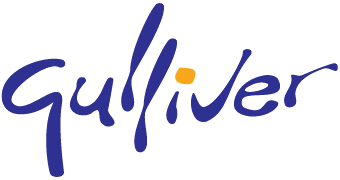
Private VIP Yacht Cruises
Mega yachts - motor yachts - sailing yachts, m/y o’ ceanos, m/y o’ pati, m/y obsession, m/s elena j, m/y monte carlo, m/s iraklis l, s/y oceanis 50, s/y callisto, luxury mega yachts, yacht specifications:.

Luxury Motor Yachts

Luxury Motor Sailer

Luxury Motor Sailers

Luxury Sailing Yachts


Greek Private Yacht Charter
Choose which of our yachts is more suitable for your needs (ANATOLIE, KAPETAN KOSMAS or SYROLANA), then see below prices and conditions. Or if you wish to hire by cabin(s) in shared yacht, then follow this link .
We sail in 3 superb archipelagos: the Cyclades, the Ionian Islands and the Sporades. For your comfort, in July and August we avoid Cyclades which can be very windy during these months.
2024 Prices
ALL PRICES ARE IN EUROS FOR ONE WEEK PRIVATE CHARTER YACHT.
*Rental – Weekly price with insurance and VAT
**Expenses – Operating costs including : Harbor and marina fees, basic salary of 3 or 4 crew members, AND fuel expenses paid by the owner (not bad surprise in the end of the trip !)
*** Total – All yacht expenses and VAT included , (except : boarding contribution for half-board & open-bar, crew tips)
To compare prices, check that you are told a price with yacht expenses and VAT included (as we do) which is rarely the case in Greece and can lead to an additional cost of 30 or 40%.
These prices are with departure and arrival at our base port. For the Cyclades: Mykonos or Syros or “one way” from or to Athens/Aegina or Athens/Marmari.
For the Ionians or Sporades in July and August, we take care of the transfer from Athens airport to the yacht if necessary. In the event of a “one-way” cruise with an empty return, or a different port of departure, the costs of empty transfers are calculated as a flat rate on the basis of 50 Euro per nautical mile, but the boat must be able to return to its base port on Friday evening.
If you wish to include Santorini in your itinerary (at the extreme south of the Cyclades), provide an additional fee of 750 Euro.
Rent of the whole yacht with skipper, Insurance and VAT
7 nights on board, from Saturday to Saturday
Crew fees except tips (if you want “service included” add 9% on the price)
Gasoil consumption and yacht expenses
Wifi / 5G on board (99% of time effective, free for email use but not possible to download movies 🙂
For our cruises to Sporades islands or Ionian in July and August, we organize transfers from Athens Airport to the yacht and back the Saturdays
The half-board and open-bar provisioning contribution, lump sum to pay on boarding time, is to add and include:
- Daily breakfast and one meal (lunch or dinner) on board (this is 7 breakfasts and 6 meals, local wine included) ;
- Basic beverages on the bar (self-service open-bar include soft drinks, local wine and beers and also ouzo in reasonable quantities) you are free to have a drink when you want and you can bring or ask the crew to buy for you any bottle you want on the market price ;
- Water, electricity on shore and any other fees for the yacht during the trip ;
- Captain and crew meals expenses for the week ;
This contribution is 350 Euro per adult, 170 for children under 12, 250 for 12 to 18, this is for the whole week. Minimum contribution (even if you hire the yacht for 2 persons) is based on 5 adults for the ANATOLIE and 6 adults for the SYROLANA and the KAPETAN KOSMAS.
The Only Extras:
- Crew gratuities to give in the end of the cruise (normal base: 7 to 10%).
- You will have then only the dinners on shore expenses to add.
- Cancellation insurance can be included by your credit card payment (check with your Bank), but is often long and complicate. We advise you to take an online travel and cancellation insurance and then pay by wire Bank to Bank without extra fees. This is the link for an insurance where we are referenced, if you live in Europe : insurance .
- For Cyclades itineraries, if you wish to include Santorini in your itinerary (extreme South of Cyclades), add 750 Euro extra-fee.
Boarding usually begin’s at 5:00pm the first day and final docking is at 9:00am the last day (example for 7 days beginning the Saturday : boarding the Saturday at 5:00pm and leaving the yacht the next Saturday at 9:00am). You can also board the Sunday morning and the yacht leaves immediately.
The itinerary is flexible, according to your wishes before and during the cruise. The captain validates the itinerary according to security imperatives, the weather and the return date. These yachts are “fifty”, means to use sails with engines. Sails give stability and security when there is strong wind, but is not often possible to use only the sails. On private cruise, if you do not have priority on the itinerary, then is possible to use more the sails if the wind allows it. Air-conditioning on the cabins is working all night when there is enough power on the shore, but even we have a special system to run it with less power, there is many harbors in Greece not well equipped. We do NOT run the generator all the night for air-conditioning like some yachts are doing, polluting their neighbors all the night. On private cruise we can choose places well equipped if it is more important for you than the itinerary.
These are the 4 ways to make cruises aboard “small boats and yachts” (we offer the option number 3):
- Option 1. “Bare boat”: all tasks are carried out by our guests.
- Option 2. “With skipper”: The skipper is responsible for the operation of the boat, guests take care of provisioning, cooking, dishes, final cleaning etc…
- Option 3. “With Skipper, hostess and sailor(s)”, 3 crew in total: You do not have to do the shopping, preparing meals or doing the dishes.
- Option 4. Yacht with full crew and “hotel service”: Additional crew members are dedicated to passenger’s service and other clean the boat during all the week. A yacht of this type has usually at least 6 crew members and the weekly price varies between 40,000 and 400,000 Euro for a group of 8 to 12 passengers. It is possible to find cheaper in Egypt or Turkey.
We offer the option number 3, with a family atmosphere on board. This means that you put your feet under the table, that the skipper is responsible for navigation, but no one is at the service of anyone, or everyone can be on the service to everyone when needed : team spirit. There are currently no cabin and hotel service and, in one week, each one will probably have the opportunity to put a little “hand dough” on various aspects of life on board (even to launch a drink or bring back your glass).
If one is used to cruise ships with a whole part of the crew for passenger’s service and expects the same thing, better to choose then a cruise ship or hire a yacht with at least 5 crew members. Our formula has advantages (small group, “as his own boat,” access to small coves and fishing villages, authenticity), but everyone can have a small participation and there is no “hotel service”.
If you book at least 8 weeks before departure you can choose to pay in 2 installments: 50% at the time of booking and 50% the latest one month before the departure If you book at least 3 months before departure you can choose to pay in 2 or even 3 installments, 1/3 on booking, 1/3 one month before departure, and the other 1/3 between these 2 payments
You can download the legal conditions of our charters here.
1. Send an email or call us on +30 6978 196 667 and tell us the following information: Choose dates and a yacht (Kapetan-Kosmas, ANATOLIE or SYROLANA), and the number of persons in your group. You will receive a confirmation by email in the following 24 hours or immediately by phone. We give you a 48 hours option to allow you to check your flights before confirming and paying a deposit.
2. To confirm your booking you have to pay a deposit of 1/3 if you wish to proceed to 3 payments or half if you want to do only 2 payments. Note that less than 8 weeks before departure you have to pay all the amount to secure your booking.
1. An easy and usually not over taxed way to pay is by Electronic Bank Transfer click here for get the information you will need to give to your bank.
2. If you want to pay by credit card for insurance reasons, there is important additional fees, so you have then to add 2% extra on the amount to pay. Example if your deposit is 1000 Euro, you have to write on “Amount to pay:” 1020 Euro as payment and not 1000. You can follow this link to pay by VISA or MASTERCARD.
You will feel as comfortable as on your own yacht
Family company means perfect knowledge of the archipelagos to the most authentic places..
“The Father” : Alexander called “The Great … BEAR!” (retired)

Capt. Themis
“The son”, Themis carries now the whole business on his shoulders.

Capt. Manolis
Manolis combines kindness and experience.

Capt. Haris
Haris has taken the helm of the Anatolie.

Your contact point, handling gracefully all requests.

Get the freshest news from us
WiFi / 3G On-board | Olympic Air | Open Seas – Ferry Schedules | Weather

BE CAREFUL, CHOOSE the ACCOUNT of THE BOAT on which YOU ARE GOING TO BOARD. In fact, each boat has a nautical company with its own professional insurance and crew members, with the same address but with a different bank account.
INFORMATION TO GIVE TO YOUR BANK FOR A WIRE BANK TO BANK:
Tel : +30 69 78 19 66 67 or +30 69 32 40 81 26
VAT number: EL-997193535
A. For the yacht ANATOLIE:
Account name: MATSAKIS NEPA Account number: EUR 5710105082199
IBAN : GR5601727100005710105082199 Bank: PIRAEUS BANK BIC code: PIRBGRAA Agency : 84100 ERMOUPOLIS – SYROS – GREECE
Address of beneficiary: MATSAKIS NEPA Palaion Patron Germanou, 9C 84100 ERMOYPOLIS – SYROS GREECE
VAT Number: EL-997193523
B. For the yacht SYROLANA:
Account name: THEMISTOKLI NEPA Account number: EUR 5710105082997
IBAN : GR4401727100005710105082997 Bank: PIRAEUS BANK Code BIC : PIRBGRAA Agency: 84100 ERMOUPOLIS – SYROS – GREECE
Address of beneficiary: THEMISTOKLI MATSAKIS NEPA Palaion Patron Germanou, 9C 84100 ERMOYPOLIS – SYROS GREECE
VAT number: EL-997193511
C. For the yacht KAPETAN KOSMA:
Account name: KOSMA NEPA Account number: EUR 5710105083021
IBAN : GR7501727100005710105083021 Bank: PIRAEUS BANK BIC code: PIRBGRAA Agency : 84100 ERMOUPOLIS – SYROS – GREECE
Address of beneficiary: KOSMA MATSAKIS NEPA Palaion Patron Germanou, 9C 84100 ERMOYPOLIS – SYROS GREECE

See the extracts of a documentary broadcast on a Major European TV, with our yacht cruises

Private Yachts to Greek Islands
- Exclusive private yacht cruises on Greek Islands
price range
You must have already planned to take a yacht charter to Greek Islands, but you might not be aware yet of the places where this cruise will bring you. Greek Islands are wonderful places for anyone out there that is planning to have a unique and grand yachting holiday. Greece is a country of rich and famous cultures which are known to the world. If you really want to have a look at these cultures then you have to rent a Turkish gullet yacht which is the most reasonable way to sail thru these beautiful islands of Greece. This yacht cruise will give you a fabulous experience of beautiful and exciting sail because of the wonderful and grandeur sites along. Looking through the Greek islands of Dodecanese and Cyclades will give you the feeling of exhilaration and excitement as ancient cultures and remains unfold.
A private yacht charter in the Aegean Sea and in the middle of the Mediterranean thru the numerous Greek Islands surrounded by the splendor of crystal clear water… Cruise to Dodecanese and Cyclades Greek Islands and discover Rhodes, Symi, Kos, Kalymnos, Patmos, Arki, Santorini, Mykonos and many others from a different perspective.

20 meters long ketch type gulet yacht with AC. Golden Joy yacht has 4 (1 master + 3 double) cabins and can accommodate 8 guests.

25 meters long gulet yacht GOKCE. GOKCE gulet yacht has 5 (2 master + 2 double + 1 twin) cabins and can accommodate 10 guests.

KAPTAN KADIR
KAPTAN KADIR is 37 meters long luxurious gulet yacht with AC. Yacht KAPTAN KADIR yacht has 6 master cabins and can accommodate 12 guests.

37 meters long yacht LE PIETRE with AC. LE PIETRE has 4 (2 master + 1 double + 1 twin) cabins and can accommodate 8 guests.

MARE NOSTRUM
Gulet yacht MARE NOSTRUM has 6 cabins (5 VIP Double + 1 VIP Twin) and can accommodate up to 12 persons. Rent yacht MARE NOSTRUM for a private yacht holiday in Turkey and Greek Islands.

Nurten A is a 31 meters long gulet yacht with AC. Nurten A gulet yacht has 7 (1 master + 4 double + 2 twin) cabins and can accommodate 14 guests.

Gulet yacht OGUZBEY has 8 cabins (1 Master+2 Double + 1 Twin + 4 Triple cabins) and can accommodate up to 26 persons. Rent yacht OGUZBEY for a private yacht holiday in Turkey and Greek Islands.

Gulet yacht AMETIST-A has 9 cabins (7 Triple + 2 Double) and can accommodate up to 20 persons. Rent gulet boat AMETIST-A (formerly SEMELE) and have an exclusive yacht holiday in Bodrum, Marmaris, Rhodes, Greece.

Gulet QUEEN LILA with AC. QUEEN LILA gulet yacht has 6 cabins (2 Master + 2 Double + 2 Twin) and can accommodate 12 guests.

SEYMA KAPTAN
25 meters long gulet yacht with AC. SEYMA KAPTAN yacht has 5 (1 master + 2 double + 2 triple) cabins and can accommodate 10-12 guests.
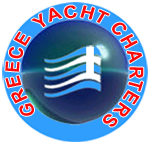
The Greek Islands
The greek cyclades islands.
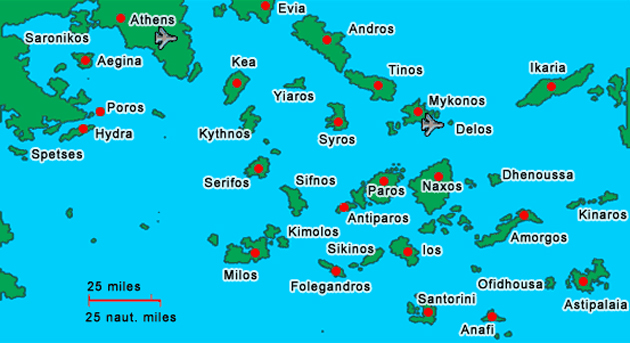
Greek Cyclades Islands Andros | Delos | Folegandros | Ios | Kea | Kimolos | Kythnos | Mykonos | Naxos | Paros | Santorini | Serifos | Sifnos | Syros | Tinos
The Ionion Islands
Private Yacht Charters
With the amount of choice available, it can be difficult to choose your destination, but with a Greek island gulet cruise, you can have them all. That’s the beauty of Turkish Gulet Cruises and the reason more and more people are choosing a yachting holiday, to wake up with the warm summer sun of the Mediterranean and find yourself sailing to a new location every day, whether you only have a few days or a couple of weeks you can see as much or as little of the Greek islands as you choose. If you want to visit the Greek islands and want to create an itinerary of your own then a private yacht charter may be what you are looking for.
Two of our most popular Greek island cruises sail from Bodrum harbour the first, cruising the north islands. After meeting your captain and crew its time to sit back, relax and let us take the reigns as we sail to the island of Kos a beautiful island steeped in tradition and ancient history it’s the birthplace of Hippocrates, father of modern medicine and there is a plane tree that many come to see as it is widely believed to be the tree the Hippocrates himself stood under and taught his students. Kos is a relatively small island that survives off of tourism yet still does not feel very touristy and at 40 kilometres long and 8 kilometres wide and a coastline of some great white sandy beaches it has hung on to its simplistic charm.
Recommended Routes
Leros is further north and much smaller but has much to see apart from the usual great food and beaches, it has a wonderful medieval castle built by the knights of saint john and one of the best museums of Greece housed in one of the original tunnels dig in the second world war. There is also a great legend attached to the island, that of a young 18-year-old knight in the 16th century who after a mighty battle where all the men of the island were killed he dressed all the women and children in the dead men's armour convincing the opposition that the islands army were still strong.
Patmos island is another beautiful location surrounded by the lightest clearest crystal blue waters and is where the book of revelation is believed to have been written. Lipsi island with its charming typically Greek whitewashed houses has an abundance of little churches and monasteries dotted all over the island with some wonderful stain-glassed windows, all dedicated to a different saint.
The island of Kalymnos is known by all the others as being the wealthiest and was once connected to the small neighbouring island of Telendos until an earthquake in 554 AD separated them. A beautiful island with amazing architecture. The north island cruise then returns to Turkish waters to Turgutreis and Aquarium bay before returning to Bodrum, back to where the cruise began.
The southern island cruise takes you directly from Bodrum to Kos, Gyali and Nisyros and then onto the island of Symi where today tourism is the main industry but traditionally the island survived for thousands of years off of boat building and sponge diving, the island is lovely and has some of the prettiest towns scattered across it from the sea as you arrive the scene that greets you is that of traditional whitewashed houses perched one after the other from high up the mountain slopes till they seem as though they might fall into the sea. The southern town of Panormatis is particularly worth visiting and has the wonderful monastery dedicated to the archangel Micheal.
It's then onto Rhodes the largest of all the Greek islands that are part of the Dodecanese islands, another stunning location with the usual sandy beaches that stretch out before, and many great tourist resorts some busy and some sleepy, but it is the main city, Rhodes Town the capital is an impending first sight on arrival, surrounded by high stone walls as far as you can see and entering in the cities main gate, you are transported back in time as you wander through a maze of wonderful cobblestoned streets that connect at every twist and turn, this place is full of restaurants and boutique shops selling just about everything, you can't help but feel its vibrant atmosphere.
On the return journey back to Bodrum you will also take time to relax swim and snorkel in the delightful Turkish bays of Palamutbuku, Cnidus, Datca, Black Island and Poyraz Harbour.
Mandraki Harbor, Rhodes, Greece
+(30) 698 0139655

800.567.2143

Welcome to Boss Cruises, one of the most famous private Yacht Cruise companies to rent on Rhodes island, Greece. Your private, unique moments for sea explorers and travelers on the spectacular island of the Knights.
BOSS is a beautiful 18.20 meters lux Ferretti fly bridge motor yacht, offered for private charters and one of the most affordable cruisers in the luxurious high quality fully crewed category in Greece.

Destinations
Escape with family or friends and rent your own luxury yacht. Take a scenic cruise along the stunning east coast of Rhodes, Lindos or Symi island.

BOSS is a beautiful 18.20 meters lux Ferretti fly bridge motor yacht, offered for private charters and one of the most affordable cruisers in the luxurious high quality fully crewed category in Greece.

Explore Rhodes and Symi.
Choose your Private Cruise

What else we offer
We offer cruises and tours on a wide variety of vessels and vehicles including Luxury Catamarans, Motor Yachts, Semi-Submarine, Bus Excursions, Hop-On Hop-Off, all provided with a high quality of services.
Privacy Overview

Greek Island and Adriatic Cruises
Greek island cruises, alternative greece cruises for individuals..
Join others on our weekly Greek island cruises and discover the Greek Islands. If you are looking for a touch of cruise adventure on the Mediterranean, by way of a casual, informal and relaxing Greece cruise vacation or honeymoon, without the routine of traditional Greece cruises tours, then our weekly small luxury motor yacht, motor sailer & sailing yacht cruises are the ideal solution for your holidays in Greece for the best greece cruises
SCHEDULED CRUISES
Explore our sceduled cruises

alpha-4 greece cruise antiquity

ALPHA-1 GREECE CRUISES

ALPHA-2 GREECE CRUISE

ALPHA-2 GREECE CRUISE 2024

ALPHA-8 UNEXPLORED GREECE CRUISE FROM PIRAEUS

Main office in Greece:
67 Poseidonos Av., 16675, Glyfada Athens - Greece Tel. +30-210-968-0486 Mobile: +306974788888 WhatsUp: +306974788888 Viber: +306974788888 Email: [email protected]
Branch office in USA:
5497 Wiles Road, Suite 202 Coconut Creek, FL 33073 Tel. +1-954-234-2203 Email: [email protected]
COOKIES POLICY
This site uses cookies. Click settings to choose the Cookies you want to enable. MORE

Navigating Paradise: The Ultimate Guide to Greece Yacht Charters for Sophisticated Travelers
Reasons for greece yacht charters among discerning travelers.
W ith its charming scenery, azure waters, and many islands, Greece offers a yachting experience that can only be rivaled by none. A holiday in Greece on a chartered yacht is more than just another trip – it allows you to enter the world of sea luxury, tremendous history, and astonishing natural wonders. Danielis Yachting is an experienced provider of luxury yachts in Greece and one of the top organizers in this exclusive niche. Each charter is not a tour but a customized path through Eden because Danielis Yachting has an up-to-scratch fleet of yachts and a crew that knows what top hospitality means.
Choose Your Ideal Yacht
Choosing the right yacht is your primary decision in your Greek sea journey. Whether you prefer a swift motor yacht, grand sailing boat, or luxurious catamaran, the experience you will enjoy will be distinct. Motor yachts provide the fullness of incredible velocity and motionlessness accordingly, while catamarans allow maximum space for your comfort. As for the grand traditional sailing boats, it is about the experience. Such unique options as danielisyachting.com propose an extensive list of yachts for all four to choose their best. The following passages will consider every type of yacht. Besides, it will provide tips on how to decide the most suitable one. Comfort, efficiency, and elegance will be highlighted.
Planning Your Itinerary
A yacht charter in Greece offers the freedom to explore secluded bays, vibrant ports, and ancient ruins at your own pace. Planning your itinerary with Danielis Yachting allows you to customize your journey to include iconic islands such as Santorini and Mykonos and hidden gems like the tranquil Ionian islands or the mystical Sporades. This section will guide you through crafting the perfect itinerary that balances adventure with relaxation and cultural exploration with leisure. We'll provide insights into the must-visit destinations, optimal travel routes, and seasonal considerations to help you maximize your Greece yacht charter.
Capturing Local Culture and Flavors
Finally, Greek cuisine and culture should be at the core of the experience. While it would be impossible to encompass each island's history and local cuisines in the manuscript, highlighting the cultural treasures accessible to guests is highly recommended. Since the crew is recruited and guided by professionals from Danielis Yachting, there is always at least one native Greek per voyage. Hence, providing an overview of common aspects, such as getaways to local restaurants and festival participation, should create a sufficient foundation for this preliminary research on local attractions on each island.
What to Pack for Your Yacht Adventure
Packing for a yacht charter differs significantly from packing for a typical vacation. This section will provide sophisticated travelers with practical tips on what to bring for a yacht journey in Greece. From the essentials like swimwear and sun protection to bright casual outfits for evening outings, we'll cover everything you need to pack. Additionally, we'll include advice on gadgets and gear that can enhance your yachting experience, ensuring you're well-prepared for whatever adventures lie ahead.
Making the Most of Your Yacht Charter with Danielis Yachting
To truly make the most of your Greece yacht charter, partnering with a knowledgeable and experienced provider like Danielis Yachting can make all the difference. This section will highlight the exclusive services and amenities that Danielis Yachting offers, from personalized customer service to additional offerings like jet skis, diving equipment, and bespoke event planning aboard. We'll explore how these services enhance your journey, turning a simple holiday into an unforgettable experience and ensuring that every trip detail is meticulously catered to your satisfaction.


Chartering a luxury yacht has never been easier in Halkidiki Greece. Enjoy the serenity of your private world.
Chalkidiki Ormos Panagias bay Aretsou Kalamaria Thessaloniki Greece
Luxury Private Yacht Cruises
Contact [email protected] +30 6932244100 +30 6941474171
facebook instagram tripadvisor

WATERSPORTS
For those who want to experience the real greek summer, "prive cruises" offer you the opportunity to explore the clear and clean waters of the mediterranean sea, spending wonderful time on board. if beautiful sunsets and spectacular beaches are what you are looking for your holidays, join us on board and relax in the middle of the sea, in a stress free environment with fine food and wine or turn your special days into unforgettable events, organizing your own private parties on the craft., memories..that count.

See Four Seasons' upcoming ultra-luxury cruise with a $350,000-a-week suite bigger than most homes
- Four Seasons says it will begin sailing an ultra-luxury yacht cruise in January 2026.
- The 222-guest vessel would have 95 spacious suites and 11 dining options — but food wouldn't be free.
- The largest suite would have four floors and bedrooms, a spa, and a price of $350,000 per sailing.

Four Seasons plans to expand its high-end hotels and resorts portfolio with a luxury 222-guest cruise ship.
The company says the 95-suite vessel will debut in January 2026 and cost a minimum of $20,000 per weeklong sailing.
For that price, the luxury hospitality giant says travelers would enjoy a one-to-one guest-to-staff ratio and massive suites spanning as many as four floors. If all goes as planned, the 679-foot-long Four Seasons I could become one of the most expensive and opulent options in the cruise industry.
The ultra-plush 14-deck Four Seasons I is scheduled for 19 voyages in 2026 to more than 130 Caribbean and Mediterranean ports.
Reservations opened two weeks ago. Those interested can register to join a waitlist or book through a travel agent.
So far, "sales have been very encouraging, and the demand is exciting to see," Thatcher Brown, chief commercial officer and head of joint operations for Marc-Henry Cruise Holdings, told Business Insider in a statement. The company is a joint owner and operator of Four Seasons Yachts.
Renderings make the Four Seasons I look as opulent as the brand's land-based properties.
Four Seasons says its vessel will have 95 suites ranging from 537 to 9,975 square feet, some with three bedrooms.
The smallest suite starts at $19,700 for a five-night roundtrip voyage to Athens, Greece.
No windowless interior cabins here: Like other ultra-luxe cruises, the suites would all have terraces and floor-to-ceiling windows.
Customers could expect upscale amenities like a walk-in closet, down-filled duvets and pillows, and marble dual vanity bathrooms, per Four Seasons.
The most premium suites would also feature additional accommodations for "personal assistants," such as au pairs or security personnel.
Some options, like the 7,952-square-foot Loft Suite, could be adjoined with seven other cabins to accommodate up to 20 people.
Without connecting cabins, the Loft Suite would already have three bedrooms and bathrooms, a powder room, and a sauna.
Others, like the largest Funnel Suite, would have its own spa and kitchen.
Four Seasons says the 9,975-square-foot mansion, partially perched in the ship's glass-lined funnel , will span four floors, four bathrooms, three bedrooms, and three powder rooms.
Not to mention the private elevator, pool, and $350,000-a-voyage price tag.
Accommodations of this price and size are generally unheard of in the cruise industry.
Luxury operator Silversea says the largest suite on its upcoming 728-guest Silver Ray will be 1,324 square feet. Competitor Regent Seven Seas' new Seven Seas Grandeur debuted in 2023 with a more expansive six-guest 4,443-square-foot option.
Both suites' sizes and prices — Regent's starts at $42,000 per person for a total of $252,000 at maximum occupancy — would be stunted by Four Seasons' promise of a 9,975-square-foot, $350,000 floating mansion.
But cabins with six-digit prices aren't unheard of.
While not a luxury cruise line, Royal Caribbean's popular three-floor townhouse on the new Icon of the Seas is being booked at an average of $100,000 a week — although it's about four times smaller than Four Seasons' largest.
Royal Caribbean and other mass-market cruise lines are beloved, in part, for their unlimited complimentary food options.
Regent Seven Seas' all-inclusive fare also covers caviar, foie gras, and Champagne.
But don't expect any of these to be free on the Four Seasons I.
Breakfast would be complimentary. Lunch, dinner, and booze would not.
The vessel's 11 restaurants and lounges would be priced similarly to Four Seasons' on-land properties. (A dinner entrée at its resort on the Caribbean island of Nevis — also one of the ship's destinations — ranges from $34 to $163.)
The pricing structure may sound odd to most cruise traditionalists. (Hey, at least WiFi would be "free.")
But some of the ship's amenities could look familiar: Like most cruise liners, the Four Seasons I would have a pool, spa, and clubs for children and teens.
The company also promises a lounge and marina that will open onto the water, giving guests direct access to activities like snorkeling or windsurfing.
Four Seasons Yachts plans to take delivery of its $399 million vessel, now being built by famed Italian shipbuilder Fincantieri, in late 2025.
A second Fincantieri-built ship would join the hospitality company's fleet the following year. The next vessel would cost more than 400 million euros, about $429.2 million, Four Seasons says.
This isn’t Four Seasons' first foray into itinerary-based vacations.
The company has also found "tremendous success" in its private jet-based "cruises," Alejandro Reynal, the president and CEO of Four Seasons, told BI in a statement.
Its 2024 vacation-by-air itineraries started at $135,000 for a 16-day Asia tour. Demand has been growing, he said, "signaling that luxury travelers are looking for immersive, exclusive, end-to-end travel journeys that allow them to explore the world with their favorite brands."
But its new ultra-luxe cruise arm would be entering an increasingly crowded luxury market, soon to be dominated by like-minded hospitality giants.
High-end Aman Resorts and Orient Express plan to launch their own luxury cruises in 2027 and 2026, respectively.
Staying ahead of the competition, Ritz-Carlton debuted its first 149-suite Evrima yacht cruise in 2021, with a second 224-cabin ship scheduled to begin sailing later this year. Its least expensive itinerary is currently $5,100 per person for a six-night voyage from Barbados to Puerto Rico in early 2025.
Interested in a hotelier-owned vacation at sea but don't want to pay the luxury price tag? Margaritaville's cruise is an affordable $75 for two nights.
- Main content
how to write essays about yourself
- PRO Courses Guides New Tech Help Pro Expert Videos About wikiHow Pro Upgrade Sign In
- EDIT Edit this Article
- EXPLORE Tech Help Pro About Us Random Article Quizzes Request a New Article Community Dashboard This Or That Game Popular Categories Arts and Entertainment Artwork Books Movies Computers and Electronics Computers Phone Skills Technology Hacks Health Men's Health Mental Health Women's Health Relationships Dating Love Relationship Issues Hobbies and Crafts Crafts Drawing Games Education & Communication Communication Skills Personal Development Studying Personal Care and Style Fashion Hair Care Personal Hygiene Youth Personal Care School Stuff Dating All Categories Arts and Entertainment Finance and Business Home and Garden Relationship Quizzes Cars & Other Vehicles Food and Entertaining Personal Care and Style Sports and Fitness Computers and Electronics Health Pets and Animals Travel Education & Communication Hobbies and Crafts Philosophy and Religion Work World Family Life Holidays and Traditions Relationships Youth
- Browse Articles
- Learn Something New
- Quizzes Hot
- This Or That Game New
- Train Your Brain
- Explore More
- Support wikiHow
- About wikiHow
- Log in / Sign up
- Education and Communications
- Autobiographies
- Personal Profiles
How to Write About Yourself
Last Updated: July 31, 2023 Fact Checked
This article was co-authored by Lucy Yeh . Lucy Yeh is a Human Resources Director, Recruiter, and Certified Life Coach (CLC) with over 20 years of experience. With a training background with Coaching for Life and Mindfulness-Based Stress Reduction (MBSR) at InsightLA, Lucy has worked with professionals of all levels to improve the quality of their careers, personal/professional relationships, self marketing, and life balance. There are 13 references cited in this article, which can be found at the bottom of the page. This article has been fact-checked, ensuring the accuracy of any cited facts and confirming the authority of its sources. This article has been viewed 5,672,437 times.
Whether you're writing an essay about yourself for a scholarship, a self-introduction, or a personal bio for a job application, coming up with the right words to capture what makes you unique can feel challenging. Fortunately, there are tips and tricks that can make writing about yourself a breeze. Want some help getting across just how impressive, interesting, and skilled you really are? Keep reading to learn everything you need to know about putting yourself into words effectively, complete with examples.

Writing of the Autobiographical Nature

- Who are you?
- What is your background?
- What are your interests?
- What are your talents?
- What are your achievements?
- What challenges have you faced?

- What is your most interesting or unique quality? What word(s) describes you the best? Choose that topic.

- Bad: I like sports.
- Ok: I'm a fan of basketball, football, tennis, and soccer.
- Good: My favorite sport is football, both to watch and to play.
- Better: When I was growing up, I would watch Big Ten football with my dad and brothers every Saturday, before we'd go outside and toss the football around. I've loved it ever since.

- Braggy: I'm the best and most dynamic worker at my company right now, so you should want to hire me for my talents.
- Humble: I was lucky enough to be awarded three employee of the month awards at my current job. Turns out it was a company record.
Writing Personal Essays for School

- Common themes or prompts for autobiographical essays include overcoming obstacles, great successes or spectacular failures, and what you learned about yourself.

- Depending on the assignment, you may need to connect a personal anecdote to a reading or an idea from class. Start brainstorming topics that are connected to that idea, to give yourself a variety of options to choose from.

- Common autobiographical essay cliches include sports stories, mission trips, and dead grandmothers. While these can all make for excellent essays if done well, it is difficult to stand out when telling the story of how your lacrosse team lost a big game, then practiced hard, then won. It has been written before.

- If you want to tell the story of your nasty break-up, start with the break-up, do not start with the star-crossed way you met. You have got to get immediately to the tension in the story.

- When you have an idea of your topic, start writing a "memory list" of specific things that you remember about the event. What was the weather like? What did it smell like? What did your mother say to you?
- Your opening paragraph will set the tone for the rest of the essay. Rather than telling the dull biographical details (your name, your place of birth, your favorite food), find a way to express the essence of the story you are going to tell and the themes you are going to explore in your essay.

Writing a Cover Letter for an Application

- Outline your qualifications and highlight your talents in a cover letter.
- Write about who you are.
- In a cover letter, describe how your education and experience qualifies you for this position.
- Explain how this opportunity will benefit your career goals.

- When in doubt, keep it brief and serious. If you are unsure whether or not telling an amusing anecdote about your friend's bachelor party is appropriate in a cover letter, it is probably best to leave it out.

- "I'm writing to apply for the entry-level position with Company Inc. advertised on your website. I think my experience and training makes me an ideal candidate for this position."
- Contrary to popular belief, it is not necessary to include your name in the body of the letter: "My name is John Smith and I am applying...." Your name will be included in the signature , as well as the header of a cover letter, so there is no need to put it in the text itself.

- Who you are and where you come from.
- Where you want to go.
- How this opportunity would potentially help you get there.

- Be as specific as possible. It is alright to note that you are "A passionate leader in all walks of life" but it would be much better to write about an example of a time you lead in a surprising way.
- Stay focused on skills and talents that connect specifically to the thing you are applying for. Extracurricular involvement, leadership roles, and other types of outstanding achievement may be important to you personally, but it may be totally extraneous. If you include something, ensure to connect it specifically to the goal of the cover letter.

- Be as specific as possible. If you are writing a university cover letter, it is obvious that you have to have a degree to get a job as a doctor, but how did you come to choose this field? Why did you choose this school? What, specifically, do you want to take away from the experience?

- Be careful about using a cover letter to critique a business. It is not the time to describe the suffering of a particular brand over the previous fiscal quarter, then promising that you will be able to turn it around with your ideas. That might not go over well if you are hired, and then you are unable to live up to the promise.

- Even if it is impressive, a high GPA or class ranking does not belong in a cover letter. Highlight it on your resume, but do not include it in two different places of the application.

- Mailing address
- Telephone and/or fax number
Expert Trick : Save time and effort by creating one generic format that you can use for many different job applications by tweaking the specific content for each one. Start with a general introductory paragraph , then a section or two fleshing out your resume and expertise as it relates to the job, and finish it off with a closing paragraph and a note of thanks.
Writing a Short Biography Note

- Pretend you are writing about someone else. Write your name and start describing that person like a character or a friend: "John Smith is the Executive Vice President of Company Inc..."

- If you are a jack of all trades, say so. Do not be afraid to list "actor, musician, mother, motivational speaker, and professional rock climber" if they all apply equally.

- It is common to list degrees that you have received. Pay particular attention to anything that ties into the work you are writing about. If you have special training, include it here.

- "John Smith is the Executive Vice President of Company Inc., in charge of marketing and overseas acquisitions. He received an MBA with distinction from Harvard and lives in Montauk with his cat Cheeto."
- Do not overshare. It can seem funny to immediately start with "John Smith loves rafting and hates eating Cheetos. He's a total boss" and such bio notes can be appropriate for some venues, however be careful to avoid awkward oversharing. Telling everyone about your killer hangover might be best left for after work talk.

- Stephen King, who is one of the most successful and popular authors in recent history, has a bio note that just lists the name of his family members, his hometown, and his pets. Consider leaving out the self-congratulation entirely.
Community Q&A

- Remember that you’re supposed to talk about yourself, it’s the main topic. Don’t talk about your friends or family, even though you may feel tempted to. Thanks Helpful 2 Not Helpful 0
- If you are having a difficult time writing about yourself, search online for examples of personal writing, in order to get some ideas and inspiration. Thanks Helpful 3 Not Helpful 0
- Don't think about how others feel about you. Everyone thinks from a different perspective. Thanks Helpful 2 Not Helpful 0

You Might Also Like

- ↑ https://www.indeed.com/career-advice/resumes-cover-letters/how-to-write-about-yourself
- ↑ https://writingcenter.unc.edu/tips-and-tools/brainstorming/
- ↑ https://ohiostate.pressbooks.pub/choosingsources/chapter/narrowing-a-topic/
- ↑ https://www.yourdictionary.com/articles/essay-about-self-writing
- ↑ https://writingcommons.org/article/using-first-person-in-an-academic-essay-when-is-it-okay/
- ↑ https://www.glassdoor.com/blog/6-unconventional-ways-start-cover-letter/
- ↑ https://english.washington.edu/writing-cover-letter
- ↑ https://www.indeed.com/career-advice/career-development/career-goal-statement-examples
- ↑ https://www.indeed.com/career-advice/resumes-cover-letters/resume-vs-cover-letter
- ↑ https://www.indeed.com/career-advice/resumes-cover-letters/whats-the-ideal-cover-letter-length
- ↑ https://www.indeed.com/career-advice/resumes-cover-letters/how-to-format-a-cover-letter-example
- ↑ https://writingcenter.uagc.edu/first-vs-third-person
- ↑ https://www.grammarly.com/blog/how-to-write-bio/
About This Article

If you have to write an autobiographical description of yourself, write down a list of your talents, interests, and accomplishments. Use this list to help you choose one specific topic for your description, such as your academic achievements or your leadership qualities. Use specific, unique details to support your topic, such as being awarded an academic scholarship or the fact that you were president of the newspaper in high school. You can list bits of your personal life, but be careful not to overshare. If you want to write about yourself a cover letter or personal essay, keep reading the article! Did this summary help you? Yes No
- Send fan mail to authors
Reader Success Stories
Zohra Asefi
Sep 13, 2017
Is this article up to date?
May 1, 2017
Feb 7, 2017
Mohammed Zufishan
Dec 30, 2016
Shubham Sanklecha
Jun 3, 2018

Featured Articles

Trending Articles

Watch Articles

- Terms of Use
- Privacy Policy
- Do Not Sell or Share My Info
- Not Selling Info
Keep up with the latest tech with wikiHow's free Tech Help Newsletter
What are your chances of acceptance?
Calculate for all schools, your chance of acceptance.
Your chancing factors
Extracurriculars.
15 Tips for Writing a College Essay About Yourself
What’s covered:.
- What is the Purpose of the College Essay?
- How to Stand Out Without Showing Off
- 15 Tips for Writing an Essay About Yourself
- Where to Get Free Feedback on Your Essay
Most students who apply to top-tier colleges have exceptional grades, standardized test scores, and extracurricular activities. How do admissions officers decide which applicants to choose among all these stellar students? One way is on the strength of their college essay .
This personal statement, along with other qualitative factors like teacher recommendations, helps the admissions committee see who you really are—the person behind the transcript. So, it’s obviously important to write a great one.
What Is the Purpose of the College Essay?
Your college essay helps you stand out in a pool of qualified candidates. If effective, it will also show the admissions committee more of your personality and allow them to get a sense of how you’ll fit in with and contribute to the student body and institution. Additionally, it will show the school that you can express yourself persuasively and clearly in writing, which is an important part of most careers, no matter where you end up.
Typically, students must submit a personal statement (usually the Common App essay ) along with school-specific supplements. Some students are surprised to learn that essays typically count for around 25% of your entire application at the top 250 schools. That’s an enormous chunk, especially considering that, unlike your transcript and extracurriculars, it isn’t an assessment of your entire high school career.
The purpose of the college essay is to paint a complete picture of yourself, showing admissions committees the person behind the grades and test scores. A strong college essay shows your unique experiences, personality, perspective, interests, and values—ultimately, what makes you unique. After all, people attend college, not their grades or test scores. The college essay also provides students with a considerable amount of agency in their application, empowering them to share their own stories.
How to Stand Out Without Showing Off
It’s important to strike a balance between exploring your achievements and demonstrating humility. Your aim should be to focus on the meaning behind the experience and how it changed your outlook, not the accomplishment itself.
Confidence without cockiness is the key here. Don’t simply catalog your achievements, there are other areas on your application to share them. Rather, mention your achievements when they’re critical to the story you’re telling. It’s helpful to think of achievements as compliments, not highlights, of your college essay.
Take this essay excerpt , for example:
My parents’ separation allowed me the space to explore my own strengths and interests as each of them became individually busier. As early as middle school, I was riding the light rail train by myself, reading maps to get myself home, and applying to special academic programs without urging from my parents. Even as I took more initiatives on my own, my parents both continued to see me as somewhat immature. All of that changed three years ago, when I applied and was accepted to the SNYI-L summer exchange program in Morocco. I would be studying Arabic and learning my way around the city of Marrakesh. Although I think my parents were a little surprised when I told them my news, the addition of a fully-funded scholarship convinced them to let me go.
Instead of saying “ I received this scholarship and participated in this prestigious program, ” the author tells a story, demonstrating their growth and initiative through specific actions (riding the train alone, applying academic programs on her own, etc.)—effectively showing rather than telling.
15 Tips for Writing an Essay About Yourself
1. start early .
Leave yourself plenty of time to write your college essay—it’s stressful enough to compose a compelling essay without putting yourself under a deadline. Starting early on your essay also leaves you time to edit and refine your work, have others read your work (for example, your parents or a teacher), and carefully proofread.
2. Choose a topic that’s meaningful to you
The foundation of a great essay is selecting a topic that has real meaning for you. If you’re passionate about the subject, the reader will feel it. Alternatively, choosing a topic you think the admissions committee is looking for, but isn’t all that important to you, won’t make for a compelling essay; it will be obvious that you’re not very invested in it.
3. Show your personality
One of the main points of your college essay is to convey your personality. Admissions officers will see your transcript and read about the awards you’ve won, but the essay will help them get to know you as a person. Make sure your personality is evident in each part—if you are a jokester, incorporate some humor. Your friends should be able to pick your essay from an anonymous pile, read it, and recognize it as yours. In that same vein, someone who doesn’t know you at all should feel like they understand your personality after reading your essay.
4. Write in your own voice
In order to bring authenticity to your essay, you’ll need to write in your own voice. Don’t be overly formal (but don’t be too casual, either). Remember: you want the reader to get to know the real you, not a version of you that comes across as overly stiff or stilted. You should feel free to use contractions, incorporate dialogue, and employ vocabulary that comes naturally to you.
5. Use specific examples
Real, concrete stories and examples will help your essay come to life. They’ll add color to your narrative and make it more compelling for the reader. The goal, after all, is to engage your audience—the admissions committee.
For example, instead of stating that you care about animals, you should tell us a story about how you took care of an injured stray cat.
Consider this side-by-side comparison:
Example 1: I care deeply about animals and even once rescued a stray cat. The cat had an injured leg, and I helped nurse it back to health.
Example 2: I lost many nights of sleep trying to nurse the stray cat back to health. Its leg infection was extremely painful, and it meowed in distress up until the wee hours of the morning. I didn’t mind it though; what mattered was that the cat regained its strength. So, I stayed awake to administer its medicine and soothe it with loving ear rubs.
The second example helps us visualize this situation and is more illustrative of the writer’s personality. Because she stayed awake to care for the cat, we can infer that she is a compassionate person who cares about animals. We don’t get the same depth with the first example.
6. Don’t be afraid to show off…
You should always put your best foot forward—the whole point of your essay is to market yourself to colleges. This isn’t the time to be shy about your accomplishments, skills, or qualities.
7. …While also maintaining humility
But don’t brag. Demonstrate humility when discussing your achievements. In the example above, for instance, the author discusses her accomplishments while noting that her parents thought of her as immature. This is a great way to show humility while still highlighting that she was able to prove her parents wrong.
8. Be vulnerable
Vulnerability goes hand in hand with humility and authenticity. Don’t shy away from exploring how your experience affected you and the feelings you experienced. This, too, will help your story come to life.
Here’s an excerpt from a Common App essay that demonstrates vulnerability and allows us to connect with the writer:
“You ruined my life!” After months of quiet anger, my brother finally confronted me. To my shame, I had been appallingly ignorant of his pain.
Despite being twins, Max and I are profoundly different. Having intellectual interests from a young age that, well, interested very few of my peers, I often felt out of step in comparison with my highly-social brother. Everything appeared to come effortlessly for Max and, while we share an extremely tight bond, his frequent time away with friends left me feeling more and more alone as we grew older.
In this essay, the writer isn’t afraid to share his insecurities and feelings with us. He states that he had been “ appallingly ignorant ” of his brother’s pain, that he “ often felt out of step ” compared to his brother, and that he had felt “ more and more alone ” over time. These are all emotions that you may not necessarily share with someone you just met, but it’s exactly this vulnerability that makes the essay more raw and relatable.
9. Don’t lie or hyperbolize
This essay is about the authentic you. Lying or hyperbolizing to make yourself sound better will not only make your essay—and entire application—less genuine, but it will also weaken it. More than likely, it will be obvious that you’re exaggerating. Plus, if colleges later find out that you haven’t been truthful in any part of your application, it’s grounds for revoking your acceptance or even expulsion if you’ve already matriculated.
10. Avoid cliches
How the COVID-19 pandemic changed your life. A sports victory as a metaphor for your journey. How a pet death altered your entire outlook. Admissions officers have seen more essays on these topics than they can possibly count. Unless you have a truly unique angle, then it’s in your best interest to avoid them. Learn which topics are cliche and how to fix them .
11. Proofread
This is a critical step. Even a small error can break your essay, however amazing it is otherwise. Make sure you read it over carefully, and get another set of eyes (or two or three other sets of eyes), just in case.
12. Abstain from using AI
There are a handful of good reasons to avoid using artificial intelligence (AI) to write your college essay. Most importantly, it’s dishonest and likely to be not very good; AI-generated essays are generally formulaic, generic, and boring—everything you’re trying to avoid being. The purpose of the college essay is to share what makes you unique and highlight your personal experiences and perspectives, something that AI can’t capture.
13. Use parents as advisors, not editors
The voice of an adult is different from that of a high schooler and admissions committees are experts at spotting the writing of parents. Parents can play a valuable role in creating your college essay—advising, proofreading, and providing encouragement during those stressful moments. However, they should not write or edit your college essay with their words.
14. Have a hook
Admissions committees have a lot of essays to read and getting their attention is essential for standing out among a crowded field of applicants. A great hook captures your reader’s imagination and encourages them to keep reading your essay. Start strong, first impressions are everything!
15. Give them something to remember
The ending of your college essay is just as important as the beginning. Give your reader something to remember by composing an engaging and punchy paragraph or line—called a kicker in journalism—that ties everything you’ve written above together.
Where to Get Free Feedback on Your College Essay
Before you send off your application, make sure you get feedback from a trusted source on your essay. CollegeVine’s free peer essay review will give you the support you need to ensure you’ve effectively presented your personality and accomplishments. Our expert essay review pairs you with an advisor to help you refine your writing, submit your best work, and boost your chances of getting into your dream school. Find the right advisor for you and get started on honing a winning essay.
Related CollegeVine Blog Posts

- Search All Scholarships
- Exclusive Scholarships
- Easy Scholarships to Apply For
- No Essay Scholarships
- Scholarships for HS Juniors
- Scholarships for HS Seniors
- Scholarships for College Students
- Scholarships for Grad Students
- Scholarships for Women
- Scholarships for Black Students
- Scholarships
- Student Loans
- College Admissions
- Financial Aid
- Scholarship Winners
- Scholarship Providers

Apply to vetted scholarship programs in one click
Student-centric advice and objective recommendations.
Higher education has never been more confusing or expensive. Our goal is to help you navigate the very big decisions related to higher ed with objective information and expert advice. Each piece of content on the site is original, based on extensive research, and reviewed by multiple editors, including a subject matter expert. This ensures that all of our content is up-to-date, useful, accurate, and thorough.
Our reviews and recommendations are based on extensive research, testing, and feedback. We may receive commission from links on our website, but that doesn’t affect our editors’ opinions. Our marketing partners don’t review, approve or endorse our editorial content. It’s accurate to the best of our knowledge when posted. You can find a complete list of our partners here .
How to Write an Essay About Yourself

Gabriel Jimenez-Ekman is a content editor and writer at Scholarships360. He has managed communications and written content for a diverse array of organizations, including a farmer’s market, a concert venue, a student farm, an environmental NGO, and a PR agency. Gabriel graduated from Kenyon College with a degree in sociology.
Learn about our editorial policies

Bill Jack has over a decade of experience in college admissions and financial aid. Since 2008, he has worked at Colby College, Wesleyan University, University of Maine at Farmington, and Bates College.

Writing an essay about yourself is no easy feat — although you may know yourself better than anyone, it can be tough to get the perspective needed to write about yourself in essay form. Despite its challenges, writing essays about yourself is one of the most crucial skills in the college application process, and we have some key tricks to make it easier. Keep on reading to learn about some of our best techniques to write about yourself naturally!
- Outline your experiences
Ask friends and family for input
- Don’t be too humble…
- Let your personality shine!
Try journaling
Read more: How to start a scholarship essay (with examples)
Outline your impactful experiences
Before you dig into prompts, try writing out a bullet-point list of meaningful experiences you’ve had. Underneath each bullet point, reflect on what they might demonstrate. Here’s an example:
- Working as part of a team
- Learning to balance school and work responsibilities
- Honing communication skills
- Developing writing skills
- Fostering a passion for my school community
- Learning to meet deadlines and balance responsibilities
- Learning to balance school and volunteer responsibilities
- Gaining an attention to detail
This is a little different than a typical resume — rather than focusing on your specific duties, try to focus on how the experience shaped your character. If you notice a lot of overlap between the experiences, that’s perfect! You can point out these recurring themes to make for an effective essay with a strong overarching point. Making lists like this early on in your writing stage can be helpful, and you may find yourself coming back to consult the list for many future essays.
Apply to these scholarships due soon

$10,000 “No Essay” Scholarship

$2,000 Sallie Mae Scholarship

$40,000 BigFuture Scholarship

Niche $10,000 “No Essay” Scholarship

$25k “Be Bold” No-Essay Scholarship

$10,000 CollegeXpress Scholarship

$1,000 Appily Easy College Money Scholarship

$5,000 Christian Connector Scholarship
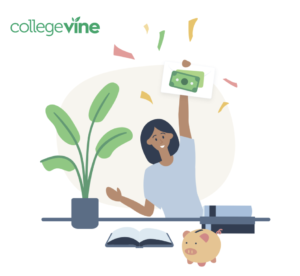
$2,000 No Essay CollegeVine Scholarship
When writing about yourself, it is important to reflect on your strengths, and who is better to do that than a supportive team of family and friends?
Consulting family and friends is a great way to learn about strengths that you might not even know you had. Your friends choose to hang out with you for a reason, and they often notice your good qualities that you take for granted. Having your friends point these out can be useful for an essay, as well as a general pick-me-up!
And if you’re looking for a perfect anecdote to answer a prompt like “How have you demonstrated a commitment to your community ,” who better to remember your past acts of kindness than your parents?
Also recommended: Top essay & writing scholarships
Is it okay to ask friends and family to read my essay and offer feedback?
Some students may be wondering, is it okay to ask for additional help from friends and family? And the short answer is: absolutely. Additional essay reviewers can offer valuable feedback as you write your essay. With this said, students should make sure that they are maintaining their own voice in the essay. Outside reviewers should not be rewriting the essay or having a heavy hand in changing the written voice.
Don’t miss: How to respond to the Common App essay prompts
Don’t be too humble
There is a time and a place for humility. But don’t worry if you feel like your essay is verging on the braggadocios. These essays are an opportunity to showcase your best qualities, and you should not be worried about putting your best foot forward and telling the reader all the reasons why they should be impressed by you.
What makes these essays effective is that they both include your relevant experiences and demonstrate why they are so significant. You may feel as though you are making mountains out of molehills, but it’s important to emphasize the importance of your experiences. This is the main objective of writing about yourself.
Also recommended: How to write a 500 word essay
Let your personality come through
Most essays written about yourself will be written in first-person. This provides a perfect opportunity to add some flair to your writing. While your first priority is to include impactful examples and communicate your points effectively, it is also important to leave a lasting impression on the reader.
If you see an opportunity to show off your sense of humor or use a more personal tone, don’t be afraid to do it. As long as your remarks are appropriate, on-topic, and not too frequent, they can help put you ahead of the pack.
Recommended: How does an admissions officer read your application and essays?
A great trick for becoming comfortable writing essays about yourself is to try keeping a journal. Journaling helps eliminate the pressure of writing an essay while helping you become comfortable writing about yourself in an informal setting. Spending 10 or 15 minutes every night writing about your day, or answering some informal prompts can help you to get more in touch with yourself and jog your memory about past events that could be useful for an essay.
Don’t miss: Scholarships360’s free scholarship search tool
Next steps for students
Now you’ve learned about the goals and techniques for writing an essay about yourself. Your next step should be to focus on making your writing effective and efficient. Make sure that your conclusion ties everything together impactfully . And once you’ve finished your draft, ask family members, friends, or college counselors to read over it and provide suggestions. Good luck, writers!
Related: Overview of common scholarship essay prompts
Frequently asked questions about how to write an essay about yourself
How do you make yourself write an essay, how do you start off an essay about yourself, what are the 3 main parts of an essay, scholarships360 recommended.

10 Tips for Successful College Applications

Coalition vs. Common App: What is the difference?

College Application Deadlines 2023-2024: What You Need to Know
Trending now.

How to Convert Your GPA to a 4.0 Scale

PSAT to SAT Score Conversion: Predict Your Score

What Are Public Ivy League Schools?
3 reasons to join scholarships360.
- Automatic entry to our $10,000 No-Essay Scholarship
- Personalized matching to thousands of vetted scholarships
- Quick apply for scholarships exclusive to our platform
By the way...Scholarships360 is 100% free!
9 Tips for Writing an Essay About Yourself
You know yourself better than anyone else, but writing about yourself can still be tough! When applying for scholarships or to college, essay prompts can feel so general (and yet so specific!) that they leave us stumped. So we’ll show you 8 tips to write an essay about yourself, so that you can land more scholarships. (Psst – Going Merry makes applying easy .)
1. Create a List of Questions
2. brainstorm and outline, 3. be vulnerable, 4. use personal examples, 5. write in the first person, 6. don’t be afraid to show off…but stay on topic, 7. show personality , 8. know your audience, 9. proofread and edit.
Let’s start with some examples of personal essay prompts:
- Tell me about yourself.
- Describe a challenge or event that made you who you are today.
- What are your short and long-term goals, and how do you plan to achieve them?
- Write about a time you failed at something. How did it affect you?
These are just a few of many scholarship essay prompts that require you to look internally, to answer a question, solve a problem, or explain a scenario in your life.
We get it. You might not be a big fan of bragging about yourself, or you might want to keep your personal stories to yourself. But by opening up and sharing your story, you can show scholarship providers, colleges and universities who you are, and why you’re deserving of their scholarship.
(Don’t just take our word for it – check out our scholarship winners page full of students like you who were brave enough to share their stories with us).

To get started, check out these 9 tips on how to write an essay about yourself:
After reading through the scholarship essay prompt, breathe, and make a list of smaller questions you can answer, which relate to the big essay prompt question.
Let’s say the main essay prompt question asks you, “What were challenges or barriers you had to work to overcome?” Then the smaller questions might be something like:
- What is your background? Family, finances, school.
- What was challenging about that background?
- What’s your greatest accomplishment? How did you get there? How have previous challenges influenced your goals?
Think of these questions as mini-prompts. They explain your story and help you answer the main essay prompt with more details than if you just answered it without a plan in place.
After considering smaller questions, it’s time to brainstorm your answers. Take out a pen and paper – or open up a document on a computer – and take your time in answering each mini-prompt. Organize your responses in order:
- Intro to main essay prompt.
- Answer about 3 mini-prompt questions.
- Conclude by rewriting the answer to the main essay prompt with a summary of your mini-prompt answers.
This organization will help you stay on topic and answer the prompt directly. (Or check out these 6 scholarship essay examples for alternative essay structures.)
Don’t be afraid to let your strengths, challenges, and personal stories shine through in your essay! Scholarship and admissions committees love to see that you’re self-aware how you can improve as a person, or how you’ve grown because of your experiences. Honest writing can help tell the best stories (in this case, YOUR story).

Since this essay is all about you , you should make your answer as specific as possible! Avoid using generalizations (e.g., “I’m really good at music). Instead, go for more personalized statements (e.g., “My fourth-grade teacher Ms. Matay really inspired me to pursue my interest in the clarinet”). Your personal examples are what will help your scholarship essay stand out among the thousands of applicants..
You’re telling your story, so write from your perspective! You can narrate your story. You can provide an overview of what you learned from your experiences. However you choose to answer the prompt, we recommend writing in an active tone, and using “I” and “me” throughout your essay.
Most students worry about bragging in their essay, but we say go for it! This is your time to shine, so highlight your accomplishments and strengths. Review your essay to make sure that you’re keeping the tone informative and that you’re still on topic. (Brag while answering the essay prompt; don’t just mention random, unrelated but impressive facts about yourself!)You can use this brag sheet where you can brainstorm your accomplishments. While the worksheet is geared toward requesting letters of recommendation , you can still use it to write out your hobbies, interests, college list , and strengths to help you answer your scholarship essay prompt.

Just because it’s an essay doesn’t mean it has to be dry and boring. This essay is all about you, so let your personality shine through. If you’re the class clown, you can use a bit of humor. If you wear your heart on your sleeve, don’t be afraid to show emotion. Trying your best to express who you are as a person will have a huge effect on the admissions or scholarship committee!
If you’re applying for a scholarship, research the scholarship provider. If you’re applying to college, research the school. Understanding what makes the provider/college unique and what their motivations are, will allow you to incorporate that information in your essay. For example, many scholarships are funded by private companies that sell products. You might want to reference those products in your essay. A good example of this is Emily Trader’s essay for the Life Happens organization , where she uses her personal narrative to explain the importance of insurance planning, since that is the mission of the organization (which is funded by insurance companies).
The last step in answering your essay prompt is to double-check your work! One typo can be distracting and cause scholarship providers to scratch their head while reading the essay. ( Psst, humble brag: Going Merry’s application platform includes spellcheck because we’ve got your back .) In addition to proofreading for typos and grammatical errors, also consider whether the sentence or paragraph structure makes sense. Are you breaking paragraphs in the right place? Are you using topic sentences well to signpost your main ideas? Does the essay flow? Consider these “bigger” structural questions too. You might also want to ask a friend, family member, teacher, or guidance counselor to review your essay. They might catch something you didn’t see the first time around, and that can really help your essay! In fact, that is scholarship winner Daniel Gill ’s #1 tip. (Another tip is to apply for scholarships using Going Merry !)

Also, check out this helpful list of the 10 most common scholarship essay topics while you’re brainstorming!

Now that you know how to write an essay about yourself, it’s time to start applying for scholarships! Remember: You’ve got this.
Sign up for your free Going Merry profile . From there, you can easily upload and submit your essay for thousands of scholarships. We make it easy so you’ll only need to enter your profile information once! And then, you can apply away. In fact, we even have some bundled scholarships so that you only enter your essay once, to apply for multiple scholarships at the same time.
Or if you’re not ready to register, simply sign up to receive an email with 20 new scholarship opportunities each week. Just enter your email address below:
Recent Posts
- 7 Outstanding Oregon Scholarships for 2021 - November 6, 2020
- Great Scholarships for Students in Ohio for 2021 - November 4, 2020
- 38 Weird Scholarships for Unique Students in 2023 - August 2, 2020
Ready to find scholarships that are a match for you?
- Legacy Projects
How to Write a Short Essay About Yourself: Step-By-Step
Updated 06/4/2022
Published 06/19/2020

Yvonne Bertovich
Contributing writer

Cake values integrity and transparency. We follow a strict editorial process to provide you with the best content possible. We also may earn commission from purchases made through affiliate links. As an Amazon Associate, we earn from qualifying purchases. Learn more in our affiliate disclosure .
Writing or even talking about yourself may not come easily to you. However, for professional or educational reasons, it’s often a necessity. There are other instances when writing about yourself may make more sense, as you can provide the rawest and most honest perspective.
Jump ahead to these sections:
Steps for writing about yourself, tips for writing about yourself creatively or confidently.
- Examples of Things to Write About Yourself
You should feel empowered—not intimidated—in taking on a writing project about yourself. Use it as a way to challenge how you view your own experiences, talents, and more. We’ll discuss some steps for writing about yourself as well as provide a few examples.
Writing isn’t for everyone, especially when it’s required. As much as you may dislike it, following the steps below can help the process go that much more smoothly.
If you find that following a different order than what we’ve recommended for you works better for your process, feel free to adjust accordingly.
Step 1: Determine your purpose
What’s causing you to write this “thing” about yourself? What exactly are you writing? It may surprise you that people write all kinds of pieces for themselves—even writing your own obituary isn’t out of the question anymore.
The more specific you can get with yourself about your purpose will help the rest of the process. If it’s something stressful, like a college admission essay or a cover letter, try to frame the project in a different light.
For example, “I’m writing this essay to show people my heart and how passionate I am about removing disparities and barriers in healthcare. I believe in my abilities, and I want to further my education, so I can help heal people.”
Step 2: Ask yourself some questions
For any good piece of writing, there has to be fact behind it (if even these facts are abstract in narrative or fiction). The best way to gather facts about any subject is to ask a variety of questions, both soft- and hard-hitting.
You may ask these questions internally, during research, or directly and literally. Treat this question step as a self-interview.
Here are some questions to ask yourself . You may also ask yourself:
- What is my goal of writing this piece?
- What themes or ideas do I want to focus on?
- What are my strengths and weaknesses?
- What are some important lessons I’ve learned?
- What do I want others to know or understand about me?
Step 3: Organize your answers
After asking yourself the example questions above as well as others, you should be sure to write down your answers and begin organizing them if you haven’t already.
It may be tempting to just answer your own questions in your head as you go—but don’t. This will just make the writing step more difficult. You may think that you’ll remember every good point or profound thought you come up with, but memory is a tricky thing.
If you’re working through your questions during a time when you’re not ready or able to sit down and type or scribble them out, at least make some notes in your phone or in a journal so you can have some descriptive hints for later. No matter how big of an epiphany you may have, it’s possible you’ll forget it.
Step 4: Write a draft
If your ideas are already fairly organized, writing your draft should come fairly easily to you. The draft process, however, is when you can start spicing things up with anecdotes, your own personal voice, themes, metaphors—all that fun stuff. The point in you writing something about yourself for yourself is for the very reason that you can make it unquestionably you .
Dull, watered-down words or even over-hyped language from a thesaurus plug-in isn’t going to impress anyone. Writing something about yourself (unless the assignment is creative or unorthodox) isn’t the time to act like something you’re not.
All of this being said, don’t stress yourself out too much. Letting your ideas flow freely and then editing or revising them later is how you should approach the process anyway. You don’t want to put too many restrictions on your ideas from the get-go. Warring with yourself about your ideas while writing is only going to tire you out sooner.
Think about it—you may spend hours trying to write a piece while overthinking that’s no better than a draft you could have written in 30 minutes on the fly. Not being totally in love with your first draft is normal. It just allows you that much more room to improve.
Step 5: Put your progress aside
Much like during the draft process, it’s very possible to overthink your work after it’s mostly done. If you constantly keep re-reading it or rehashing your ideas in your head, they may start to sound odd, or you may try to add where you need to trim.
For example, the same concept applies to repeating the same word over and over aloud — it’ll likely start to sound strange or even wrong the more you hear it. This also applies to music — ever play a song you love over and over till you hate it?
You need to give your words and your brain some time to rest away from each other until you try to make any drastic edits or changes. That being said, you may love what you’ve written already and decide you don’t need to change a thing—that’s great!
Step 6: Review and edit
After your break, you can pick up your writing once again. Read it with a critical eye. Go back and think deeply about your purpose and any provided prompts. Have you answered everything you intended to or are required to?
It’s not uncommon—though devastating—to write an entire piece only to realize you wrote from the wrong frame of reference or focused on the wrong issue. For example, if you were asked to write about a challenge you overcame in your life by following an important virtue, but you only wrote about winning a basketball championship and not the struggle behind it, this may miss the mark.
If you find a good number of issues in your work, don’t feel tempted to scrap the entire thing. What may work instead is to copy and paste your writing line-by-line into a new document. This way, you can save as much as possible while being sure to resolve even small discrepancies.
Step 7: Finalize your work
After you’ve undergone the brutal process of self-editing (or enlisting help from someone else you trust) you can prepare yourself for the home stretch. Finalizing your work shouldn’t take very long.
Y our process may differ; however, it’ll likely come down to reading over your work a few more times just to make sure you haven’t missed words, punctuation, or proper grammar.
It’s OK to use this step to feel proud of yourself, too. You may not take a lot of time to reflect on your life and everything you’ve been through—it’s important to practice self-love in this way and celebrate your accomplishments.
Talking or writing about yourself may not be everyone’s cup of tea. For example, did you need to provide a fun fact recently but draw a blank? You’re not alone. In fact, many people have a false assumption that they’re boring.
On the flip side, perhaps you’re used to talking about yourself, or, at least you’ve got the “fake it till you make it” type of confidence down-pat. However, you too can only benefit from adding a bit more razzle-dazzle to your spiels and writing assignments. Here are a few tips for writing about yourself creatively or confidently.
Allow yourself space
If you have an upcoming project or writing assignment that has you on edge, consider stepping away. Even if you don’t consider yourself an outdoorsy person, a walk around the block may help you breathe and get your creativity flowing. Naturally, the more sound your idea or angle, the more confident you’ll feel about your upcoming performance.
Keep that ego in check
An underinflated ego is just as bad as an overinflated one. Pay close attention to your internal dialogue when approaching new projects or writing tasks (or, honestly anything that comes up during your day). How much of what swirls around in your mind is fact? How much of it is just fleeting thoughts or opinions? You are not your thoughts, and you always have choices. Make good ones and be kind to yourself.
Try this: Instead of thinking to yourself, “Wow, this is a really complex writing assignment. I can’t do this.” Or, “How am I ever going to get into my dream school with this essay? I’m not a strong writer.”
Change your internal dialogue to, “I have good ideas. I may not have my plan figured out right now, but I’ll get it done,” or, “I have so many great skills to bring to the table and I am very passionate about what’s brought me here. I will convey this the best I can.”
Crowdsource
Sometimes an outside opinion can give us much-needed perspective. Ask your friends, family, loved ones, or coworkers to describe you in a few words or even in abstract ways. Don’t view this as you’re fishing for compliments. Ask your loved ones for honesty, as this insight can only help you when writing about yourself.
Build up a fuel bank
Pulling inspiration out of thin air may not always be possible. However, if you build up a few reliable sources of inspiration, the next time a project hits, you’ll be prepared. You can fuel your creativity and confidence in a variety of ways.
For example, you can create certain playlists for different moods, save favorite art or graphics in a digital folder or keep printed versions in your home or office, write down affirmations or notes-to-self in a journal or app, and so on.
Reflect on past accomplishments and setbacks
Even if you aren’t a fan of journaling, writing about yourself is far easier if you take the time to reflect, if only mentally. If you know you have a deadline to write about yourself in the near future, you may want to physically or mentally jot down a few real-life examples or experiences that come to mind.
But how do you get in the right headspace to reflect? What if you only witness recurring thoughts about past events while trying to fall asleep? Be sure to practice the first tip in this section: Give yourself some space to think. For once, limit the distractions, keep all other screens put away or turn on your "do not disturb" feature.
Now, think about some past accomplishments or setbacks that may not even seem relevant to the topic of the assignment. You may have an epiphany about unrelated things or discover something about how you operate. For example, you might realize that you feel less nervous in social and professional settings if you call out your anxiety as being excited.
Examples of Writing About Yourself
Even if you feel super confident about writing about yourself now, we wanted to provide a few short examples to help you get started. Your tone, word choice, and more may differ depending on which piece you’re working on.
Here are some tips for writing or publishing your life story you may also find helpful.
In a memoir or essay
Those were probably the best and the worst days of my life. I had never felt more happy and never felt more sad. I felt as though I were so close to having everything I had ever wanted, yet it seemed with every step forward, I had to take two steps back. It was exhausting. How did I get through it? To be quite honest, I have no damn idea.
Perspective helped. I knew I could have had it way worse; I knew that my struggle wasn’t unique. I knew, too, that even when the small wins would come they’d have yet another loss right on their tails. I paid dearly for having too much heart and optimism, so I regularly had to hose myself down with logic and pessimism.
On your blog or website
If you’re reading this, it’s too late. Just kidding! That’s just a really good Drake album. I wanted to take some time to talk about what’s been going on in my life lately for those of you who are nosey enough to care. Again, kidding, I know some of you really care. I’m so grateful to have even this small following that I have. It’s wild, really. Who would have thought that people want to know what’s going on in my head at any given time? Joke’s on you guys, though, because I don’t fully know all the time.
I guess I’ll start off by saying that work has been a whirlwind. As you all know, it isn’t an easy time for anyone, so please don’t take this declaration as a complaint. I’m thrilled to still have a job despite everything going on. However, leaving this reflection at just that would be doing both myself and you all a disservice. It’s weak. It doesn’t really describe what’s been going on. Allow me to continue.
In a college essay
When I was young, my grandmother told me I couldn’t please everyone — that some people just wouldn’t like me for no reason at all. This was very hard for me to swallow at times. What does this have to do with who I am today and why I plan to attend your university?
Well, this early lesson demonstrates that in order for this world to keep spinning, we all have to be unwavering in our own pursuits. We are ourselves. We can’t be anyone else. In that, we all have the responsibility to bring our unique talents, wisdom, and heart to the table — even when we’re seated across from people who may not like us.
Sometimes Only You Can Do It
Writing about yourself may always be challenging for you, but who better to do so than who knows you best? If you work through the process in every situation and give yourself some patience, there’s no question that you can’t craft something amazing. You may also be interested in this article about how to write family stories .
Your written words mean more than you think. This becomes a part of your legacy when you're gone, and it's one of the ways you'll be remembered. While many families choose custom urns from Foreverence or even to craft memorial diamonds from Eterneva , your words are something that live after you're gone.
While it might not seem natural at first, learning to write about yourself, your perspective, and your experiences carries a lot of significance. Who knows who might read these words when you're gone?
Categories:
- Condolences & What To Say
You may also like

9 Tips for Dealing With Family Dysfunction After a Death
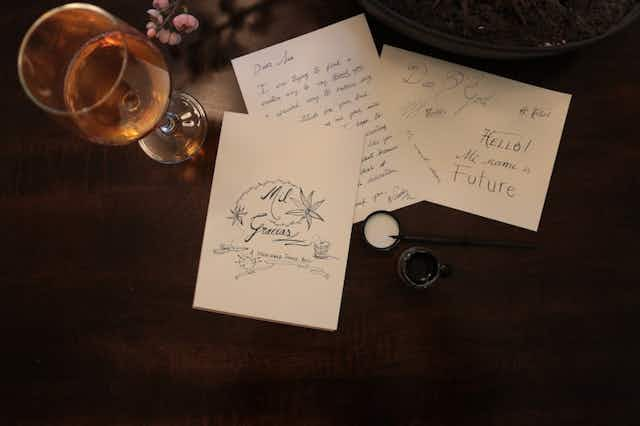
How to Write a Meaningful Letter to Your Future Self

How to Write a Thank You Letter to Your Mentor: 6 Steps

How to Write a Legacy Letter From the Heart: Step-By-Step
Write About Yourself: Tips and Prompts
by Joe Bunting and Sue Weems | 199 comments
When you have to write about yourself, do you hit a roadblock? If so, you're not alone. There are a number of situations when you have to write about yourself for school, work, or publication. Let's break down a few ways to make it easier and then use some prompts to get you started.
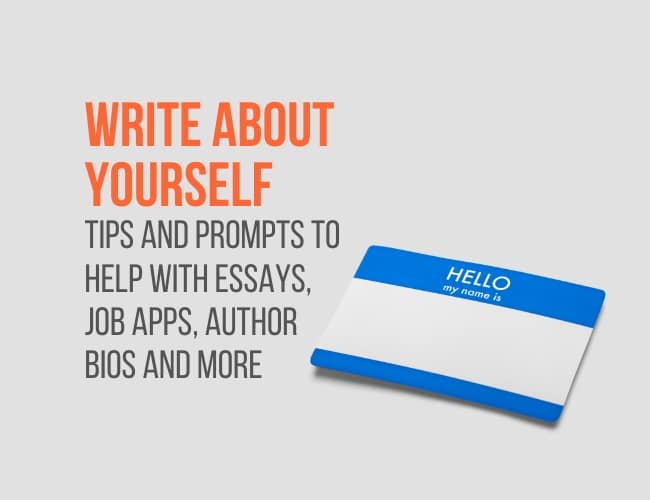
When Do You Have to Write About Yourself?
Several scenarios might require you to write about yourself from personal essays to job applications and biography blurbs.
The key for each is to think about the purpose and the target audience. Then shape your personal history or life experience into a well-crafted piece of writing that meets those needs of purpose and audience.
Let's look at a few of the most common scenarios where you have to write about yourself.
Personal Essays
Personal essays aren't just for high school. A personal essay typically reflects some aspect of your life that you are sharing for a specific purpose. Many college applications or scholarship applications ask for a college essay or personal statement to help them get to know you as a student or applicant.
If it's for a university or school application, you might write about:
- academic achievements
- personal accomplishments
- difficult experiences that helped you grow
- personal stories that relate to your desired field of study
Personal essays will have a friendly tone regardless of the essay topic. The personal examples you include or the personal stories you tell will need to be focused tightly on the audience and purpose. If you're trying to get into a university engineering program, you don't want to write about a pet's passing.
Your story of losing a pet is likely moving and will tell committee members about you and your personality traits, but it won't communicate why you might be a good fit for their school or program.
If you're writing a personal essay for a course in narrative or memoir, then of course, your story of your pet's passing would likely be a solid choice.
Personal Essay Prompts
1. Tell about a time you overcame a significant hardship.
2. Describe an interest that makes you lose track of time.
3. Tell the story of an experience or person who changed the way you thought or lived.
4. Describe a time you overcame rejection or fear.
5. How has your community shaped you as a person?
Job Applications
More and more job applications include personal statement sections or questions that ask you to describe your professional experience in more detail. Job seekers are often used to listing out bullet points on a resume, so writing about yourself can feel uncomfortable, even in a letter of introduction.
In professional settings and applications, you want to focus on four elements as you write about yourself:
- relevant experience
- recent professional accomplishments
- personal details that enhance your qualifications
- specializations
Again, keep your purpose and audience in mind. If you're having trouble narrowing down your relevant experience, consider looking at the job listing to see what they require of applicants. That way, you tailor your experience to what the position requires.
Some common job application prompts
1. Tell us about yourself. (They aren't asking about your favorite food or vacation last year! Focus on professional experiences.)
2. What are your strengths and weaknesses?
3. How have you managed conflict in former roles?
4. Describe your strongest professional accomplishments.
5. Why do you want to work here?
Remember, each of these questions is designed to help a company get to know you as a professional—share only relevant stories and details that align with that purpose.
Author or Speaker Biographies
As a writer (or speaker!), you need an author biography to include on any publications. These can be short 100 word statements that give the audience a sense of who you are as a person.
Again, the purpose and audience matters. If you are a scholar writing and speaking on a topic in your academic field, it's appropriate to list your relevant degrees and major publications to build a sense of credibility and authority.
If you're a fiction author, your biography will likely reflect a few personal details that are meant to connect with readers in a positive light.
The best way to know what will connect with your intended audience, is to look at the biographies and About the Author pages in books like your own.
A few things you might include in an author or speaker biography:
- where you live (generally speaking—not your personal address)
- themes you explore
- awards, recognition, or other publications
- relevant personal background info
You can see our full guide here on writing an author biography here .
Prompts for author or speaker biographies
1. What are the two most important things for your audience to know about you?
2. Find two authors writing in the same genre you are. Write your biography using their bios as models.
3. What themes do you explore in your work and why are they important to you? Write them out, and then condense.
4. What experience or awards are relevant to your work? List them out and pick the top two.
5. Make a list of all the things that you likely have in common with your target audience. Choose two to include in your biography.
How to Write About Yourself
Whenever you're asked to write about yourself, take it as a challenge to share relevant personal experiences with vivid details and your unique point of view. Remember that you're not sharing your entire life story. Stick to short personal anecdotes and pay attention to your purpose and audience.
How do you feel about writing about yourself? What tips have made it easier? Share in the comments.
Choose one of the prompts above. Set the timer for 15 minutes and write about yourself without stopping. If you don't have an essay, job app, or bio to write, then simply try to capture something true about yourself and your experience in the world today.
When time is up, share your practice in the Pro Practice Workshop here and leave feedback to encourage a few other writers too.
Joe Bunting
Joe Bunting is an author and the leader of The Write Practice community. He is also the author of the new book Crowdsourcing Paris , a real life adventure story set in France. It was a #1 New Release on Amazon. Follow him on Instagram (@jhbunting).
Want best-seller coaching? Book Joe here.
Sue Weems is a writer, teacher, and traveler with an advanced degree in (mostly fictional) revenge. When she’s not rationalizing her love for parentheses (and dramatic asides), she follows a sailor around the globe with their four children, two dogs, and an impossibly tall stack of books to read. You can read more of her writing tips on her website .
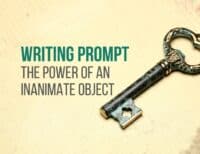
Join over 450,000 readers who are saying YES to practice. You’ll also get a free copy of our eBook 14 Prompts :
Popular Resources
Book Writing Tips & Guides Creativity & Inspiration Tips Writing Prompts Grammar & Vocab Resources Best Book Writing Software ProWritingAid Review Writing Teacher Resources Publisher Rocket Review Scrivener Review Gifts for Writers
Books By Our Writers
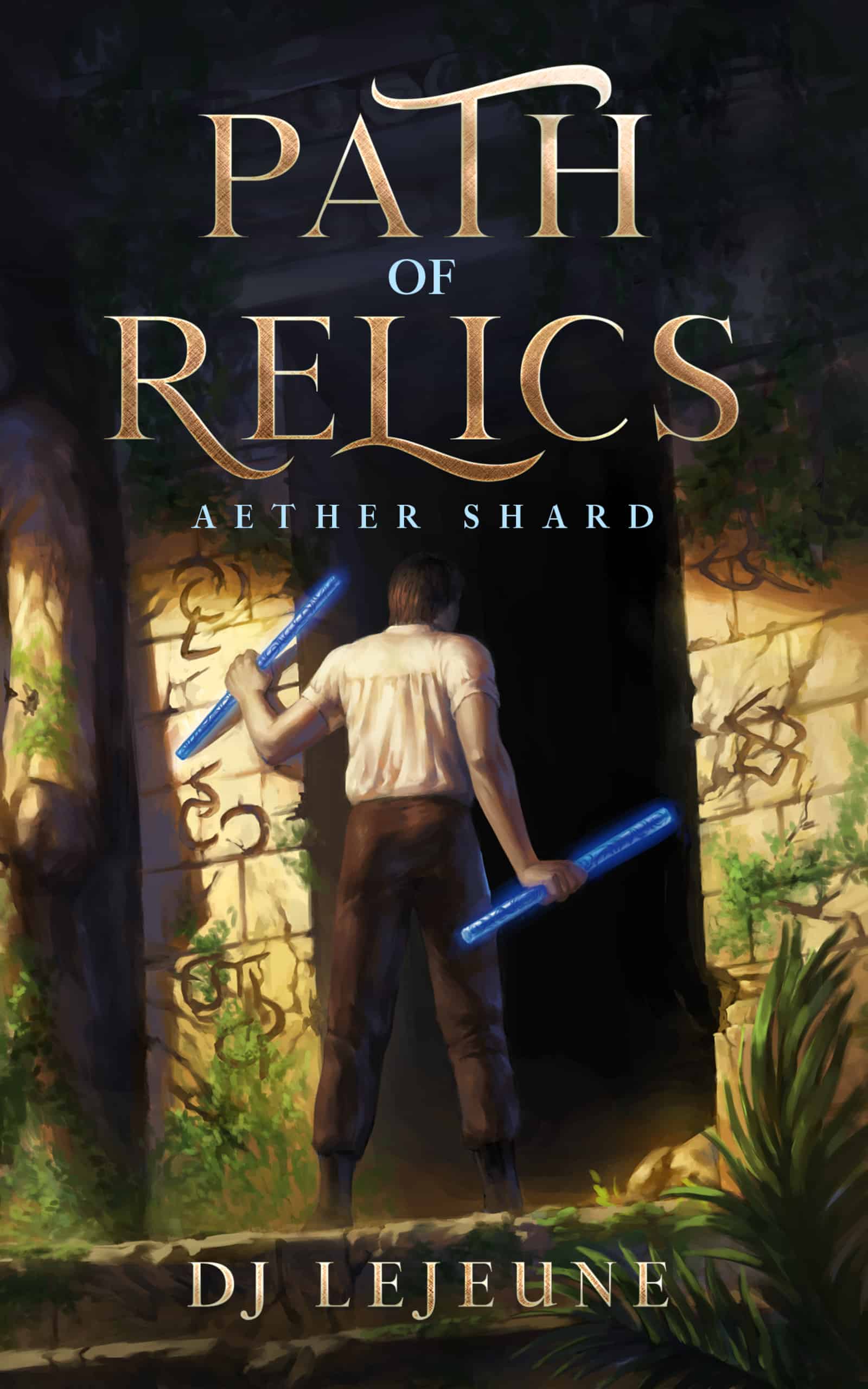
You've got it! Just us where to send your guide.
Enter your email to get our free 10-step guide to becoming a writer.
You've got it! Just us where to send your book.
Enter your first name and email to get our free book, 14 Prompts.
Want to Get Published?
Enter your email to get our free interactive checklist to writing and publishing a book.

5 Steps To Write An Essay About Yourself

Writing essays and academic papers are two such responsibilities for which students often face challenges throughout their academic life.
In fact, self-introduction essays are among the most typical assignments students confront among the many other essays.
Writing an essay about yourself necessitates you to possess excellent writing and storytelling abilities.
To produce a great personal essay, students must devote time, patience, and work. This article will educate you on how to write an essay on yourself, your family, a personal experience, and so on.
However, if you are time-pressed and unable to compose an essay, there are services that write same-day essays for students too.
When Might You Need to Write About Yourself?
Self-introduction essays or writing an essay about yourself is required during various circumstances of your academic and professional life.
Aside from the obvious cases, such as a personal statement or self-evaluations/appraisals, here are other situations where you’ll be required to write an essay about yourself:
- For graduation school applications
- When writing biographies
- For career advancement opportunities
- In cover letters and resumes
- Seeking internship opportunities
- In grant proposals
Most people think that writing an essay about yourself is one of the easiest tasks to do. Nonetheless, that may not be the case for most students.
One must possess good college writing skills to put their best foot forward and impress the reader to stand out among their peers. And here’s how you can do it correctly and confidently.
What Must the Self-Introduction Essay Include?
Writing an essay about yourself is a perfect opportunity to write about your strengths, achievements, and unique characteristics that provide an insight into yourself.
You may be confused about what exactly to write or express in your self-introduction essay. So, in this post, we will explain what you can write about yourself that will help you score brownie points and stand out amidst the competition.
Also, check out these examples and samples on self-introductory essays .
For instance, when writing about yourself, consider your path and the things that have shaped you into the person you are. You can also write about various things such as:
- Your hobbies
- Your aspirations and dreams
- The things you want to learn
- The things you are best at
How to Write an Essay
Before composing an essay, understand the basic structure and prepare an outline to avoid any mistakes down the road.
So if you are wondering how to structure an essay, remember that all essays follow a basic structure – introduction, the body, and conclusion.
Introduction
This is the first part of the essay, and it must pique the reader’s interest. You must add a ‘hook’ here to keep the reader glued.
You must provide a thesis statement at the beginning of your writing that exhibits the main idea of your essay.
Overall, the introduction must provide a brief overview of the entire essay in an engaging way.
The section contains a minimum of three paragraphs that explain the major themes or story of the essay. Ensure that each paragraph connects smoothly with the next. It is best to write in chronological order to avoid confusion.
This is the last paragraph or last section of the essay, and it must logically conclude your story. Here you can highlight the lesson you’ve gained throughout your experience. It is better to keep this section short.
Essay Structure
This is the basic structure that one must follow when writing an essay. Once you understand the essay format, create an outline that includes:
- An introduction about yourself
- Your most significant professional experience
- Noteworthy awards or personal accomplishments
- Relevant information about your personal life
Note: Make sure you use an appropriate tone if it is not mentioned. While an informal tone is used when writing about personal experiences, remember not to use any ‘slang’ words that might look unprofessional.
Steps to Writing an Effective Essay

Use particular anecdotes to highlight your accomplishments and traits without appearing pretentious.
You can also write about difficulties you’ve encountered or mistakes you’ve made to demonstrate vulnerability and personal progress.
1. Self-Reflection
The first step is to reflect on the topic before you begin writing to determine what you want to include in your essay.
Having a thorough brainstorming session can help a lot. However, here are a few starter questions that can help you:
- What has influenced your hobbies or future ambitions?
- What are you most pleased with?
- Why do you look up to someone in particular?
- Consider how your values and aspirations mirror your target university’s program and culture as you self-reflect. Develop tales that highlight the fit between the two.
2. Write Something Extraordinary
Using the questions above, pick an incident or some strong point about yourself to elucidate.
Remember that you must write about a single incident or quality that makes you stand out. Avoid talking about two qualities or two incidents.
3. Define the Goal
Read the essay guidelines and align your writing with that. The goal of your essay must reflect well in your words.
4. Know Your Audience
Think about your audience’s expectations and interests. It is critical to capture their attention and keep them reading your work until the finish.
5. Detailed Outline
The outline must be detailed and include all significant points.
Once the outline is ready, you can expand it into a full-fledged essay using the vital points. After completing the essay, proofread for typos and grammatical errors to ensure there are no mistakes.
These are the steps that college students can follow when writing self-introduction essays.
The first step to writing a successful essay is selecting an incident or quality that you want to write about.
It is recommended that you brainstorm the ideas and create an outline to avoid mishaps later.

Seven Ways to Make your College Essay Stand Out

Thank You Notes: Following Up After a College Interview

8 Differences Between Aussie and American Schools

Example of a College Essay that Needs Revision

Preparing the Best Answers for College Interview Questions

Top 5 Most Difficult IB (International Baccalaureate) Subjects
About the author.


CB Community
Passionate members of the College Basics community that include students, essay writers, consultants and beyond. Please note, while community content has passed our editorial guidelines, we do not endorse any product or service contained in these articles which may also include links for which College Basics is compensated.

How to Write an Essay about Yourself

Although you may know yourself better than anybody else, writing an autobiographical essay — an essay about yourself — can be hard. But don’t worry because you’ve come to the right place!
I’m Constance, and I’ll show you how to write an essay about yourself in five simple steps. We’ll also write a sample essay together!
Let’s get started!
Write an essay about yourself in five easy steps:
Step 1. Plan the word count for each paragraph.
Planning the word count for each paragraph will be much easier when you know the exact number of words you need for an essay. It will help you organize your ideas and present them clearly and concisely.
Any essay has three key elements:
- The introductory paragraph (introduction).
- Three body paragraphs.
- The concluding paragraph (conclusion).
For example, you can follow the diagram below to easily distribute 300 words across the five paragraphs in a 300-word essay:
Step 2. Choose your essay’s main point and its supporting ideas.
First, you need to come up with one main, overarching point. To do that, you can choose one quality that describes you best. It doesn’t really matter if it is something people can see (your appearance) or not (your kindness, intelligence, etc.) as long as you pick just one.
What do you want to say about yourself? What do people say about you? Whatever you think of, it will be your essay’s main point — your thesis.
For example, “ I am a kind person .” This thesis will be enough for now. In the next step, you’ll better understand how to expand it into an entire essay.
Now, divide your topic using the Power of Three to prove your main point using three supporting ideas.
The Power of Three effectively divides an essay’s main idea into supporting points. It is a three-part structure that helps produce your body paragraphs .
Let’s try it for an example of an autobiographical essay with the thesis, “ I am a kind person.”
For example, here are three supporting ideas describing a kind person:
- I am a good listener .
- I always try to speak positively and avoid criticism .
- I am always ready to lend a helping hand .
Excellent! Now we’re all set for the next step!
Step 3. Write your introductory paragraph.
Here are the key components of an introductory paragraph in writing any essay:
The first sentence is the introduction, which should catch the readers’ attention and make them want to know the person in the essay (you).
The rest of the paragraph is the thesis statement and three supporting points.
Example of an introductory paragraph about yourself
“Although I am not perfect, others see my good qualities. Many people say I am a kind person because I am a good listener, I always try to speak positively, and I love helping others with their tasks. I like listening to my family and friends when they need support. I also like to use kind words and avoid negative and forceful language. And I am always ready to lend a helping hand whenever someone needs it.”
Note that our introductory paragraph goes from a general statement to three specific ideas that support our main idea.
A general statement (our introductory sentence) briefly sets the essay’s context. Next comes our thesis statement and three supporting ideas.
Step 4. Write your essay’s body paragraphs.
After the introductory paragraph, you will write body paragraphs containing the supporting ideas for your thesis. Here’s how to structure a body paragraph:
Keep this diagram in mind when writing your body paragraphs. Start with a topic sentence, and then provide a brief explanation and example/s.
Paragraph 1
“Many people tell me that I am a good listener. I listen carefully whenever people talk to me, making sure they know I’m willing to hear them out and that they have my support. For example, whenever my friends want to talk to me about their problems, I listen carefully and avoid interrupting them. After they talk, I ask questions about their feelings and thoughts about their situation before giving them advice.”
As you can see, our first sentence in this body paragraph is a topic sentence . It gives context to our body paragraph and briefly summarizes it.
Our second sentence describes an empathetic person. And the remaining sentences illustrate our main point (topic sentence) by providing examples.
Paragraph 2
“Regardless of whom I am talking to, I always try to speak positively to make them feel good. I try to talk in a positive manner that inspires and encourages others and expresses my respect and gratitude for them. I also avoid mocking, insulting, or cursing at people. And even in uncomfortable situations, I try to offer constructive feedback instead of complaining or grumbling because I do not want any negative energy to rub off on the other person. The other day I spoke with my friend who had made a mistake. I never criticized her and offered some good advice to help her correct the situation.”
Just like paragraph 1, paragraph 2 follows the same structure outlined in the diagram. It proceeds from a general statement to more specific points .
Paragraph 3
“I am always willing to lend a helping hand. I love helping others and finding ways to make tasks easier for them, especially my family. I always wash the dishes and clean our kitchen without my mother telling me to do so. I also like helping my dad fix things in the garage and repair things in our house. And I also like helping my siblings with their school projects and homework.”
Once again, paragraph 3 follows the body paragraph structure. Now, we’re all set for the final step — the conclusion.
Step 5. Write the conclusion.
If you want an easy and quick way to write a concluding paragraph for your essay about yourself, just restate your main idea and its supporting points using different words.
Let’s try this method to write the conclusion for our essay.
“No one is perfect, but it is great if people know you best for your positive qualities. Many people tell me I am a kind person, and it tends to draw them to me. I listen carefully and attentively whenever people talk to me. I speak in a positive manner. And I love helping others and making things easier for them.”
Note how we paraphrased our introductory paragraph to restate the points we’ve already made. Keep this in mind when writing any essay.
I hope you find this tutorial helpful! Now go ahead and write an essay about yourself!
Tutor Phil is an e-learning professional who helps adult learners finish their degrees by teaching them academic writing skills.
How to Write a 300 Word Essay - Simple Tutorial
https://youtu.be/qXST2gJbkhw If you need to write a 300-word essay, you’ve come to the right place. I’m Tutor Phil, and in this tutorial I’ll guide you through the process step by...
Essay Writing for Beginners: 6-Step Guide with Examples
https://youtu.be/w6yanrc1a_g If you need to write an essay, whether for a college course or to pass a writing test, this guide will take you through the process step-by-step. Even if you have...
17+ Great Ideas for an Essay About Yourself
An essay about yourself should present you in a positive light, but also leave your reader with a greater understanding of what it is that makes you tick. What’s your inspiration and motivation?
In this article, I’ll give you a range of ideas to include in your essay about yourself. These ideas will show you how to tell a compelling story about who you are.
Pick one or more of these ideas and use it in your essay to improve its quality.

1. Come up with One Word about Yourself and Put it in your Title
Your essay heading sets the tone for the rest of the essay.
One way to get yourself started on the right track for your essay describing yourself is to ensure you have the one key word that describes you in the title.
How would you describe yourself in one word?
Here’s a few ways I’d describe myself:
- Introverted
Now, if you need to write your essay in a way that presents you in the best way possible, then of course you’d select the one that does that!
So for me, that’d be ‘optimistic’.
I could then set my title to something like: “An Essay About Chris, the Eternal Optimist.”
Here, your reader has been introduced to the central trait I want to reinforce in the essay right away. You’ve set the tone now.
Now that you’ve used that key term at the start, make sure you follow-up by using that same term a few more times throughout the piece so that you keep it as a clear motif throughout. I’d recommend at least using it in the introduction, body and conclusion.
2. Make it Personal using Anecdotes
The difference between a good and great essay about yourself is the use of personal anecdotes.
You want your essay to stand out because it’s thoughtful and unique.
Anyone can tell a story of who they are. Anyone can say: “Here’s who I am and here’s what’s good about me.”
Not everyone can tell a detailed, thoughtful and personal story that’ll show (and not tell) people who you are.
Personal anecdotes might include:
- A discussion about your ancestry;
- A story about how your ancestors came to your country;
- A story about how your parents came up with your childhood nickname;
- An important story from your childhood;
- A personal challenge that you currently face;
- A personal challenge from the past that you’ve overcome
Or anything else that shows your personality! So, let’s zoom in and take a look at how you could write about each of the points from above.
3. Describe your Ancestry
Dig deep – way back. Who are your ancestors?
Two of the best questions you can ask to tell a really good story about yourself are these:
Who are your ancestors?
How did your ancestors shape who you are.
What is your connection to them?
Let’s take them one at a time.
Your ancestors might be Greek, or Scottish, or Irish, or Italian. Maybe you have some Native American ancestors or maybe they were Pioneers heading to America?
You can start this essay by explaining your ancestry to really start shaping a quality story about yourself. One example is to tell a story about how your ancestors came to your country.
For me, I’d talk about how my Ancestors were a loose collection of quirky characters who came to Australia for a better life. Some were “10 Pound Poms” – British people seeking a better life. The paid 10 pounds to get on a boat and head to a new world. And others were convicts, sent out for stealing sheep.
Is there an interesting hook about your ancestry to start your essay?
Your ancestors should mean a lot to you. They should show you the path to a better life. What sacrifices did they make for you to be who you are today?
I could talk about how they had a tough life to come from working-class backgrounds. They worked the land and battled hardship to give me what I’ve got.
Now, I’m a happy, free, relatively wealthy person because of their hard world.
Who you are is because of your ancestors.
For me, they are the reason I value hard work. I also know my grandfather fought hard for a good wage for people on the railways. So, I have a sense of solidarity with hard-working working-class people because of him.
I also believe strongly in the importance of living a free and happy life because my ancestors are Australians. We’re Aussies! We work hard and have fun. That’s something my ancestors gave me, and I’ll carry all those values forward for my children one day, too.
Can you see that telling a story of your ancestors can really reveal a lot about what’s deep inside you? They show you your values and they’re your guiding star.
4. Tell the story of how you got your Childhood Nickname
Here’s another interesting story idea that can get your essay started on the right track.
How about telling the story of how you got your childhood nickname?
Here’s an example: My sister’s nickname was Boo Boo.
(She’d be made at me if she knew I told you that!)
She was called Boo Boo because she was always hurting herself! She was always having “boo boos”, which was our slang for “mistakes”.
Here, her nickname tells a story about herself. It tells a story about how she can sometimes be a little bit clumsy. This could be a good personal story to use to introduce herself to the reader.
Do you have a unique nickname story?
5. Tell an Important Story from your Childhood
Do you have any childhood stories that really reflect who you are?
This story might be:
- Tell the story of a childhood family holiday: Your story of your family holiday might highlight how important family is to your sense of who you are. Did the family holiday show you how much family is important to you?
- Tell the story of a time you realized something: I remember seeing a kid at school being bullied once and feeling really uncomfortable about it. I ended up sitting with him during the lunch period because he was upset. That was the day I really realized that something deep inside me is a sense that kindness is one of the most important things in the world.
Have a think. Are there any stories from your childhood that you can tell that reveal something about who you are and what your values are?
6. Start with “When I’m old I will look back and reflect on…”
Here’s a strategy that works really well.
When you start from the perspective of someone looking back, you often reflect on the things that are most important.
Have you ever seen an older person telling a story? It’s often a story told from the perspective of wisdom . We might call this 20/20 hindsight.
So, start your story by discussing what you’ll look back on about your life: what will you be proud of? What parts of your personality would you want to reflect on with pride?
It might be:
- “When I’m old I will look back and reflect on the things I did to help other people. For example, one time I … [did this]”
- “When I’m old I will look back and reflect on the quality time I spent with my family. My family is the most important thing in my life. One of these quality times is when …”
- Any other ideas you have?
7. Or, Start with “In ten years I will be…”
We can flip Step 6 on its head, and talk about where you want to be in 10 years. This will force you to reflect upon what’s most important to your future.
When talking about your goals and how those goals are linked to your values.
Here’s some examples:
- “In ten years time I will be just returning from an amazing trip around the world. I have a strong sense of adventure and I want to spend the next 10 years fulfilling my dream of adventure.”
- “In ten years time I want to be busy working in a not-for-profit doing something for people less fortunate than me. This vision drives my decisions that I make today. It drives my desire to … [study a course?]”
- What will you say if you start with “In ten years time…”?
8. Describe your Interests
No matter how you start your essay, you need to make sure that your story shows what you are interested in.
Your interests are what you do in your spare time
You might, for example, be interested in a particular topic. This will show how you’re set apart from others. We all have different interests.
Here’s a few examples of people’s interests:
- Dinosaurs: Ross Gellar from the TV show Friends would write in his story that one of his biggest interests is dinosaurs!
- Sports: Many people put sports at the center of their interests and motivations. Are you passionate about a sport that you watch or play? This could be included in your essay about yourself.
- Reading: Many young people love to read. You can talk about this as something you love, and then discuss how reading helps you think more deeply about issues in this world.
What are your interests? Could you use these as the basis of your essay about yourself?
9. Describe what Motivates You
Right at the core of your essay about yourself should be a message about your motivations. What is it that you dream about? What is it that gets you out of bed in the morning?
A motivation is different to an interest. Your interest is what you do in your part-time. Your motivations are your long-term goals that will give you fulfillmen t.
People want to see what makes you tick.
Your motivations don’t have to be for money or a career. A lot of people are deeply motivated by their passions like:
- Getting fit, or pursuing fitness goals;
- Being a part of a community;
- Helping others out, especially the less fortunate;
- Making their family proud;
- Seeing amazing, remarkable things;
- Inventing or discovering something that improves the world
For me, my biggest motivation is my blog. I take pride in it and how it helps people out. So maybe I’d tell the story of my blog, and how it reflects my intrinsic desire to help people learn new things.
So, what motivates you?
10. Identify your Current Personal Challenges
Teachers like to see that you are taking a proactive role to address or overcome personal challenges. So, you can base your essay about yourself on a current personal challenge.
The important thing for an essay on a current personal challenge is this:
- Identify what your challenge is; and
- Explain how you are working hard to address it.
Your challenge might be a personal disability, a setback you’ve recently had, or a goal that you’re working towards achieving.
- Wanting to join the military: You could talk about your major challenge being a career goal like getting accepted into the military. Then, you’d need to show something about how you are addressing this by, for example, following a rigorous exercise regime.
- Living with a disability: Maybe you have a disability or medical problem that you need to address. You could talk about how it hasn’t stopped you from believing in your ability to achieve. While it might make life harder, show how you’re a determined person who won’t let adversity get in your way.
By revealing how you are overcoming your challenges, you’re revealing something about yourself. You are showing your marker that you’re a hard, diligent worker. That you have resilience and drive. And that you’re someone who strives to achieve.
11. Identify the Biggest Challenge you’ve Overcome
If there’s challenges in your rear-view mirror that you have already overcome, you can also talk about that.
Pause for a moment and think about the biggest achievement of your life. Was it getting that score you wanted in a science test? Was it making it into the football team after a lot of training and practice?
By telling the story of a personal challenge that you have already overcome, you’re showing how you’re a competent, capable and resilient person.
Here’s some examples of overcoming challenges:
- Winning a team sport: Talk about all the work you did as a team in the lead-up to the win. Did you take advice from the coach and use it to become better? Did you learn that you had to work as a group to succeed?
- Getting an award: Were you awarded once for your skills? What did you need to do to win the award? Was it hard work that paid off?
12. Be Humble
It’s important to strike the appropriate tone for your essay about yourself.
One of the biggest mistakes people make is that they too hard to sell themselves. This usually makes you sound arrogant and self-absorbed.
One of the best ways to sound humble is to express gratitude. When discussing who you are, what you achieved and what your strengths are, remember to mention who it was who helped you get there.
People you might be grateful for include: parents, teachers, siblings, friends, your country and mentors. Talk about how they were instrumental in your success. Maybe they were patient with you, presented opportunities for you, or forgave your mistakes.
It’s also good to make sure you don’t compare yourself to others. It’s not a good idea to say “I achieved better than anyone else.” Focussing on how you worked hard for your achievements is enough: there’s no need to talk about how you’re better or the best. Focus on the effort you put in, not the fact that you’re better than anyone.
To learn more about tricks on being humble, I recommend this good summary of ways to be humble from Forbes.
13. Describe your Personality Type
Here’s another interesting way of approaching the essay.
If you’re struggling to explain yourself, you can take a quiz that tells you what your personality type is. Something really nice about these quizzes is they not only give you words to explain what your personality type is, but they also give you some ideas to talk about.
Here’s a few good personality type quizzes:
- 16 Personalities : This quiz decides which personality you are from 16 types, such as debater, entrepreneur, adventurer and entertainer. I got the ‘Advocate’ meaning I am driven by “idealism and morality” and am mainly an introvert. What are you? Share in the comments below!
- Learning Styles : This quiz finds out how you learn. Are you the sort of person who learns in solitude or with others? Are you an introvert or extrovert? Another alternative is the VARK quiz which sees which sort of category of learner you are: Visual, Auditory (sound), Read/Write, or Kinesthetic (using your body).
- Career Quiz : This quiz asks you a range of personality questions to give you ideas about what you want to talk about. Then, it’ll suggest the ideal career for you based on your personality!
14. Include Details you’d put on a CV
You want your essay to tell a story about yourself.
But you also need to include hard, solid details.
So once you’ve told your story of yourself, go through your CV (or ‘resume’) and see what else you can include. Can you include details about your strengths that you have listed on your CV?
Maybe you can also include points about your previous jobs or education achievements that you have listed on your CV.
This will help back up your story with hard evidence.
You might also find out that there are a lot of details on your CV that will give you story ideas. You might not think you’ve achieved remarkable things until you look at your CV and reflect on the hard work you put into each of the jobs or achievements you have listed there.
15. Describe your Physical Attributes
Another thing you can weave into your story is an outline of what you look like!
It’s one of the first things you read about someone in any story.
Here’s how Mr. and Mrs. Dursley in Harry Potter is introduced:
“Mr Dursley was the director of a firm called Grunnings, which made drills. He was a big, beefy man with hardly any neck, although he did have a very large moustache. Mrs Dursley was thin and blonde and had nearly twice the usual amount of neck, which came in very useful as she spent spent so much of her time craning over garden fences, spying on the neighbours.”
How would you describe your physical attributes? Remember not to be negative about yourself, but you could describe yourself as tall, short, stocky, or lanky. How about your hair? Is it frizzy or straight, long or short?
16. Explain who is your Biggest influence and Why
The person who is your biggest influence would reveal a lot about who you are. Are you influenced by someone because of their power and strength, or wisdom and insight? Are you influenced by people for their nobility and patriotism, or their sense of adventure?
This will show your reader what makes you tick.
One of my big influences is Alex Honnold. He is a famous rock climber. What does that reveal about me? Well, it shows that I admire adventurous people and people who follow unconventional careers.
Who is your biggest influence? What does this reveal about you? Can you weave this into your essay about yourself?
17. Conclude by Returning to your Opening Hook
In this article I’ve shared with you a ton of ideas that you can use for your essay about yourself.
No matter which idea you select, I recommend including this last tip.
You should start your essay with an interesting ‘hook’ or anecdote about yourself.
I recommend concluding your essay by returning to this opening hook. We call this the ‘closing the loop’ method. You can start it something like this:
“I began this essay by telling the story of how I’m inspired by my father. I want to return to this point, as it’s the most important point in this essay. All of the points in this essay about myself have highlighted how I’m driven and motivated to live up to his amazing example. I have discussed…”
…And then you’d sum up what you discussed!
I outline the exact process of how to conclude an essay using this ‘closing the loop’ method in this post on how to write great conclusions .

Chris Drew (PhD)
Dr. Chris Drew is the founder of the Helpful Professor. He holds a PhD in education and has published over 20 articles in scholarly journals. He is the former editor of the Journal of Learning Development in Higher Education. [Image Descriptor: Photo of Chris]
- Chris Drew (PhD) https://helpfulprofessor.com/author/chris-drew-phd/ 50 Durable Goods Examples
- Chris Drew (PhD) https://helpfulprofessor.com/author/chris-drew-phd/ 100 Consumer Goods Examples
- Chris Drew (PhD) https://helpfulprofessor.com/author/chris-drew-phd/ 30 Globalization Pros and Cons
- Chris Drew (PhD) https://helpfulprofessor.com/author/chris-drew-phd/ 17 Adversity Examples (And How to Overcome Them)
Leave a Comment Cancel Reply
Your email address will not be published. Required fields are marked *

- SUGGESTED TOPICS
- The Magazine
- Newsletters
- Managing Yourself
- Managing Teams
- Work-life Balance
- The Big Idea
- Data & Visuals
- Reading Lists
- Case Selections
- HBR Learning
- Topic Feeds
- Account Settings
- Email Preferences
How to Write a Personal Essay for Your College Application

What does it take to land in the “accept” (instead of “reject”) pile?
How can you write an essay that helps advance you in the eyes of the admissions officers and makes a real impression? Here are some tips to get you started.
- Start early. Do not leave it until the last minute. Give yourself time when you don’t have other homework or extracurriculars hanging over your head to work on the essay.
- Keep the focus narrow. Your essay does not have to cover a massive, earth-shattering event. Some people in their teens haven’t experienced a major life event. Some people have. Either way, it’s okay.
- Be yourself. Whether writing about a painful experience or a more simple experience, use the narrative to be vulnerable and honest about who you are. Use words you would normally use. Trust your voice and the fact that your story is interesting enough in that no one else has lived it.
- Be creative. “Show, don’t tell,” and that applies here — to an extent. The best essays typically do both. You can help your reader see and feel what you are describing by using some figurative language throughout your piece.
- Make a point. As you finish your final body paragraphs ask yourself “So what?” This will help you hone in on how to end your essay in a way that elevates it into a story about an insight or discovery you made about yourself, rather than just being about an experience you had.
Where your work meets your life. See more from Ascend here .
We’ve all heard about the dreaded “college essay,” the bane of every high school senior’s existence. This daunting element of the college application is something that can create angst for even the most accomplished students.
- AA Amy Allen is a writer, educator, and lifelong learner. Her freelance writing business, All of the Write Words , focuses on providing high school students with one-on-one feedback to guide them through the college application process and with crafting a thoughtful personal essay. A dedicated poet, Amy’s work has also been published in several journals including Pine Row Press , Months to Years, and Atlanta Review .
Partner Center

87 Self-Reflective Prompts To Help You Write About Yourself
Having trouble deciding what to write about yourself ?
Whether you’re writing for your journal, your memoir, or a class assignment, you have plenty of topics about yourself to choose from.
You’re more interesting than you might think.
So are the people you live with, work with, and meet — if only for a moment.
Once you look through the prompts listed below, the real challenge will be choosing which one to write about first.
What Is a Unique Way to Write about Yourself?
The point of writing about yourself is to grow in self-knowledge and understanding of where you are and where you want to be.
With that in mind, it makes sense to write about what you’ve learned so far and how you learned it.
It also helps to explore what you’re good at as well as what areas need work.
Consider the following categories of self-knowledge:
- Mistakes you’ve learned from
- Changes to your beliefs and the catalysts behind them
- Painful experiences and what you’ve learned from them
- Favorite things and why you love them
- Things that make you angry or that motivate you to fight for change
Things to Write about Yourself: 87 Writing Prompts
Enjoy these all about me writing prompts . Start with one that leads your mind to a specific, vivid memory. Then free-write to your heart’s content.
1. Describe something you’re good at.
2. What do you want to be when you grow up and why?
3. How do you want people to remember you?
4. What personal beliefs of yours have changed over the years?
5. What would you like to invent and why?
6. If you won $1 million, what would you do with it?
7. If you had all the money you needed to create a nonprofit organization, what would its mission be?
8. What would you change about school or your country’s education system if you could?
9. If you could travel anywhere in the world, where would you go first and why?
10. Where do you want to live, and what kind of lifestyle would you like to afford easily?
11. What’s the biggest mistake you’ve ever learned from?
12. Would you rather get paid well for a job you can tolerate or paid little for work you love?
13. What is your favorite food and why? Do you make it yourself, or do you prefer paying others to do so?
14. What superstitions do you believe in or have you believed in, and why?
15. Do you believe in luck (good or bad)? If so, do you think a higher power is pulling strings on your behalf — or working against you? How much control do you have over your life?
16. Describe your first job, what you learned from it, and whether (and why) you’d recommend it to anyone?
17. What do you love about yourself? And who in your life sees that in you? Who doesn’t?
18. Describe your best friend and how you met. What keeps your friendship going?
19. Write about an animal with whom you’ve felt a close kinship and describe the relationship between you.
20. If you could design your own home, what would be its most important features?
21. What’s your favorite outfit (including footwear and accessories) and why?
22. What’s your biggest dream for the future, and what are you doing to get closer to it?
23. What makes you angry? When was the last time something made you so mad you took action to change it?
24. What’s your favorite holiday and why? What do you do to celebrate it?
25. If you have a romantic partner, what do you love most about them and your relationship? What would you change if you could?
26. What do you most want to accomplish in your life and why?
27. Have you ever gotten something you wanted, only to realize it wasn’t what you really wanted after all?
28. Do you want to be more like one of your parents or grandparents? Why or why not?
29. Describe one of your earliest childhood memories.
30. Write about the benefits and challenges of having siblings — or of being an only child.
31. How much of your body are you comfortable with people seeing? Has that changed?
32. What do you find gross that other people don’t — or vice-versa?
33. Are you interested in marriage, or would you prefer a romantic partnership without marriage? What are your reasons?
34. If you could design your own end, what manner of death would you choose and why?
35. How do you want your body dealt with after you die? Do you want your remains buried or scattered, and why?
36. Describe a favorite game from your young childhood (aged 0 to 10).
37. Write about something you succeeded at because you did NOT GIVE UP.
38. Write about a favorite elementary school classmate and what you liked about them.
39. Write about an interesting high school classmate and what you liked about them.
40. Write about the best coworker you’ve ever had and why you loved working with them.
41. Write about the best job you’ve ever had and what you loved about it.
42. How would you build the perfect sandwich (with or without bread)?
43. Write about a death in your family and how it impacted you.
44. Write about a birth in your family and how it affected you.
45. Write about a marriage or divorce in your family and how it impacted you.
46. Write about your intimate social circle, how it was formed, and how it influences you.
47. Write about your chosen family — the people in your life who have become family to you — and how they have become so important.
More Related Articles
63 Of The Best Memoir Writing Prompts To Stoke Your Ideas
101 Of The Best Mood Words To Use In Writing Fiction
3 Types Of Satire Every Writer Should Know
48. Is your living space usually neat and tidy or messy and disorganized? Are you comfortable with it as it is, or what steps are you taking to change it?
49. Write about a personality trait you inherited or picked up from a parent.
50. Explain whether you think it’s ever morally acceptable to lie, and — if yes — in what situations?
51. Write about a way in which you’re different from a parent or both parents.
52. Do you believe in astrology? And, if so, what do you love about your sign?
53. Do you find any value in tarot cards or rune stones? If yes, which is your favorite, and what have you learned from it?
54. Do you collect anything? If yes, describe your collection, how it began, and what it means to you.
55. What is one thing you’re most likely to splurge on — clothes, food, skincare, entertainment, etc. — and why?
56. What do you think of your hometown? Is it a good place to live, and would you live there again? Why or why not?
57. What’s one quality you think everyone should look for in a romantic partner?
58. Write about what you wish more people knew about your chosen job/career.
59. Write about an external struggle that’s been wearing on you lately.
60. Write about an internal struggle that’s been distracting you and wearing you down.
61. Describe something you love — or don’t love — about the people in your country.
62. Would you ever consider leaving your country and changing your citizenship? Why or why not?
63. How do you define patriotism? Would you redefine it if you could, or do you consider the word more or less toxic?
64. What do you think of dress codes for school? What do you see as their purpose, and what would you do if a student’s attire was a clear violation of that code?
65. What do you think of hair codes for school? Should someone be excluded for having a non-white hairstyle that honors their culture?
66. When it comes to voting for a presidential candidate, what qualities and beliefs do you look for in a candidate? What are the dealbreakers or non-negotiables?
67. Tell a story about when you had your heart broken. Who did it, what happened between you, and what kind of relationship do you have with them now?
68. Tell a story about when you lost a friend. What happened, and have either of you reached out to the other since then?
69. Describe the benefits and challenges of being an introvert, extrovert, or ambivert (whichever you are).
70. Write about a habit or addiction you’ve been struggling with for years. What has helped you fight or change it? Who has helped?
71. Write about a kind of physical exercise you enjoy? What do you love about it? Is this something you do (or would love to do) regularly?
72. Describe a time you spoke up for something you believed in. Do you still hold that belief? How do you feel when someone else stands up for it or a contrary view?
73. Describe — in vivid detail — your dream home. How is it perfect for you?
74. Write about a teacher, coach, or mentor who inspired you. How has their influence shaped you and the life you’re living? What do you wish you could tell them?
75. Describe something you did in the past year (or past five) that made you proud.
76. Write about someone you admired — until you learned something morally offensive they said or did (racist, sexist, homophobic, Islamophobic, antisemitic, etc.).
77. Write about someone you thought little of until you learned of something brave, heroic, or generous they said or did.
78. Do you consider your adopted animals as pets, companions, or family members? Explain why and offer some history on your past relationships with animals.
79. If you were to travel around the world, would you rather go alone or with company? If you’d like a traveling companion, who would that be?
80. Are you more likely to listen to sad music or happy music when you’re feeling low?
81. When was the last time you took a risk to show someone how you feel about them?
82. When was the last time someone made a grand gesture to get your attention or show their regard for you? How did you respond, and why?
83. Tell a story about a time you got into trouble at work or school. Do you regret what you did, or does the memory make you proud? Who else was involved?
84. Write about something you believe that isn’t a widely-held belief.
85. What terrified you most as a child? Does it still scare you?
86. Has anyone ever made a snap judgment of you based on your appearance? What did they say? And how did you respond?
87. Describe your personal style (clothing, hair, nails, etc.) and how it’s changed over the years.
Now that you’ve looked through these about me ideas for writing , which one will you write about first?
You can even make a shorter list of your favorites and tackle one each day for your journal . Or use your favorites as chapter topics for your memoir.
The important thing is to grow in self-knowledge and to forgive yourself for not being perfect. No one is. Just keep learning.
Leave a Comment Cancel reply
This site uses Akismet to reduce spam. Learn how your comment data is processed .
Essays About Being Yourself: Top 5 Examples and Prompts
Self-confidence and simply being yourself can do wonders for your well-being; Here are some examples of essays about being yourself.
What does it mean to “be yourself?” It is when you accept yourself for who you truly are, are confident in yourself, and live out your life authentically, free from fear, pressure, and inhibition. By being yourself, you are the happiest version of yourself.
When society places such a high value on image, particularly online, it can be hard to stay authentic to who you are as a person. However, always remember that being yourself is good for your mental and physical health. When you live a life true to who you are and you feel happy, there is nothing you cannot achieve.
If you are writing essays about being yourself, here are some essay examples and writing prompts to guide you.
For help with your essay, check our round-up of best essay writing apps .
1. Always Be Yourself by Laura Meade
2. transforming my life long affair with low self-esteem by evelyn marinoff, 3. unapologetically me by crystal jackson, 4. i am proud of myself by holly riordan, 5. the importance of being yourself by jeff barton, prompts on essays about being yourself, 1. why it’s important to be yourself, 2. events that shaped who i am , 3. being unopollogetically myself, 4. why do people adopt false personas, 5. my greatest achievement, 6. embracing and overcoming your flaws.
“We talk a lot about being yourself—being true to yourself, reflecting on your best self, striving to be the you that you know is inside. People spend years finding out what makes them happy, and what parts of their personality are most prominent and wonderful, and try to be more of that, more of the time. Here’s the thing; for some of us, our best self is more than one person. Sometimes the quintessential nature of that self is being whoever we can be at the time and making that person amazing.”
Meade describes how she, as an actor is her authentic self, even with the “alternate personalities” she plays in her work. She discusses how she enjoys “acting” in different situations, on camera, or in a social setting. Her essay shows how being yourself differs depending on the person and can sometimes involve pretending not to be yourself.
You might also like these essays about change and essays about cinema .
“In the end, the desire to better ourselves is the first step to building self-esteem, it ultimately starts with loving yourself and honouring your own journey. Contrive a plan-the outcomes you want to get out of your confidence journey, stick to it, and take a stock at the end of each week. Remember that every day gives us a new opportunity to start fresh and anew.”
Marinoff describes her experiences with low self-esteem and how they compare with her life now, where she is herself. She remembers how sadder her life was and gives readers tips on becoming more self-confident versions of themselves, including self-affirmation and keeping a diary. When we want to improve, we build our self-esteem and can be true to ourselves in our day-to-day lives.
“I realize that I matter, my feelings are important, and I don’t have to be the apologetic, timid mouse in my own life. I can take up space. I can walk with confidence. I can speak up and disagree, even when my opinion is unwelcome. I’m actually entitled to have and speak my opinions.”
Similar to Marinoff, Jackson writes about the difference between her past self and how she is now. She was once timid and afraid to speak her mind because of what others might say. However, she had a realization that sparked her desire to live her life more authentically, doing and saying what she wanted. She reminds readers to be unapologetic, but not to the point that it becomes offensive.
“I am not completely happy with myself, but I like myself more than I have in a long time. I am more comfortable in empty rooms. I am more enthusiastic about pictures of myself. I am growing to appreciate the person staring back at me in the mirror instead of constantly criticizing her.”
Riordan reflects on her growth over the past few years. She has become more confident, happy, and healthy and uses the lessons she learned from past mistakes. She acknowledges, however, that there are still things she can improve on, such as being less harsh with herself. Though Riordan is not perfect, she is proud to be herself and who she has become.
“Many of us also act like someone we are not. Whether you did it to impress a love interest, your boss, or someone else, we have all not been ourselves because we believed it would get us what we wanted. But when you are not yourself, you change. You change who you are and what you are about. You change your thoughts and beliefs and you become someone who tries to please others instead of pleasing yourself. You become someone else instead of being yourself.”
In his essay, Barton remembers who he used to be and how he would always base his actions on trying to please others. However, he changed for the better and started doing what he wanted rather than what society expected. He says we should be proud of who we are and stop trying to be other people. We should stop worrying about what others think, be ourselves, and live the lives we want to live.
Tip: If writing an essay sounds like a lot of work, simplify it. Write a simple 5 paragraph essay instead.
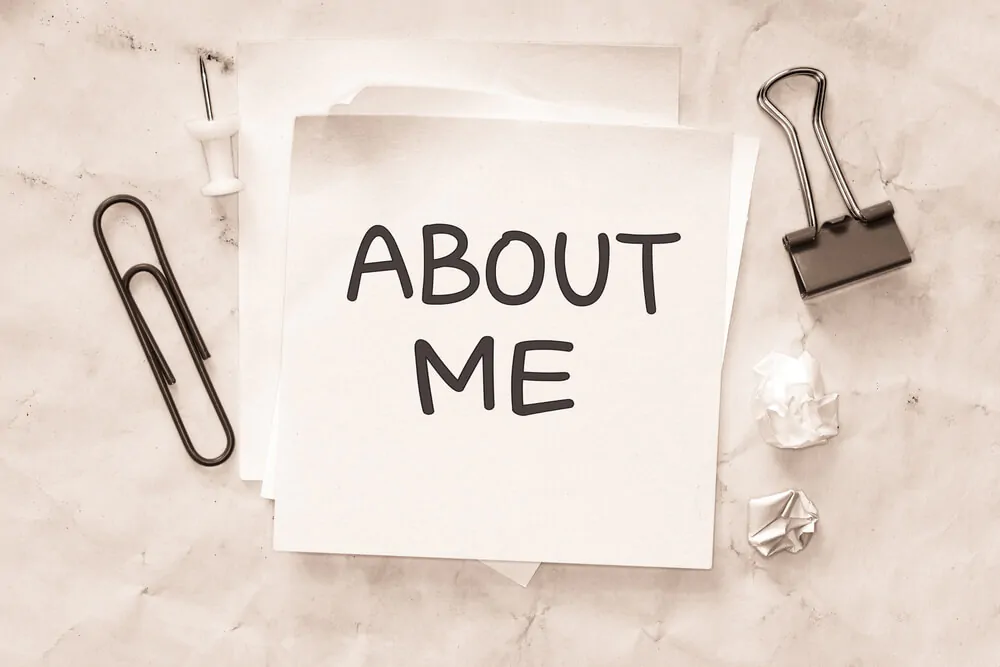
Many people have discussed the importance of being yourself, but what exactly does this mean? Identify and describe the impact of being authentically yourself. This could include not caring what others think of your style of hair or clothes, embracing your quirks, and not shying away from standing out in a crowd. Include your personal experiences for an engaging and convincing essay.
Your past experiences shape your authentic self. For your essay, you can write about a specific event you feel was monumental in making you who you are today. Then, retell the story of the event, complete with its causes and effects.
Reflect on a time when you feel you expressed yourself best. It may be a time when you showcased one of your skills or hobbies or a time when you feel you expressed your feelings most authentically. As with the previous prompt, you are telling readers your story, so be sure to explain the event in detail.
Despite the growing calls for people to be more confident in themselves, many are still afraid of being their authentic selves, especially in public or on social media. In your essay, explore possible reasons for people’s hesitancy to be themselves, citing credible sources to support your points.
Think back to a time when you were proud of yourself. Describe the situation from winning a competition to learning something new to scoring well on a test. How did it make you feel- happy, relieved, or confident? The possibilities are endless! Describe in detail how this achievement made you feel and how it has impacted the person you are today.
To truly be yourself, you must embrace all your flaws and fears. Describe one negative trait you previously had, and explain how you overcame or subdued this flaw. You can also write about a flaw you currently have and explain how you plan to get rid of it.
If you’d like to learn more, check out our guide on how to write an argumentative essay .
For more information, check out our top essay writing tips !

Martin is an avid writer specializing in editing and proofreading. He also enjoys literary analysis and writing about food and travel.
View all posts
- Applying For Scholarships
How to Write a College Essay About Yourself
David Sep 30, 2020
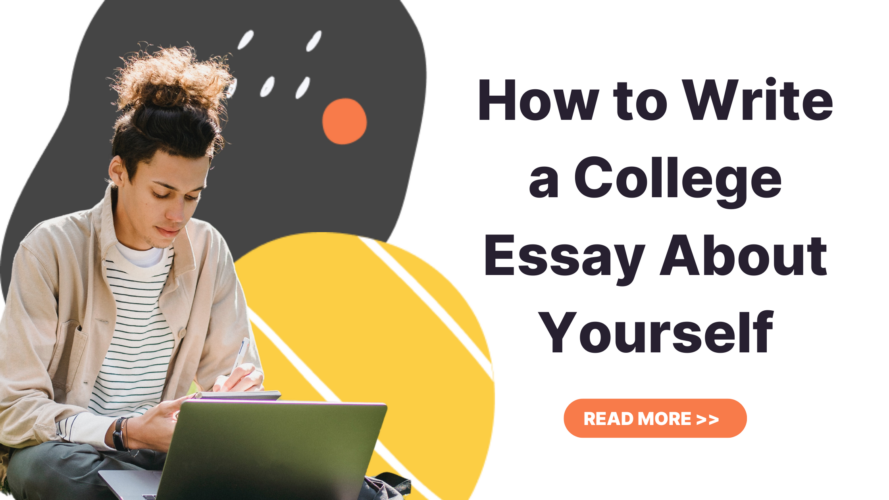
Get our best scholarship practices, insights & tips delivered to your inbox
Thank you for subscribing!
The scholarship you’re applying to requires that you write an essay about yourself. Easy peasy, how hard could it be? After all, you’ve been living with yourself for the last 17+ years! You know yourself better than anybody. You open your computer to start typing but your mind goes blank. Everything that you know about yourself suddenly seems unworthy of a $5,000 scholarship.
What in the world can you write about that will spark enough interest in the scholarship committee? Before you start panicking, check out our step-by-step guide on how to write a college essay about yourself.
Step 1: Brainstorm
The first way to tackle any scholarship essay prompt is to start with some thinking. We highly suggest that you take time before starting to write to brainstorm the essay prompt. This will not only get your creativity flowing, but your essay will be more organized and cohesive.
Brainstorm Ideas
To start brainstorming, sit down in a quiet space with a pen and paper. Think about your background, your family life, your family’s financial state, your academic history, your childhood, your education, sports you play, and anything else about yourself that makes you who you are. If you’re stuck, strike up a conversation with your parents or friends about yourself to get you rolling. Jot notes about yourself down on the paper.
The fastest path to earning scholarships
Simplify and focus your application process with the one-stop platform for vetted scholarships.
Now, it’s time to take the facts you’ve written about yourself and dig deeper. The goal of your scholarship essay is to tell a story about yourself that will convince the scholarship committee that you deserve to win. How can you turn facts about yourself into a compelling story? What information can you provide about yourself that will broadcast your character?
It helps to think about who your audience is. To do this, get to know the scholarship organization better! Visit their website and read their ‘about’ section. What do they stand for? What kind of students do they award?
Your audience might be interested in how much you studied to get your 3.8 GPA. Your GPA and test scores may have helped get you into college, but they might not be enough to win you scholarship money. Thousands of students have near to perfect GPAs, and writing about it can be a bit dry.
Your audience wants to read about the challenges you’ve faced along the way or meaningful experiences you’ve had. Did you have to watch a younger sibling every day after school because your parents were at work? Have you experienced mental health challenges or learning disabilities that have made studying hard for you? How did you decide that you wanted to study business in college? This is what we mean when we say to dig deep. Go past the surface level. Talk about the experiences you have had that have gotten you to where you are today.
Step 2: What to Include in an Essay About Yourself
A scholarship essay about yourself is obviously very broad. You can take your essay in many directions. Remember, you want to provide information about yourself that makes your essay worth reading. Including facts about yourself in your essay is fine. But, you better be seasoning those facts with a lot of flavors.
Here are some ideas to include in your essay.
Topics You Can Address in Your Essay
There are plenty of ways you can talk about yourself in your essay. Remember, your essay must focus on yourself and your personal experiences in life. You can choose one or two of the following topics as the basis of your essay.
- Experiences that have inspired your degree choice.
- Challenges you’ve faced that have impacted your life and education.
- Unique hobbies you have or the sports you play.
- How you’ve changed over the years.
- Your experiences in school.
- Professional goals you have for the future.
- Your achievements.
- Special relationships that have inspired you. If you choose this topic, remember the essay still needs to focus on you.
The topic you choose to write about should be one that you can connect back to your education or career goals. If it didn’t impact your education or career in some way, it’s likely not relevant for the scholarship.
Remember, you need to talk about the why and the how. For example, why are you pursuing a degree in law? Why did you choose this degree path? How will a law degree help you in your future? How have past experiences led you to dream of becoming a lawyer?
Step 3: Sketch an Outline
Now that you have an idea of what you’ll write about it, it’s time to get organized. Creating an outline is your final step before starting to write. Choose one or two of the topics we suggested and start breaking down what you’ll write about in each paragraph. Your essay should consist of an introduction, 3-5 body paragraphs, and a conclusion.
Check out our tips on what you should and shouldn’t include in your essay:
- Impress from the start of your essay.
- Place yourself in the reader’s shoes. Do you show enough of your personality in your essay? Do you convince the reader that you deserve to win?
- Do your research and learn about the organization. Try and connect yourself to their initiatives. Do you have a hobby or goal that matches the organization? What can you bring to the organization?
- Only include relevant information. If something seems unnecessary or out of place, it probably is.
- Write in the first person, this is about you after all.
- Give specific examples. Don’t say you struggled during freshman year, instead, show what that struggle looked like.
- Show off your strengths and achievements.
- Make your essay interesting! If it doesn’t captivate your audience from the start, it’s not good enough.
- Proofread and edit your essay. Those little spelling mistakes can cost you the scholarship. They are distracting and they don’t do a good job at convincing the reader that you’re professional. Everybody makes mistakes but it’s on you to check your work before submitting.
- Use the correct format .
- Write about academic weaknesses in your transcripts. This is your chance to take responsibility for the ‘D’ you received during freshman year algebra. You might write about your struggles with algebra and how you were motivated to improve by getting a tutor. Definitely do not play the victim card by blaming a teacher!
- Making mistakes is human! Write about what you learned from your mistakes and how they have made you stronger.
- Be authentic- write how you speak (of course, with correct grammar). Trying to impress with big words from the thesaurus isn’t as impressive as you think.
- Follow the essay instructions! You can write the best essay but if you don’t follow instructions, you risk being disqualified.
- Lie- Making up stories to win over the scholarship judges isn’t going to win over anybody! Lies scream inauthenticity. Trust us, it’s obvious when students lie and scholarship judges aren’t impressed.
- Brag- If you think that bragging about your 4.0 GPA is going to win you scholarship money, you’re wrong. Show off your confidence in a way that doesn’t come across as overbearing and arrogant.
- Use the essay as an opportunity to divulge your deepest darkest family secrets. This is not the place to cry your heart out or disclose personal information.
- Be vague about your professional goals. What sounds better, awarding a student with clearly defined goals or a student who doesn’t know what they want to do in life?
- Repeat the same information over and over again. You will have your readers yawning!
- Use cliches. Cliches are overused! Be bold and different.
Step 4: How to Start an Essay About Yourself
As with all scholarship essays, your essay about yourself should captivate readers from the very beginning. Start your essay with a creative introduction that will make the readers want to continue reading your essay. You may choose to start with a personal story or experience.
Avoid using cliches such as “from a young age” or “for as long as I can remember.” Also, avoid using quotes. These are other peoples’ words, not your own.
At the end of your introduction paragraph, you should have a thesis statement that makes it clear to the reader why you are applying for the scholarship. They should be able to taste your enthusiasm and understand your motivation for applying.
How to Start an Essay About Yourself Example
When it comes to my passion for teaching others, you might say I wasn’t given much of a choice in life. As the older sister of four, it was my responsibility to lead the way and teach my two younger brothers and sister. At least, I assumed that responsibility. I helped them with everything from school projects to packing for camp in the summer. It’s no surprise to me that years later, I have chosen to pursue a bachelor’s degree in Education at the University of Texas in the fall. With this scholarship, I will be able to pursue my degree in education and return to my hometown to teach in a local elementary school after graduating.
Step 5: What to Include in Your Body Paragraphs
Your body paragraphs are the meat of your scholarship essay. This is where the scholarship readers really get to know you. Your body paragraphs should each contain an argument with supporting details and examples.
Your job in these paragraphs is to bring your personality out as much as possible. You also want to connect your arguments with your educational and career goals, and of course, to the scholarship you’re applying for. Make sure you relay to the reader how the scholarship will help you fulfill your goals.
How to Write a College Essay About Yourself Body Paragraphs Example
My role as a teacher to my little brothers and sister was only the start of it. As soon as I was of appropriate age, I started babysitting my neighbors on the weekends to earn extra money. Sure, that meant sacrificing my weekend nights with friends, but I was able to save up quite a lot of money from my Friday night and Saturday night gigs. For me, it was never only about the money. I loved spending time with the little kids. I would come up with fun activities to do with them, like “restaurant night,” where we would create menus and whip up ice cream sundaes in the kitchen.
By high school, it was clear to me that I wanted to be a teacher. I took several classes in high school that confirmed this dream of mine. I particularly enjoyed my early childhood education class where I learned theories in childhood development, classroom management techniques, and about developing curriculum. I even started to write up my own curriculum and made my younger siblings be in “school,” with me as their teacher. I don’t think they were too happy about all those extra hours of school…
Over the last year, I completed an internship as a teacher’s assistant. Every Tuesday and Thursday I spent half the day working with a 3rd-grade teacher at the local elementary school. I learned so much from this experience, like how to manage behavior problems and how to encourage shy students to participate in lessons. I can’t wait to come back to my hometown and work as a teacher after college.
Step 6: How to End an Essay About Yourself
By the time you get to writing your concluding paragraph, you may feel an urge to finish up your essay quickly. But, your concluding paragraph is also important in making that final last impression. Don’t rush through it.
Your concluding paragraph should wrap up your essay while giving an overview of the main points of your essay. You should do the following in your concluding sentence:
- Restate your thesis in other words.
- Give an overview of the arguments you made in your body paragraphs.
- End your concluding paragraph with a big thought related to your future.
How to End an Essay About Yourself Example
You might say that my upbringing made me who I am today, but I think it’s a lot more than that. I wouldn’t have the confidence I have today in myself and in my future goals if it weren’t for my studies and jobs throughout high school. I am so excited to start my degree at the University of Texas and keep developing the tools and skills I need to become the best teacher I can be.
Step 7: The full Example of How to Write a College Essay About Yourself
Now that you have learned how to write a solid introduction, conclusion, and body paragraphs, it’s time to put it all together. Here is the full example:
Final Thoughts
The “Tell Us About Yourself” scholarship essay prompt might feel frustrating. It can feel intimidating but it’s really not so bad once you know how to tackle it.
Use these tips and you’ll be good to go. Time to start writing!
- Applications
- essay applications
- scholarship applications
- Scholarship Essay
- writing scholarship
- writing tips

David Tabachnikov is the CEO of ScholarshipOwl. Formerly at Waze and Google, David is an experienced CTO/R&D manager with over 10 years of experience of leading tech teams. David fervently believes that students should have greater access to education, and is passionate about using technology to help them achieve that goal.
Related Stories View All

Popular Application Essay Topics

The 7 Most Common Ways to Lose Your Scholarship

Get College Scholarships Without Having to Write an Essay
Get started with scholarshipowl.
Simplify and focus your application process with the one-stop platform for vetted scholarships
How to Write an Essay About Yourself With Tips and Examples
22 December 2023
last updated
Essays are essential in demonstrating student’s proficiency in writing academic texts. Basically, this proficiency includes writing creatively and without notable mistakes and errors. By considering writing essays about themselves, students should follow the same approach that they use when writing other types of essays, including research papers. In essence, authors should focus on preparation, stage set up, writing process, and perfecting their compositions. Also, these steps are essential in ensuring the writer’s essay is of high quality. In turn, these essays on yourself do not rely on external research to strengthen the main arguments. On the other hand, papers rely on personal anecdotes to make them authentic and original. Hence, a student needs to learn how to write an essay about yourself.
General Guidelines of Writing an Essay About Yourself
Essay writing is one of the activities that students engage in to develop their creative writing skills. Unlike a research paper , an essay that a student writes about yourself does not rely on external research. Basically, one can argue that this type of article is exploratory. Also, it explores the writer’s life across different settings, such as school life, home life, and social life. While such essays may differ from a research essay in content, it follows the same structure: introduction, body, and conclusion. Then, a research paper utilizes external research to make it relevant, but a personal essay that a student writes about yourself uses personal anecdotes to create relevance. In other words, since such a piece explores the student’s life, it is only prudent for a person to include one or several stories that give readers a glimpse into their personality.
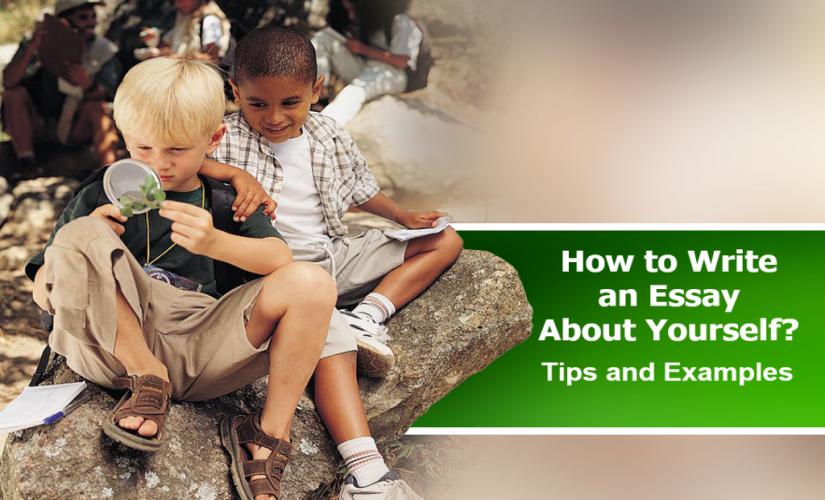
Writing an Essay About Yourself: A Step-by-Step Guide
The strategy of writing academic texts is almost the same, regardless of the kind of the type of text. In short, whether academic writing involves a research essay, report, thesis paper , dissertation , or personal story, writers must engage in some activities, which are similar across these types of papers . Basically, these activities include preparation, stage set up, writing process, and wrap up of the writing process.
Step 1: Preparation
Preparation is the first step in writing an essay of any type. Basically, this stage has several components, including defining the topic, preparing ideas, and considering the audience. Concerning the topic, a person who writes about yourself can use the instructor’s theme or choose one if none is provided. In the latter case, authors should settle for a topic that interests them, one that they can find information to back up claims and arguments easily. When it comes to writing all about me essay, students should choose topics that allow them to capture a broad perspective about their lives. On preparation of ideas, students need to reflect on their lives, including positive and negative experiences and strengths and weaknesses. About the audience, they should write with expectations of instructors in mind.
Step 2: Setting Up the Stage
After preparation, the next step in academic paper writing is to set up the stage. Basically, components of this step include making notes, creating an essay outline , and creating an annotated bibliography. When writing an essay about yourself, a student should make notes when reflecting on your own experiences. In this case, a personal anecdote comes into play. Then, authors should use a personal account, highlighting a positive or negative experience and areas of strength or weakness. When it comes to creating an outline, students should use academic standards of essay outlines – introduction, body, and conclusion. Although it is unnecessary to write down these headings, authors must ensure that those reading all about me essays can identify where each of these sections begins and ends. In turn, there is no need for an annotated bibliography since no external research is required.
Step 3: Writing Process
After preparing and setting up the stage, students start writing their essays about themselves. Basically, components of this step include making the first draft, ensuring the paper captures everything that authors intend to write about, has a thesis statement , and captures the writer’s concluding thoughts. In this case, first drafts are essential because it allows writers to have an opportunity to perfect their papers through revisions and editions. Then, the thesis statement is the writer’s guide. Besides, it dictates what authors should focus on in body paragraphs. In turn, concluding thoughts are the writer’s words that summarize lessons learned. Hence, each of these components is essential in an essay about yourself.
Step 4: Wrapping Up
After writing the first draft, students begin to write the final draft. But before they start, they should read and reread the first draft to ensure it is free of any grammatical mistakes and other writing errors, such as inconsistent arguments and illogical flow of ideas. For example, if writers identify such mistakes and errors, they should revise and edit an essay about yourself accordingly. In turn, revisions help authors to eliminate inconsistencies in arguments and illogical flow of ideas, while editions help them to fix grammatical mistakes, such as a lack of punctuation or wrong use.
Use exceptional writing services that guarantee original and well-researched papers.
Main Features of Writing All About Me Essay
1️⃣ topic and concluding sentences.
When writing an essay about themselves, students should begin each body paragraph as they would in any other article – start with a topic sentence. Basically, this sentence captures a single idea that writers interrogate in a particular section, meaning that it offers an insight into the paragraph’s content. On the other hand, a concluding sentence is final thoughts about what writers have said in a specific section. Then, rules of academic writing dictate that the concluding sentence links the topic sentence with the thesis statement. In other words, it is the part of a single paragraph that creates sense for readers regarding the topic sentence and its place in the writer’s main argument.
2️⃣ Transition, Peer Review, and Final Draft
Students need to ensure that, as they write an essay about themselves, they create a logical flow of ideas from the beginning paragraph to the end. Basically, such elements may be transition words, like “consequently,” “furthermore,” “nevertheless,” and “hence.” To ensure that students do not miss identifying errors in their essays, they should subject their work to a peer review. For example, this aspect involves giving the first draft to a mentor who reads through it to make sure it is perfect. When mentors are satisfied with the paper’s quality, students start writing the final draft. However, they should also read through it at least twice and subject it to peer review before submitting it to a specific department.
3️⃣ Specific Information
As indicated, writing an essay about yourself differs from a research paper because it does not rely on external research to back up claims and arguments. Instead, writers utilize a personal story to shed light on their experiences and attributes. In this sense, such personal anecdotes are the specific information necessary for an essay about yourself. Moreover, this information is specific to a person provided through reflective writing. Hence, a personal essay that a student writes, which is about yourself, should be exploratory, descriptive, and thoughtful.
Common Mistakes
Like any other academic text, writing an essay about oneself is often prone to mistakes. For example, some of the common mistakes that writers or students make when writing an essay about yourself include writing about things that do not help readers to have a proper grasp of their personality and using exaggeration. Basically, writing an essay about yourself should enhance the readers’ understanding of authors – their life experiences, attributes, likes and dislikes, and strengths and weaknesses. In turn, exaggeration involves using information that is likely to be untrue to impress readers. To solve the first mistake, writers need to focus on personal anecdotes, as they help to highlight instances of the author’s life that is worth noting. To avoid exaggeration, students should desist from trying to impress and seek to be authentic in their writing.
Example of Writing an Essay About Yourself
My First Year of School by Zac
I walked into the classroom, shaking in terror. The class was full of howler monkeys, but I was not with howler monkeys. I was with a bunch of five and six-year-old kids. I acted as if I was watching a horror movie until I met the super lovely Mr. Keig. Mr. Keig was the best teacher in the universe.
Mr. Keig was like a giant to us, and he still is. At first, I was scared of Mr. Keig, but I found out he was super friendly. He taught me how to read and write. Add and subtract. He even taught me how to make school fun. At the beginning of school, I was horrified by math and reading. I was soon shown that those subjects were not formidable opponents, but I had yet to meet my match.
Writing. I hated writing. I had met my match, my enemy, my formidable opponent. The reason I hated writing was that I wrote slowly. It took too long for me to write, and I was always the last one to finish my newest story. It was also ever boring for me. It was hard to find inspiration or the urge to take a step up. Math and reading, on the other hand, I sped through like Speed Racer. I was still shy, and I only had a few friends in the first couple of weeks of kindergarten. I figured out making friends was not a piece of cake. I eventually made friends. Thank God that problem was over.
Even though we got to play and create our own art, sometimes, school days were dull. Sometimes days felt like they were two million years long. There were other times when I was terrified about a test, and it seemed like the paper was laughing at me, and my pencil was dodging my paper. I was sweating, shaking, and FREAKIN’ out. I eventually pulled it together and got my test done. Relieved, relaxed, and incredibly calmed down. Tranquil and thrilled I was. It felt like I was soaring through the sky a million miles per minute.
What I learned from my year in kindergarten was to face your fears. If you are scared, don’t run away from your worries. Another lesson I learned was not to judge a book by its cover. I assumed the school was going to be extremely hard, and tests were going to be impossible. I assumed wrong. The school (kindergarten) was not as hard as I thought it was going to be. While kindergarten was a bit challenging, I knew I could succeed if I set my mind to it and work hard.
Summing Up on How to Write an Essay About Yourself
Essay writing is an essential activity in a student’s life, as it exposes one to the dynamics of creative writing. When writing such an essay, authors learn how to use personal stories to highlight their positive and negative experiences, including strengths and weaknesses. In essence, such stories replace external evidence that writers use in research essays. Then, the guide to effective writing of such an essay includes several components, including preparation, stage set up, starting the writing process, and wrapping it up. Also, these aspects of writing an essay about yourself allow a person to build own thoughts, organize papers, and perfect academic texts. As a result, perfection involves revising any inconsistent ideas and illogical arguments and revising any grammatical mistakes, such as punctuation errors.
When writing an essay about yourself, a student should master the following tips:
- Be thoughtful, but not fretful. Writers should, through reflection, highlight areas of their lives that provide an insight into their personality. In this case, they should do it without fear of what readers might think about them.
- Keep an essay personal. The majority of the essay’s information should be about an author. For example, such elements involve talking about life experiences, attributes, strengths, and weaknesses. In turn, the use of personal anecdotes is essential in achieving this goal.
- Do not guess what readers want to hear. Students should not seek to impress readers, but they need to inform them.
- Feel free to be creative. Without exaggeration, authors should use personal stories creatively to keep readers interested in essays.
- Tell readers something that they do not already know. The best way to keep readers interested is to use stories that writers have probably never shared publicly. In turn, such stories or experiences inject all about me essays with an aspect of amazement.
- Ask for input from close ones. Students can ask parents, friends, mentors, counselors, coaches, and teachers to provide ideas, as they know about personally.
- Polish a paper about yourself. Essays should not be about the writer’s story only. In turn, it should demonstrate the writer’s proficiency in writing by lacking grammatical mistakes and other notable errors.
To Learn More, Read Relevant Articles
How to start an essay with a quote with examples, how to title an essay: basic guidelines with examples.
Have a language expert improve your writing
Run a free plagiarism check in 10 minutes, generate accurate citations for free.
- Knowledge Base
- How to write an essay introduction | 4 steps & examples
How to Write an Essay Introduction | 4 Steps & Examples
Published on February 4, 2019 by Shona McCombes . Revised on July 23, 2023.
A good introduction paragraph is an essential part of any academic essay . It sets up your argument and tells the reader what to expect.
The main goals of an introduction are to:
- Catch your reader’s attention.
- Give background on your topic.
- Present your thesis statement —the central point of your essay.
This introduction example is taken from our interactive essay example on the history of Braille.
The invention of Braille was a major turning point in the history of disability. The writing system of raised dots used by visually impaired people was developed by Louis Braille in nineteenth-century France. In a society that did not value disabled people in general, blindness was particularly stigmatized, and lack of access to reading and writing was a significant barrier to social participation. The idea of tactile reading was not entirely new, but existing methods based on sighted systems were difficult to learn and use. As the first writing system designed for blind people’s needs, Braille was a groundbreaking new accessibility tool. It not only provided practical benefits, but also helped change the cultural status of blindness. This essay begins by discussing the situation of blind people in nineteenth-century Europe. It then describes the invention of Braille and the gradual process of its acceptance within blind education. Subsequently, it explores the wide-ranging effects of this invention on blind people’s social and cultural lives.
Instantly correct all language mistakes in your text
Upload your document to correct all your mistakes in minutes

Table of contents
Step 1: hook your reader, step 2: give background information, step 3: present your thesis statement, step 4: map your essay’s structure, step 5: check and revise, more examples of essay introductions, other interesting articles, frequently asked questions about the essay introduction.
Your first sentence sets the tone for the whole essay, so spend some time on writing an effective hook.
Avoid long, dense sentences—start with something clear, concise and catchy that will spark your reader’s curiosity.
The hook should lead the reader into your essay, giving a sense of the topic you’re writing about and why it’s interesting. Avoid overly broad claims or plain statements of fact.
Examples: Writing a good hook
Take a look at these examples of weak hooks and learn how to improve them.
- Braille was an extremely important invention.
- The invention of Braille was a major turning point in the history of disability.
The first sentence is a dry fact; the second sentence is more interesting, making a bold claim about exactly why the topic is important.
- The internet is defined as “a global computer network providing a variety of information and communication facilities.”
- The spread of the internet has had a world-changing effect, not least on the world of education.
Avoid using a dictionary definition as your hook, especially if it’s an obvious term that everyone knows. The improved example here is still broad, but it gives us a much clearer sense of what the essay will be about.
- Mary Shelley’s Frankenstein is a famous book from the nineteenth century.
- Mary Shelley’s Frankenstein is often read as a crude cautionary tale about the dangers of scientific advancement.
Instead of just stating a fact that the reader already knows, the improved hook here tells us about the mainstream interpretation of the book, implying that this essay will offer a different interpretation.
Prevent plagiarism. Run a free check.
Next, give your reader the context they need to understand your topic and argument. Depending on the subject of your essay, this might include:
- Historical, geographical, or social context
- An outline of the debate you’re addressing
- A summary of relevant theories or research about the topic
- Definitions of key terms
The information here should be broad but clearly focused and relevant to your argument. Don’t give too much detail—you can mention points that you will return to later, but save your evidence and interpretation for the main body of the essay.
How much space you need for background depends on your topic and the scope of your essay. In our Braille example, we take a few sentences to introduce the topic and sketch the social context that the essay will address:
Now it’s time to narrow your focus and show exactly what you want to say about the topic. This is your thesis statement —a sentence or two that sums up your overall argument.
This is the most important part of your introduction. A good thesis isn’t just a statement of fact, but a claim that requires evidence and explanation.
The goal is to clearly convey your own position in a debate or your central point about a topic.
Particularly in longer essays, it’s helpful to end the introduction by signposting what will be covered in each part. Keep it concise and give your reader a clear sense of the direction your argument will take.
As you research and write, your argument might change focus or direction as you learn more.
For this reason, it’s often a good idea to wait until later in the writing process before you write the introduction paragraph—it can even be the very last thing you write.
When you’ve finished writing the essay body and conclusion , you should return to the introduction and check that it matches the content of the essay.
It’s especially important to make sure your thesis statement accurately represents what you do in the essay. If your argument has gone in a different direction than planned, tweak your thesis statement to match what you actually say.
To polish your writing, you can use something like a paraphrasing tool .
You can use the checklist below to make sure your introduction does everything it’s supposed to.
Checklist: Essay introduction
My first sentence is engaging and relevant.
I have introduced the topic with necessary background information.
I have defined any important terms.
My thesis statement clearly presents my main point or argument.
Everything in the introduction is relevant to the main body of the essay.
You have a strong introduction - now make sure the rest of your essay is just as good.
- Argumentative
- Literary analysis
This introduction to an argumentative essay sets up the debate about the internet and education, and then clearly states the position the essay will argue for.
The spread of the internet has had a world-changing effect, not least on the world of education. The use of the internet in academic contexts is on the rise, and its role in learning is hotly debated. For many teachers who did not grow up with this technology, its effects seem alarming and potentially harmful. This concern, while understandable, is misguided. The negatives of internet use are outweighed by its critical benefits for students and educators—as a uniquely comprehensive and accessible information source; a means of exposure to and engagement with different perspectives; and a highly flexible learning environment.
This introduction to a short expository essay leads into the topic (the invention of the printing press) and states the main point the essay will explain (the effect of this invention on European society).
In many ways, the invention of the printing press marked the end of the Middle Ages. The medieval period in Europe is often remembered as a time of intellectual and political stagnation. Prior to the Renaissance, the average person had very limited access to books and was unlikely to be literate. The invention of the printing press in the 15th century allowed for much less restricted circulation of information in Europe, paving the way for the Reformation.
This introduction to a literary analysis essay , about Mary Shelley’s Frankenstein , starts by describing a simplistic popular view of the story, and then states how the author will give a more complex analysis of the text’s literary devices.
Mary Shelley’s Frankenstein is often read as a crude cautionary tale. Arguably the first science fiction novel, its plot can be read as a warning about the dangers of scientific advancement unrestrained by ethical considerations. In this reading, and in popular culture representations of the character as a “mad scientist”, Victor Frankenstein represents the callous, arrogant ambition of modern science. However, far from providing a stable image of the character, Shelley uses shifting narrative perspectives to gradually transform our impression of Frankenstein, portraying him in an increasingly negative light as the novel goes on. While he initially appears to be a naive but sympathetic idealist, after the creature’s narrative Frankenstein begins to resemble—even in his own telling—the thoughtlessly cruel figure the creature represents him as.
If you want to know more about AI tools , college essays , or fallacies make sure to check out some of our other articles with explanations and examples or go directly to our tools!
- Ad hominem fallacy
- Post hoc fallacy
- Appeal to authority fallacy
- False cause fallacy
- Sunk cost fallacy
College essays
- Choosing Essay Topic
- Write a College Essay
- Write a Diversity Essay
- College Essay Format & Structure
- Comparing and Contrasting in an Essay
(AI) Tools
- Grammar Checker
- Paraphrasing Tool
- Text Summarizer
- AI Detector
- Plagiarism Checker
- Citation Generator
Your essay introduction should include three main things, in this order:
- An opening hook to catch the reader’s attention.
- Relevant background information that the reader needs to know.
- A thesis statement that presents your main point or argument.
The length of each part depends on the length and complexity of your essay .
The “hook” is the first sentence of your essay introduction . It should lead the reader into your essay, giving a sense of why it’s interesting.
To write a good hook, avoid overly broad statements or long, dense sentences. Try to start with something clear, concise and catchy that will spark your reader’s curiosity.
A thesis statement is a sentence that sums up the central point of your paper or essay . Everything else you write should relate to this key idea.
The thesis statement is essential in any academic essay or research paper for two main reasons:
- It gives your writing direction and focus.
- It gives the reader a concise summary of your main point.
Without a clear thesis statement, an essay can end up rambling and unfocused, leaving your reader unsure of exactly what you want to say.
The structure of an essay is divided into an introduction that presents your topic and thesis statement , a body containing your in-depth analysis and arguments, and a conclusion wrapping up your ideas.
The structure of the body is flexible, but you should always spend some time thinking about how you can organize your essay to best serve your ideas.
Cite this Scribbr article
If you want to cite this source, you can copy and paste the citation or click the “Cite this Scribbr article” button to automatically add the citation to our free Citation Generator.
McCombes, S. (2023, July 23). How to Write an Essay Introduction | 4 Steps & Examples. Scribbr. Retrieved March 11, 2024, from https://www.scribbr.com/academic-essay/introduction/
Is this article helpful?
Shona McCombes
Other students also liked, how to write a thesis statement | 4 steps & examples, academic paragraph structure | step-by-step guide & examples, how to conclude an essay | interactive example, what is your plagiarism score.

Mention your extracurricular activities or awards in passing, not outright, to avoid sounding like you're bragging from a resume. Bad example. I am the captain of my varsity football team. Good example. I peel off my varsity basketball uniform and jump into the shower to wash away my sweat, exhaustion, and anxiety.
Start brainstorming topics that are connected to that idea, to give yourself a variety of options to choose from. 3. Write about complex topics, not cliches. An essay does not need to make you look good, so much as how well you communicate the event.
While "I" and "we" are both in the first person, "you" is used in the second person. Remember this rule, and you'll come up with an interesting essay or even a short story about yourself. You may even want to consider becoming a novel writer in the future after doing it. 3. Stick with "he," "she," "it," and "they".
We don't get the same depth with the first example. 6. Don't be afraid to show off…. You should always put your best foot forward—the whole point of your essay is to market yourself to colleges. This isn't the time to be shy about your accomplishments, skills, or qualities. 7. …. While also maintaining humility.
How to write about yourself: Become a better writer by journaling. It's good to write more, period. Different types of writing help you know your audience + hone your voice accordingly. Good personal writing is vulnerable. 1. Become a better writer by journaling. Journaling has been shown to help manage anxiety and reduce stress —both ...
Writing about yourself can be one of the hardest things that you have to do, whether you're writing a personal essay for a school project or for admission to a college or university. There are a lot of things to take into consideration when writing a personal essay, from which details are the most intriguing to potential readers to developing ...
5. Write in the First Person. You're telling your story, so write from your perspective! You can narrate your story. You can provide an overview of what you learned from your experiences. However you choose to answer the prompt, we recommend writing in an active tone, and using "I" and "me" throughout your essay. 6.
Step 3: Organize your answers. After asking yourself the example questions above as well as others, you should be sure to write down your answers and begin organizing them if you haven't already. It may be tempting to just answer your own questions in your head as you go—but don't.
The key is to create a good hook to draw readers into your narrative right away. Once you get into the body paragraphs, keep the momentum going. Describe the feelings you had, the sights, smells, and sounds of your experience. Like the introduction to an essay about yourself, the conclusion can take many forms.
In professional settings and applications, you want to focus on four elements as you write about yourself: relevant experience. recent professional accomplishments. personal details that enhance your qualifications. specializations. Again, keep your purpose and audience in mind. If you're having trouble narrowing down your relevant experience ...
Learn how to write the perfect essay about yourself here. You either love to talk about yourself or hate it, but one thing is for sure: Writing about yourself in essay form is hard for anyone. Dictionary
Using the questions above, pick an incident or some strong point about yourself to elucidate. Remember that you must write about a single incident or quality that makes you stand out. Avoid talking about two qualities or two incidents. 3. Define the Goal. Read the essay guidelines and align your writing with that.
Step 1. Plan the word count for each paragraph. Planning the word count for each paragraph will be much easier when you know the exact number of words you need for an essay. It will help you organize your ideas and present them clearly and concisely. The introductory paragraph (introduction). Three body paragraphs.
2. Make it Personal using Anecdotes. The difference between a good and great essay about yourself is the use of personal anecdotes. You want your essay to stand out because it's thoughtful and unique. Anyone can tell a story of who they are. Anyone can say: "Here's who I am and here's what's good about me.".
Use a casual and friendly tone. 1. Develop a strong introduction. A concise, informative self-introduction can immediately interest the reader and make them more likely to continue reading the rest of your document. Write a short statement that accurately describes your skills and qualifications.
Here are some tips to get you started. Start early. Do not leave it until the last minute. Give yourself time when you don't have other homework or extracurriculars hanging over your head to ...
58. Write about what you wish more people knew about your chosen job/career. 59. Write about an external struggle that's been wearing on you lately. 60. Write about an internal struggle that's been distracting you and wearing you down. 61. Describe something you love — or don't love — about the people in your country.
For your essay, you can write about a specific event you feel was monumental in making you who you are today. Then, retell the story of the event, complete with its causes and effects. 3. Being Unopollogetically Myself. Reflect on a time when you feel you expressed yourself best.
Step 4: How to Start an Essay About Yourself. As with all scholarship essays, your essay about yourself should captivate readers from the very beginning. Start your essay with a creative introduction that will make the readers want to continue reading your essay. You may choose to start with a personal story or experience.
This is also where you establish the tone for your essay. 3. Organize your ideas. structure your personal essay with a clear intro, a body, and a conclusion. Make sure your ideas are organized logically and use transitions to link different parts of your narrative. 4.
2️⃣ Transition, Peer Review, and Final Draft. Students need to ensure that, as they write an essay about themselves, they create a logical flow of ideas from the beginning paragraph to the end. Basically, such elements may be transition words, like "consequently," "furthermore," "nevertheless," and "hence.".
2. Mention your relevant professional experience. The middle portion of your personal document should detail your relevant professional experience. Tailor this to your purpose. If you are writing a cover letter, review the job description and company website to select the most relevant experience.
Step 1: Hook your reader. Step 2: Give background information. Step 3: Present your thesis statement. Step 4: Map your essay's structure. Step 5: Check and revise. More examples of essay introductions. Other interesting articles. Frequently asked questions about the essay introduction.
1 Set realistic goals. One of the first steps to improve your writing productivity is to set realistic and specific goals for your projects. Having a clear vision of what you want to achieve, how ...
- business plan
- course work
- research paper
90 Sunreef Power yacht honored with the Golden Crown in the category Discovery of the year on the Russian market
- Inspiration
Related News
Popular news this week, popular news this month, latest news.
- Yacht Charter & Superyacht News >
Written by Zuzana Bednarova
This image is featured as part of the article Sunreef Yachts to attend Moscow Boat Show for first time .

Please contact CharterWorld - the luxury yacht charter specialist - for more on superyacht news item "90 Sunreef Power yacht honored with the Golden Crown in the category Discovery of the year on the Russian market".
- Charity & Fund Raising
- CharterWorld News
- Classic Yachts
- Coronavirus
- Cruise Ship
- Ecological Yachts
- Expedition Yachts
- Expert Broker Advice
- Feature Superyachts
- Interior Design
- Legal & VAT Yacht Issues
- Luxury Catamarans
- Luxury Gulet
- Luxury Phinisi
- Luxury Trimarans
- Luxury Yacht Design
- Luxury Yachts
- Marinas & Harbours
- Marine Ecology
- Marine Electronics
- Marine Equipment
- Mega Yachts
- Modern Yachts
- Motor Yachts
- New Launch Yachts
- New To Charter
- Open Style Sports Yachts
- Private Jets
- Sailing Yachts
- Social Media
- Sports Yachts
- Superyacht Crew
- Superyacht Photographers
- Superyacht Products & Supplies
- Superyacht Refits
- Superyacht Reviews
- Superyachts
- Uncategorized
- Yacht Builders
- Yacht Charter
- Yacht Charter Destinations
- Yacht Charter Picks
- Yacht Charter Specials
- Yacht Delivered to Owner
- Yacht Designers
- Yacht Events & Boat Shows
- Yacht Fashion
- Yacht Industry News
- Yacht Photos
- Yacht Racing
- Yacht Racing & Regattas
- Yacht Safety Equipment
- Yacht Support Vessels
- Yacht Tenders
- Yacht Videos
- Yachting Associations
- Yachting Awards
- Yachting Business
- Yachts For Charter
- Yachts For Sale
Quick Enquiry
Superyacht news:.
Email Your Yachting News to: news @ charterworld.com

Sunreef Yachts’ international promotion and development

Upcoming Spring Boat Show Season for Sunreef Yachts

‘Discovery of the Year’ Award for 90 Sunreef Power Yacht at Luxury Lifestyle Awards

Sunreef Yachts strengthens its leading position as luxury catamaran builder in 2013

Ferretti Custom Line Navetta 30 series motor yacht GINDUNGO hits water in Italy

50m luxury motor yacht BEL1 launched in Pisa by Rossinavi

Luxury yacht UNIQUE S is brand new to the charter market in the Western Mediterranean

44m superyacht EXTRA TIME new to charter around the Western Mediterranean

Baglietto announces the launch of 41m luxury yacht ASTERA

Another great special offer on board 36m motor yacht CALYPSO I

Superyacht KISMET – the 122m Lurssen motor yacht the charter market has been waiting for

37m luxury yacht LEGEND offering unparalleled comfort on charters in the Western Mediterranean

Discover our Top 10 brand new yachts available for charter worldwide this year

Florida charter yacht REAL SUMMERTIME offering 10% discount

Looking ahead to the 2024 MYBA Charter Show in Genoa

Discover summer in New England aboard a luxury charter yacht: Escape to this beautiful northeast corner of the USA

Westport announce the first hull of their 36m W117 range is nearing completion

Last minute yacht charter deals in the Bahamas

49m sailing yacht ANIMA MARIS is offering discounted rates for the remaining summer weeks in Croatia

Take advantage of the exceptional 15% discount by 44m charter yacht BLISS in Greece
real learning for real life essay
- EssayBasics.com
- Pay For Essay
- Write My Essay
- Homework Writing Help
- Essay Editing Service
- Thesis Writing Help
- Write My College Essay
- Do My Essay
- Term Paper Writing Service
- Coursework Writing Service
- Write My Research Paper
- Assignment Writing Help
- Essay Writing Help
- Call Now! (USA) Login Order now
- EssayBasics.com Call Now! (USA) Order now
- Writing Guides
Real Learning Takes Place Through Experience (Essay Sample)
Table of Contents
Introduction
Formal or academic learning starts at preschool and continues even after college. But mostly, the hardest yet most valuable lessons can be had only through real-life experiences. Learning through experiences shapes us as a person. The idea of having to live with the consequences of one’s decision can be scary and daunting. But the way you will change and evolve is a continuous process that’s worth it.
If you need to write about learning through experiences, it is best to look up an essay writing service provider who could help bring your ideas to life.
Essay on Importance of Learning Through Experience
We oftentimes limit our understanding of learning as everything we process inside a classroom. The different fields or subjects studied in school are applied in real life, both theoretically and practically. Subjects such as science, mathematics, language and literature, and values education are also applicable in everyday life.
Armed with academic know-how, a student can use head knowledge in decision-making and troubleshooting scenarios.
However, people who are textbook-smart are quite different from those who are known to be street-smart. There is a difference between performing in a classroom setting and responding to actual situations.
Learning through experience and in the real world can sometimes be a matter of life or death, compared with theoretical dialogues held within the four walls of a school.
That being said, it is a proven fact that people who are college-educated are known to make wiser decisions as they are able to apply what they have learned in school.
Skills in logic and critical thinking that they gleaned in the process also come in handy.
Knowledge is Power
The more you know in life, the more wisdom you have in terms of making decisions in work or job applications and career development.
Strategic and organizational thinking also play important roles in the process of learning.
Applying What You Know
True knowledge is wisdom applied, and it must be done in the absence of any neglect or misuse.
Real learning through experience takes stock of previous experiences, gathering lessons, and learning to apply them honorably.
In life, there is always an opportunity to apply theories or theses that we bring with us from our academic education. The real test is not actually in the classroom but in the real world.
The Equally-Good Benefits of Academic Learning
Schools not only offer theories and concepts on how to survive different situations. They arm us with the techniques and skills necessary to be successful in life.
That being said, an academic education gives us an edge over other people who have not attained any degree in universities and colleges.
Education makes us smarter and tougher than the rest who have not been as fortunate to finish their schooling.
Advantages and Benefits of Life Experiences
Life experiences are treasures to learn from, as many of them are scenarios we don’t usually study about in school. At the same time, most of us make mistakes in life. Through these wrong decisions, we learn to glean lessons that we take with us moving forward.
Good or bad, life experiences can either strengthen and toughen us up or scar us for life.
The Value of Our Response
Some people are wise and humble enough to turn a negative experience into an opportunity to grow and become better. In addition, these experiences become a permanent part of our personal history.
If we respond positively, the changes we experience could help us journey with other people who go through something similar.
Learning Experiences Are Varied
There are many types of learning experiences and some of those may represent failure or weakness, causing us to sometimes be hard on ourselves.
But we have the power to change our perspective and choose to move forward with hope and optimism in the face of a bad experience.
Trauma and Becoming Better People
Healing from a traumatic experience can be tough and tedious, but when the inner work is done well, the result always benefits the person and his community.
In this light, harsh experiences are still worth going through just as much as a near-perfect experience.
While we prefer the comfort of growth without pain, pain offers a unique voice in our stories and teaches us hard things.
Learning from Life is a Community Project
Life experiences are not solo journeys. As you learn from experience, others feel the impact. You will either be a bigger blessing to them or a heavier burden, depending on how you respond to the lesson.
Real-life experiences shape and mold us in a way that affirms our identity and purpose. This is why all life experiences outside the classroom are worth keeping and remembering.
Short 1 Minute Speech on the Importance of Learning Through Experience
The learning process of a person happens throughout the course of his life. Most commonly, we think of schools as the best place for this to happen. We don’t often consider the importance of learning through experience.
There is much to be said about how learning occurs in a classroom. You have a community of co-learners and a teacher to help aid your learning curve. But informal learning also offers unexpected benefits.
Active experimentation, reflective observation and self-reflection are three things that can happen when learning through experiences. In this scenario, a person is given the opportunity to connect mind, heart, and hands.
This results in a transforming experience that reading books, while important, may not always offer. With different outcomes to consider, a person is exposed to the consequences of his actions and decisions.
Personal involvement always leads to personal growth. A concrete experience that allows someone to live through the fruits of his decisions always prunes a person.
With each learning experience comes an incredible opportunity to become better people, whether or not the outcome was favorable.
What does it mean to learn through experience?
Learning through experience means opening yourself to the certainty of growth. It also recognizes that good or bad consequences are both valuable in shaping you as a person.
Why is learning through experience important?
Taking an experience and learning from it is so beneficial to our growth as human beings. It increases our resilience and our capacity to relate with others in light of critical situations. It also encourages decision-making, accountability, and ownership.

Why Schools Need to Change Learning for Success in the Real World

Amanda Avallone (she/her/hers) Learning Officer (ret.) Next Generation Learning Challenges in Portland, Maine

Today’s learners face an uncertain present and a rapidly changing future that demand far different skills and knowledge than were needed in the 20th century. We also know so much more about enabling deep, powerful learning than we ever did before. Our collective future depends on how well young people prepare for the challenges and opportunities of 21st-century life.
Practitioner's Guide to Next Gen Learning
Preparing young people for life-long success through real-world learning
All students need to leave school—frequently, regularly, and of course, temporarily… To accomplish this, schools must take down the walls that separate the learning that students do, and could do, in school from the learning they do and could do, outside. —Elliot Washor and Charles Mojkowski, Big Picture Learning
In 2017 NGLC published the MyWays Student Success Series , a collection of reports, resources, and tools to support educators and communities to reimagine traditional definitions of learner success and redesign learning to help all students prepare for their futures. Inspired by the practices and valuable feedback from schools and districts in the NGLC network, the MyWays project has continued to evolve and expand to meet the needs of practitioners and their communities.
One area of particular interest for educators who are adopting broader definitions of success, like the MyWays Student Success Framework , is providing all students with authentic, real-world learning opportunities. Grace Belfiore, one of the principal researchers and authors of the MyWays report series, observes that, “One of the most striking implications of the MyWays’ research was the realization that it is difficult, if not impossible, to help learners develop these competencies and skills without going outside the classroom walls.” She also notes that, although some educators in the NGLC community have made real-world learning the cornerstone of their model, many others who have embraced next gen learning are newcomers to accessing the world outside of school as a rich source of student learning.
School lasts for 12 years, but students’ lives last a lot longer. What are we doing to develop people ?
For this edition of Friday Focus: Practitioner’s Guide to Next Gen Learning , I spoke to a variety of experts who are partnering with their communities to provide relevant and authentic student learning. This edition will also introduce practitioners to a new NGLC resource for this work, the MyWays Real-World Learning Toolkit . In particular, I’ll share:
- Why real-world learning is essential for student success
- Expert advice and resources to incorporate real-world learning in your classroom or school
Skills and Abilities for Lifelong Success
Early access to real-world projects is a springboard to seeing what success looks like outside of the classroom. —Natasha Morrison, director of real world learning at Da Vinci Schools.
The MyWays Student Success Framework and other 21st-century definitions of success share a fundamental understanding that the world has changed and continues to change at an accelerating rate. In addition to Content Knowledge, learners also need competencies within the MyWays domains of Habits of Success, Creative Know How, and Wayfinding Abilities to navigate through learning, career, and life. Young people need to experience learning that does more than prepare them to take a test or pass into the next grade.
Lindsey Stutheit, workforce partnership liaison at Laramie County School District #1 in Cheyenne, WY, expresses it this way: “For a long time, college- and career-readiness has really meant college, and that, in my experience, has meant preparing for the ACT or other state-mandated standardized tests. We spend a lot of resources and time preparing students for these tests, something fleeting and momentary. These tests are valid measures, but they aren’t geared around careers, personal skills, or adult skills. ” Lindsey and other leaders in her district recognize that young people need to develop capabilities that are life-long, life-wide, and life-worthy. “School lasts for 12 years,” she notes, “but students’ lives last a lot longer. What are we doing to develop people ?”
Casey Lamb, chief operating officer at Schools That Can , a network of schools that have embraced real-world learning, also argues for a more holistic notion of education and preparation. Real-world learning is, she says, “not just about the partnerships but about the outcomes, which move beyond what is usually tested in schools. It’s about developing whole humans.”
However, expecting schools to do this work alone, our experts tell us, is neither reasonable nor possible. According to Casey, one reason young people need access to learning experiences outside of school is that “the majority of teachers went to school to be teachers. They should not be expected to know everything about all of the myriad fields in order to prepare students for every career and opportunity. Real-world learning connects both students and teachers to people in the community who are working in different environments and have different perspectives, as well as to the skills adults use on a daily basis. ”
In this way, Casey explains, real-world experiences “ground students’ learning in the paths they will pursue after graduation. It better prepares them for those pathways, offers them choices, and gives them the ability to be successful there.”
Equitable Access to the World of Adults
Offering opportunities for young people to connect with the world outside of school is not new. Common activities like field trips, science fairs, model UN, theater productions, and extracurricular clubs can provide learners with access to adults in the community. Yet, as Lindsey observes, supporting young people to work side by side with adult professionals “is often teacher dependent and based on the connections individual teachers have. You also see the same students participating over and over.”
According to Lindsey, schools need to ensure that all students have access to support for wayfinding through education, work, and life, including meaningful connections to a wide range of adults from different industries and careers . This kind of social capital “is an equity issue for us and one reason it’s facilitated at the district level—to improve student exposure and reach.”
As described in MyWays Report 4: 5 Essentials in Building Social Capital , social capital is a developmental system of human relationships, including caring adults, mentors and coaches, and professional networks. According to the MyWays research, social capital plays two important roles in the life of young people: “as support in times of need and as social leverage to get ahead.” Significant disparities exist, however, between students of varying socioeconomic backgrounds in the opportunities to build social capital. Because both social capital roles are manifested in well-designed real-world learning, the MyWays Real-World Learning Toolkit includes a Social Capital Tool , which supports educators to design learning for social capital benefits for learners across the socioeconomic spectrum.
Real-World Contexts for “Whitewater Learning”
Real-world learning shares characteristics and benefits with other types of authentic, active learning. For example, both school-based and real-world projects can help learners develop Habits of Success , from initiative and perseverance to time management. However, real-world learning also provides the unique benefits, motivations, and opportunities of tackling real problems in the environments in which they occur, in all their messiness and urgency . As explored in the MyWays Key Elements of Real-World Learning Tool , well-designed outside-of-school experiences give learners the opportunity to encounter and respond to “whitewater conditions”—diverse challenges, complexities, and unfamiliar circumstances like those they will encounter as adults.
Skills like project management, collaboration, and problem-solving must be learned in a hands-on, high-stakes way.
Natasha explains that classroom experiences that simulate real-world learning are not enough, especially when it comes to preparing young people for future careers. “You can’t simulate social interaction. It’s not the same as an airline pilot using a flight simulator. There’s no substitute for engagement with the professional world. Attempting to develop career skills with virtually no real-world practice or feedback doesn’t achieve ideal outcomes . Partnership with industry professionals on real-world projects allows students to hone the skills they’ll actually use in the modern workforce. Skills like project management, collaboration, and problem-solving must be learned in a hands-on, high-stakes way.”
In addition to teaching a fuller range of competencies and facilitating connections to a wide array of adults, meaningful real-world learning provides learners with opportunities to make choices and practice self-direction. According to Grace, “ Experience in real and diverse situations is key to agency, and to help achieve growth, educators and youth advocates need to help students access and utilize a range of real-world situations .” Real-world learning can also foster identity development, she says, offering young people a vision of what’s possible for their futures.
Connections to the Wider Learning Ecosystem
Redesigning learning to be more like an apprenticeship for adult life can seem overwhelming. In part, that’s because educators have traditionally shouldered so much of this responsibility. However, schools and educators have numerous assets and partners for this work . Accessing the Wider Learning Ecosystem means leveraging the vast network of resources and experiences, formal and informal, that exist outside of school, including higher education, the workplace, and community assets like museums and libraries, as well as school-based extracurricular activities. Tapping into these assets is the focus of the MyWays 5 Zones of the Wider Learning Ecosystem Tool .
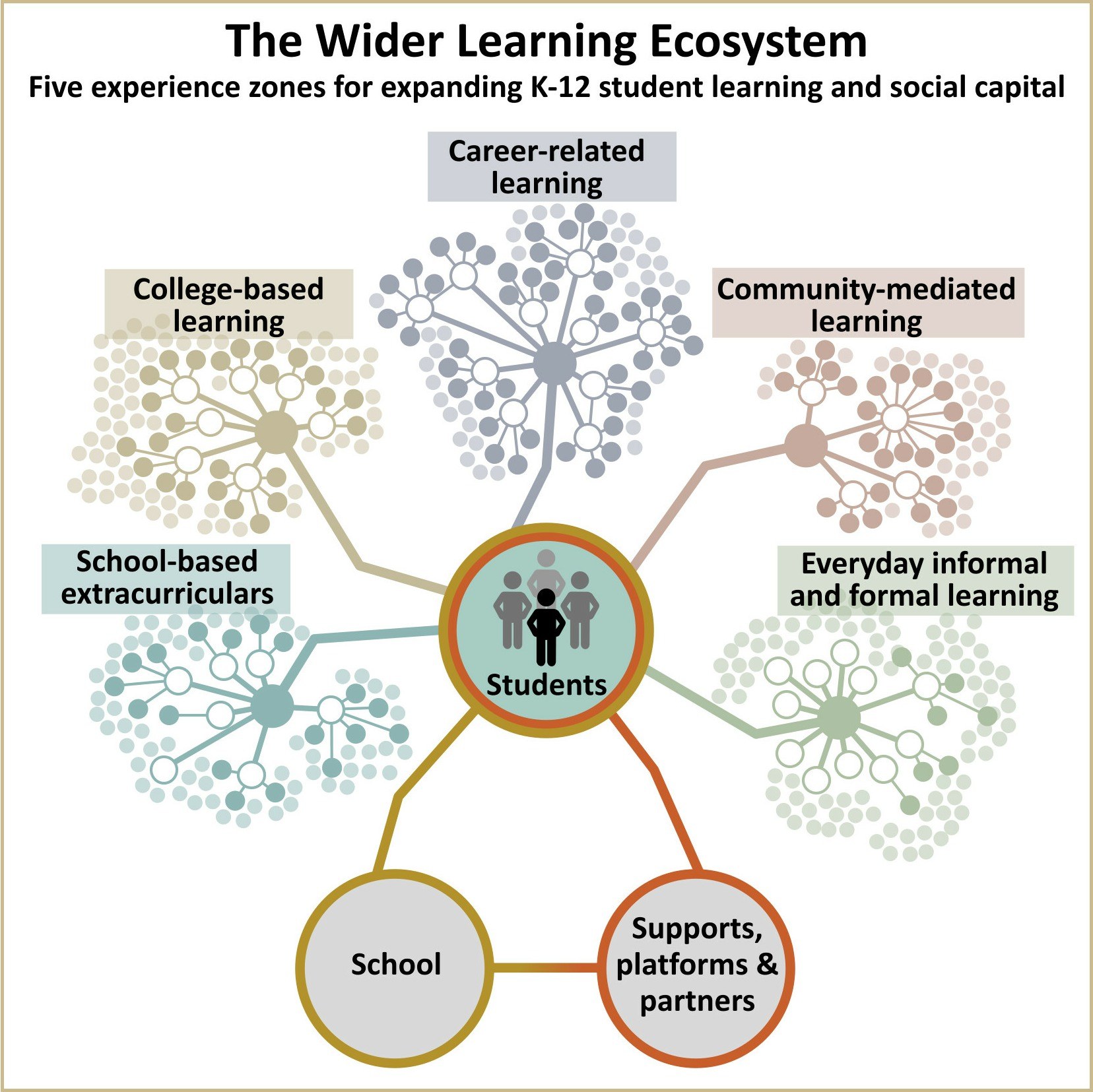
The 5 Zones of the Wider Learning Ecosystem
As featured in a Practitioner’s Guide about community partnerships , Natasha and her colleagues at Da Vinci Schools provide high school students with numerous real-world learning experiences throughout the Wider Learning Ecosystem. Partnerships with colleges, universities, and local businesses open up opportunities for apprentice adults to participate in dual or concurrent enrollment in higher education, job-shadowing, internships, career-focused boot camps, and other industry-based experiences. Educators at both Da Vinci Schools and in Laramie County stress that these experiences need to be well designed to achieve the desired impact. According to Lindsey, “Earning college credits should not be random. Credits should lead to students’ goals for after graduation.” Similarly, workplace experiences “can’t just be a job. They have to build career awareness and help students prepare for their futures.”
Though the kinds of experiences mentioned above are most common at the secondary level, building learner skills to be successful in a real-world learning context can occur at any grade , and educators can gradually integrate real-world learning elements over time. Casey defines real-world learning this way: “In its simplest form, it’s learning that is hands on, engaging, and connected with the world beyond school walls.”
When deeply implemented, real-world learning looks more like this: “All students access multiple opportunities and teachers are actively involved. Teachers have built relationships with the community and moved beyond offering a one-off project,” Casey explains. For instance, at the “leading level” of the Schools That Can Real-World Learning Rubric , “Real-world experiences are ongoing throughout the course of the year. Real-world learning is part of the fabric of the school and everyone benefits.”
For schools and educators new to real-world learning, Casey offers several ways to get started, such as by designing learning projects and experiences that are hands on and involve learning by doing . Maker education is one example. She also recommends inquiry-based approaches like Self-Organized Learning Environments (SOLE), in which educators present learners with real-world problems and frame projects “as a big question to research and explore and build solutions to. Ideally, learning should be interdisciplinary as well because that’s the way the real world works.”
As a natural next step for engaging with the world outside of school, Casey suggests “having students present to authentic audiences outside of school or bringing experts or professionals into the school. They can be judges on work and help kids get a different kind of feedback. It’s an easy way to start those partnerships and build a mutually beneficial relationship.”
The MyWays Readiness and Preparation Tool acknowledges that many of the attributes of real-world learning are very different from the kind of teaching and learning that happens in more traditional schools. In addition to building educator capacity for designing authentic, hands-on, and student-driven learning, this tool recognizes that students themselves and members of the community will likely need assistance as they shift their mindsets and think about learning in new ways . Lindsey’s experiences bear this reality out. She recounts, for example, “When I tell a local business leader that simply coming in and talking about your business might be hard for a teacher to justify without an educational goal in mind, it can be really eye-opening. People from industry and the community may know little about education, but it’s not insurmountable.”
For that reason, the Readiness and Preparation Tool helps schools gauge the readiness of educators, learners, and external partners from the Wider Learning Ecosystem. It also provides suggestions and resources to prepare all three partners to co-create powerful and successful real-world learning experiences.
- The MyWays Real-World Learning Toolkit provides educators and their community partners with four tools to support the design of powerful and successful real-world learning experiences.
- The Schools That Can Real-World Learning Rubric (free to download with registration) serves as a guide to help K-12 schools reflect, set goals, and drive improvements around RWL.
- Part one and part two of the Practitioner’s Guide series "It Takes a Village" shares practices and resources from three school systems deeply engaged in real-world learning: Da Vinci Schools (CA), St. Vrain Valley Schools (CO), and Vista Unified School District (CA).
- “ Who You Know: Building Students’ Social Capital ” explores in greater depth why social capital is an essential part of young people’s preparation for life and how schools and educators can support students in acquiring it.
- MyWays Report 11: Learning Design for Broader, Deeper Competencies presents research, design principles, and case studies on key practices, like real-world learning, that support student development of agency, social capital, and competencies for success.
Photo at top, courtesy of NGLC: Students at Vista High School engage in real-world learning.
Amanda Avallone (she/her/hers)
Learning officer (ret.), next generation learning challenges.
Amanda retired from Next Generation Learning Challenges in 2022. As a Learning Officer for NGLC, she collaborated with pioneering educators and their communities to design authentic, powerful learning experiences for young people. She created educator professional learning experiences that exemplify the kind of learning we want for our students and she supported, connected, and celebrated, through storytelling, the educators who are already doing the challenging work of transforming learning every day.
Read More About Why Schools Need to Change

Bring Your Vision for Student Success to Life with NGLC and Bravely
March 13, 2024

For Ethical AI, Listen to Teachers
Jason Wilmot
October 23, 2023
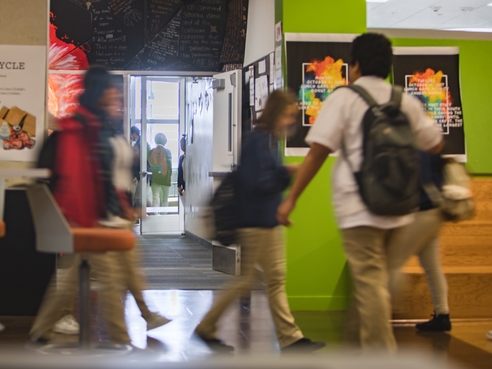
Turning School Libraries into Discipline Centers Is Not the Answer to Disruptive Classroom Behavior
Stephanie McGary
October 4, 2023
- Our Mission
Keeping Learning Real, Relevant, and Relatable
Reading and writing exercises teachers can use to tap students’ interests and experiences in a variety of classes.

Our students are reading all day long—text messages on their phones, emailed directions about homework, apps from advertisers. They read what interests them and what helps make their world a more real, relevant, and relatable place to live. And we can tap into their interests to embed speaking, listening, reading, and writing in classes to help achieve content objectives.
Keep It Real
Students want to learn about things that have an impact on them in their daily lives.
Example: Give students an opportunity to learn about where they live by researching how culture, religion, and traditions have shaped their community and perhaps their lives as well. As you introduce this lesson in history or social studies, remember that some students might feel proud of their community, but others might be embarrassed about where they live, and still others might feel indifferent. For many students, their demographic reality is something they have no control over. But where we live does have a real impact on us. Ask your students: How do our neighborhoods define us, our families, and our neighbors?
Have students learn about the history of their neighborhood by researching it. Who were the first people to move to that particular part of town? As an example, what was their ethnic background? Was that particular part of the community more rural than urban, more industrial than agricultural?
Next, ask students to locate vintage pictures of their community from various websites. What can students infer from the pictures? Or invite neighborhood senior citizens to school to share their memories. How has their community changed? How has it stayed the same?
Finally, ask students to explain what they learned about their neighborhood. Students could share their community through more pictures or other artistic representations, or through interviews with senior leaders of their community.
In this scenario, keeping it real means sharing their neighborhood and explaining in creative ways how we are tied to the culture, traditions, and people around us.
Keep It Relevant
Students want to be connected to their learning and in control of it. When planning a lesson, think about the connections students will be able to make.
Example: Students are often tasked with writing a creative reflection about their last family vacation in English class; however, many students have never gone on a family vacation. The writing holds no connection to those students and creates a gap between those who have taken this kind of vacation and those who don’t have the means or opportunity. As a result, this assignment is busywork for some students.
Instead, give students in-class time to write a “Dear Teacher” letter to tell you about their family, their academic background, and their hobbies. This lesson can work in any class, not just English, and you may be able to apply the letter to your lessons, keeping your students connected to their learning in a very personal way.
In this example, you have used a culturally responsive, universally designed lesson to include all students in a relevant way.
Keep It Relatable
How do we connect student interests to their textbook or other required reading? Asking students to study what they find interesting in the text is not enough. However, offering choice within those texts might help.
Example: The next chapter in students’ world history text is ancient Rome. As you explain and highlight the textbook features of the chapter, offer choices of study within the text: During your preview of their required text, ask students to jot down the subheadings, questions, or pictures they find interesting.
Next, create small groups based on student interests. One group might want to research the early years of the republic, another might want to study ancient ruins, and another might want to investigate the power of Rome.
Give groups time to research their interests and prepare presentations based on information within the text and perhaps one or two outside sources. Then give them the opportunity to share their information in rotation stations, with students moving from one station to another to learn from their peers about their interest of study.
In this way, students are able to relate to the content by taking ownership of their learning.
Creating real, relevant, and relatable lessons might mean giving up some teacher control to dialogue with students about what they want and need to be successful. However, if you empower students to share their passions, perceptions, and progress in a deeply meaningful and personal way, your lessons become more creative and imaginative, and give students an opportunity to lead their learning.

How To Learn Through Experience
One of the most common misconceptions is that learning is synonymous with education. You often hear colleagues say they stopped…

One of the most common misconceptions is that learning is synonymous with education.
You often hear colleagues say they stopped learning after leaving college. The truth is we only get an education from institutions. Learning, on the other hand, is a lifelong process.
To understand this, just think of how a baby learns.
Initially, the baby is too young to get up, walk, or say anything. But soon it starts moving around, and eventually, learns to walk and speak.
The baby does this just by learning from experience.
Learning through experience is not easy, but it is something we all do at different levels.
Let’s look at the example of the baby again. It is not afraid of anything because it doesn’t understand the concepts of safety or fear. As the years roll by, it will learn these concepts through experience. Learning from experience can make us stronger and more capable of doing the right things.
What Is A Learning Mindset?
Mindset is the basic mental structure or aptitude that shapes a person’s thoughts, actions, and behavior towards others. A person is known to possess a learning mindset when their natural tendency is to focus on learning consistently.
A learning mindset is a fundamental trait. A mindset focused on learning can be strong criteria to weigh factors such as:
The person’s approach to learning.
There are different types of learners. Some are comfortable with formal learning in a mentor/teacher-learner process. Then there are those who prefer real learning through experience.
Response to learning
Different people face different challenges and advantages while learning; and so their responses also vary. Some are quick learners; others could take longer to get used to a concept and could need repeat lessons or additional support. ( Zolpidem )
The takeaway
The first objective of any learning program is the ‘knowledge’ that the learners will gain from it. Be it something that boosts their interpersonal skills or professional skill acquisition.
Learning From Experience: How To Do It
Most of our life experiences are great opportunities to learn new skills for personal development. But many people don’t take advantage of such opportunities simply because they don’t have a mindset focused on learning.
For those who have a learning mindset, the experiences become the bedrock for self-reflection. These reflections help them assess their situation, their world view and understanding of human behavior, etc. They then put these ideas to the test and eventually gain new experiences.
Learning from experience is also known as Experiential Learning (EXL). One of the popular definitions of the process says it is “learning through reflection on doing”.
It is greatly different from conventional learning as there may be no teacher or mentor involved. The learner plays an active part in the learning process. It is an individual-focused learning technique for learning from experience.
A common example of real learning through experience is that of botany students. While they can simply learn about the various plants and trees by reading books on the subject, they are regularly taken on trips across biodiversity parks, gardens, and forested areas for learning from observation.
The learners don’t have to rely on things they hear from others or read from books but can learn based on their own experiences. Such learning is usually much more impactful as it can be counted as real learning through experience.
Such experiential learning is a common feature for students of streams such as history, architecture, tourism, and geology. Medical students also get to learn by observation as they attend live surgeries and observe the healing process of patients in hospitals.
David Kolb is a renowned name in the field of experiential learning. According to Kolb, knowledge acquisition is a perpetual cycle. We learn from our personal as well as professional experiences.
Kolb outlines four characteristics of a learner that must be present in anyone keen on learning from experience. These are:
Willingness to actively participate in the experience, ability to reflect upon the experience gained, analytical skills to visualize the experience, decision-making and problem-solving skills that can be applied to new-found ideas.
As the above learning experience examples highlight, the process of learning through experience requires a lot of self-effort, initiative, a desire to learn, and an action-based learning period. David Kolb’s experiential learning cycle is an ideal framework for understanding the various stages of the process.
Many modern educators are well-versed with the importance of experiential learning. One of the key reasons behind its impact is considered to be the emotional and sensory experience that such hands-on learning provides. It helps learners connect with actual knowledge instead of simply learning the concepts and information through books. The personal involvement of learners helps them in reflection and that gradually furthers them to learning from experience.
The crux of experiential learning is highlighted by five questions:
Did you notice, why did that happen, does that happen in life, why does that happen, how can you use that.
These questions make learners reflect on what they observed or experienced and gain long-term knowledge.
Need For Businesses To Cultivate A Learning Mindset:
Learning experience examples:.
If you look at the most popular and high-paying jobs of today, you will find that most of them didn’t even exist 20-30 years ago. On the other hand, many of the hottest jobs of 30 years ago—DOS operators, typists, switchboard operators—don’t exist anymore.
Constantly changing technologies and innovations keep changing the nature of jobs and processes that we see in our daily lives..
In recent years, we are witnessing the rapid proliferation of technologies such as Artificial Intelligence (AI), the Internet of Things (IoT) and automation. Jobs are increasingly becoming redundant.
According to research by McKinsey, 400 to 800 million contemporary jobs will no longer exist by 2030.
However, this doesn’t imply there will be no jobs for those currently employed in these positions.
Some jobs are likely to morph into a different form—just like the typists of yesteryears have now been replaced by computer operators and commercial painters replaced by graphic designers.
Other new jobs will be of a more ‘human’ nature that focus on teamwork and creativity. Automation will only take away the mechanical part of the jobs the human aspect and management roles will still be with humans.
So, the time is ripe for businesses to cultivate a strong experiential learning mindset to make sure their employees are ready for future technologies and jobs. Let’s look at some core competencies that human resource managers need to focus on:
Digital Expertise:
With the rapid growth in AI technologies and tools, many businesses have already invested in AI tech or are planning to do so gradually over the next few years. However, most of those companies are not focusing on making their current employees AI-ready.
Once machine learning and AI technologies enter more operational areas, there will be a need for personnel who are well-versed in working with automation and AI.
Ability To Work Seamlessly In An Inclusive Environment:
Diversity and inclusivity are no longer just jargon. The future belongs to offices that are gender/culture/ethnicity-neutral. There will be diverse perspectives, lifestyles, and behaviors in every organization. People who have open or hidden biases against some or the other section will not be desirable. Teams will also need to get rid of their generational biases.
Learning is a continuous process that is not only academic but greatly experiential as well. Everything we do, observe or hear, creates an opportunity for evaluation, understanding, and creation of new ideas. These ideas subsequently get integrated into the work processes and are validated through new experiences.
It is a constant cyclic progression that we all need to learn. However, as various learning experience examples indicate, it is often not easy to get into the learning mindset. That’s where Harappa Education’s Learning Expertly course can help you. It teaches you about the growth mindset and helps you and adopt fresh perspectives on existing problems.
Sign up for the course to step on the road to learning.
Explore our Harappa Diaries section to know more about topics related to the Think habit such as Meaning of Heuristic , Critical Thinking , What is an Argument , Creative Thinking & Design Thinking .

clock This article was published more than 9 years ago
What real learning actually looks like in class

For decades educator Marion Brady has been writing about what real learning looks like in class — and it frankly doesn’t resemble much of what you’d see today in public schools where standardized tests drive what and how teachers teach. In the following post Brady explains what project-based learning is and why it is superior to the current theory under which teachers labor. Brady, a veteran classroom teacher, who has written history and world culture textbooks (Prentice-Hall), professional books, numerous nationally distributed columns (many are available here ), and courses of study. His 2011 book, “What’s Worth Learning,” asks and answers this question: What knowledge is absolutely essential for every learner? His course of study for secondary-level students, called “Connections: Investigating Reality,” is free for downloading here . Brady’s website is www.marionbrady.com .
By Marion Brady
The main theory shaping traditional schooling says teaching means delivering information. Critics say that’s a poor theory, but its adequacy is so taken for granted that billions of private and taxpayer dollars are being spent, millions of kids and teachers are being battered, and the future of America is being put at risk, by schemes based on the theory. Incredibly, the No Child Left Behind and Race to the Top programs wer e put in place without a single pilot or experimental program to check the validity of the “deliver information” theory.
Like many long-time educators, I think the theory is simplistic at best and flat wrong at worst. That very wise teacher, the late John Holt, pinpointed the problem in a 1984 article in the magazine Growing Without Schooling . “Learning is not the product of teaching,” he wrote. “Learning is the product of the activity of learners.”
When I finally accepted that obvious fact, I stopped delivering information and started giving small teams of learners something difficult to do. I became an advocate of project-based learning (PBL). Its merit is firmly established. Research, common sense, and well-performing PBL programs in America and abroad make clear the merits of schooling that allows kids to move beyond the forced passivity of reading and listening, get up from their desks, and undertake real-world, hands-on tasks that teach as only firsthand experience can.
But acceptance is slow. Very slow. The conventional wisdom says teachers deliver information. Teachers are trained to deliver information. Media images of classrooms show teachers delivering information. Powerful people—Presidents of the United States, governors, chief state education officers, Congress, Bill Gates, Arne Duncan, the Waltons, and so on—think educating means delivering information. The publishers of textbooks are in the information-delivery business, and the manufacturers of standardized tests create tools to measure how much information is being delivered.
(There’s growing resistance to the testing juggernaut, but mostly because of over-testing, not because the “delivery” aim is being questioned.)
There is, however, a problem with project learning. Schooling that doesn’t teach the usual content of the core curriculum in the usual way isn’t acceptable, and projects don’t do that. They have intellectual depth but not the breadth to cover the information delivered (albeit poorly) by the core curriculum.
So I’ve a proposal—a project so all-encompassing and difficult that learners undertaking it have no choice but to make continuous use of the core subjects. They learn and remember it, because they’re involved in a project they consider important.
That project: Designing and carrying out a long-term study of the school they attend, and using their growing knowledge of their school to improve it.
Schools have histories, infrastructure, purposes, and problems. They have populations, patterns, and procedures. They have community relationships and responsibilities. They have a culture. The possibilities for description and analysis are vast and varied.
For example, schools use energy—electricity, and probably, directly or indirectly, some form of fossil fuel. Developing real, in-depth understanding of the sources of that energy, how the school uses it, how much it costs, how efficient it is, how it impacts the environment, and so on, doesn’t just lead to geology, chemistry, physics, economics, politics, and other fields, it relates and integrates them in ways not possible when those fields are studied in isolation from each other as schools ordinarily offer them.
Consider: The school models the larger world in all its incredible complexity. Making sense of it has learners doing, with help from professionals, what they’ll be doing for the rest of their lives in their jobs, in the organizations to which they belong, in their neighborhoods and communities, and in their country. It has them doing what all humans, consciously or subconsciously, continuously do—ask themselves, “What’s going on here, how can I make the most sense of it, and put that sense to good use?”
Consider: Asking kids to use their growing understanding of the school to propose ways to improve its performance not only shows a level of respect for their capabilities that pays off in myriad, often unexpected ways, it can be a major source of fresh thinking.
Consider: When what’s learned is concrete rather than abstract, when it’s immediately useful instead of “this will be on the test,” when knowledge is forged by dialogue with peers and coaches, so much more is accomplished in so much less time it allows the entire school day to be rethought. With the basic skills and concepts of a general education covered by the project, there’s time for advanced classes for those for whom they’re appropriate, time for electives discarded by present reforms, time for extra-curricular activities, time for magnet schools to expand instruction in their specializations, time for apprenticeships, work-study arrangements, and other, not-yet-invented alternatives to “seat time.
Finally, consider that schools are comprehensive, integrated sociocultural systems, and such systems, writ large and called “cultures” and “civilizations,” are the makers of meaning and the shapers of human history. What better way to grasp the “big picture” of life on planet Earth than by intensive study of a small-scale but near-perfect manifestation of it?
All that from a teaching resource that’s instantly accessible and doesn’t cost a dime.
Part Two: How “active learning” looks in a real school
In Part One, I argued the merit of project-based learning, with particular emphasis on a project that had small teams of learners designing and carrying out a detailed, long-term study of the school they attend, and using their growing knowledge to improve it.
What follows are parts of an email from a working educator, William Webb, director of The Center for Educational Options in Henry County, Kentucky. His school, he says, “is heavy with students who’ve given up on schooling. Frustrated and often angry, they come to us as in-school drop-outs, present in body (because the law requires it), but absent in spirit.”
His first concern (as it should be for all educators) isn’t academics but in “creating a sense of community.” He does this by teaching a set of social skills (communication and assertiveness, emotion-management, problem-solving, conflict-resolution and working in groups) known to be central to positive, successful work and community interactions.”
Teaching life skills in the context of community, he says, “takes advantage of innate needs for belonging, competence, and efficacy. As such, students understand intuitively that the skills they are learning are useful and meaningful.”
But it’s a school, so the core subjects must be taught. For that, he described his experience using the course of study, Connections: Investigating Reality, in the manner described in Part One.
Here’s more of his post:
…we introduced our students to the notions of “patterns” and “connectedness” and the dynamics of “systems.” To grasp these abstract concepts as they apply to relationships between human behavior and physical environments, the students decided to acquaint themselves in a more mindful way with a small commons area located between our building and the high school. Working in teams of four, the students were first asked simply to describe the area linguistically. They were mildly surprised to realize that a simple verbal description was not simple at all. The boundary of the area was established beforehand, and yet descriptions varied considerably from group to group. Landmarks that seemed important to one group were virtually ignored by another. Estimates of distance were wildly inaccurate. Words chosen to describe some aspect of the environment were imprecise and vague (“There’s a small hill a little bit behind us that’s pretty steep.”). Listening to each group’s verbal descriptions, no one needed a curriculum or assessment expert to define the “lesson targets.” The important questions were obvious. How do we account for the differences in descriptions? How do we reconcile these differences to come to a shared perception of our environment? Why is it important to be precise in describing our surroundings? How do our differing perceptions of our immediate surroundings influence the way we interact with each other? These and many other questions were asked and answered in the follow-up discussion to this “simple” exercise. Moreover, student involvement during this discussion was profoundly different from typical high school classroom interactions. Freed from the cognitive task of memorizing facts, our students argued and conceded and elaborated and prioritized and paraphrased and deduced and just about every other verb that the Bloom taxonomists say are important to learning. And they were doing it in the context of an authentic task with real-life implications. Once the students had settled on a verbal description of the commons area, they were asked to draw a diagram of the area to scale. Not one student had any experience with that exercise. Most were math-phobic, having been spectacularly unsuccessful in the math courses taught in the traditional classroom. But having spent the past few days thinking about their environment in a more mindful way, they were motivated to tackle this assignment. Armed with 50’ tape measures, they had little trouble measuring the lines that defined the area’s boundary. But connecting those lines in a scaled representation of the area presented some challenges. One challenge was the way an adjacent building jutted into the space the students were detailing. In order for the scaled drawing to come out right, the angle that the building “interrupted” the space had to be accurately defined—and it wasn’t an obvious right angle. With no way to use a protractor, the students were stymied. Attempts to use their limited knowledge of geometry to find a mathematical solution were futile. Solutions on the Internet were too technical in their language to be helpful. And then, in a flash of insight, one student (whose math skills had been assessed by standardized testing measures as being in the lowest “novice” range) ran into the classroom and returned with a block of modeling clay which he proceeded to shape around the building’s corner. Once he had “modeled” the angle in this way, it was a simple matter of transferring the angle to a piece of paper which could now be measured with the protractor. Voila!! The satisfaction this student felt at finding that solution and the affirmation he received from his classmates was a brand new experience. He felt smart. He was smart—and Connections gave him a chance to demonstrate that smartness in a way the traditional curriculum never had. One other example: As previously mentioned, the students were asked to draw a scaled diagram of the commons area they had chosen to investigate. This, of course, was a ratio and proportions exercise most likely introduced to students in elementary school. But our math-challenged students approached the assignment as if they had been asked to prove the Pythagorean Theorem. A freshman girl (let’s call her Kayla) with a neurotic aversion to all things mathematic, watched quietly while the other three (somewhat mathematically challenged) members of her group struggled to work through the steps for converting their measurements to the scaled drawing. After looking at their measurements and the size of the graph paper they were required to use, they decided that 8 feet of measured distance should be 1 inch on the drawing. There were dozens of measurements—2’9’’, 47’3’’, 9’4’’, etc. The teachers were no help. The students were on their own to figure this out. Normally, Kayla tuned out when presented with an assignment from a math book, engaging in all manner of avoidance (and class distracting) behaviors. But this was different…a problem, for sure, but not just a math problem. So, Kayla listened differently and she watched as different strategies were tried, and then—she got it! “We gotta make everything inches, and then we have to divide by 96!’’ She showed her group mates. It was a special moment and nearly impossible to describe. Normally a bit histrionic in her actions, Kayla seemed more centered, more authentic, in her excitement and enthusiasm at discovering this hidden skill. She was clearly enjoying feelings of competence that she rarely experienced in the school setting, let alone while doing math. She liked how it felt. She insisted on doing all the conversions herself, working without a break through part of her lunch period to finish. Connections , with its emphasis on creating the type of “sense-making” opportunities in which the brain strives innately to engage, provides a much broader landscape for their occurrence. For those truly interested in addressing the inefficiencies in our current educational system, this course of study is a sensible, doable place to start.
Educators who feel their first obligation isn’t to raise test scores but to help the young make the most-possible sense of themselves, others, and the world, should find Connections: Investigating Reality worth exploring. It’s a first of its kind and begs for continuous inputs from working classroom teachers, but it’s a start. And it’s free, needing merely to be downloaded .

Publications
On-demand strategy, speaking & workshops, latest articles, write for us, library/publications.
- Competency-Based Education
- Early Learning
- Equity & Access
- Personalized Learning
- Place-Based Education
- Post-Secondary
- Project-Based Learning
- SEL & Mindset
- STEM & Maker
- The Future of Tech and Work
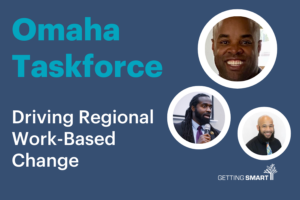
Omaha Taskforce on Driving Regional Work-Based Change
Town hall recap: learner-centered ecosystems as a public education reality, ryan lufkin on instructure, acquisition and the future of credentialing, erika giampietro and destiny egbuta on the massachusetts early college promise, recent releases.
Unfulfilled Promise: The Forty-Year Shift from Print to Digital and Why It Failed to Transform Learning
The Portrait Model: Building Coherence in School and System Redesign
Green Pathways: New Jobs Mean New Skills and New Pathways
Support & Guidance For All New Pathways Journeys
Unbundled: Designing Personalized Pathways for Every Learner
Credentialed Learning for All
AI in Education
For more, see Library | Publications | Books | Toolkits
Microschools
New learning models, tools, and strategies have made it easier to open small, nimble schooling models.
Green Schools
The climate crisis is the most complex challenge mankind has ever faced . We’re covering what edleaders and educators can do about it.
Difference Making
Focusing on how making a difference has emerged as one of the most powerful learning experiences.
New Pathways
This campaign will serve as a road map to the new architecture for American schools. Pathways to citizenship, employment, economic mobility, and a purpose-driven life.
Web3 has the potential to rebuild the internet towards more equitable access and ownership of information, meaning dramatic improvements for learners.
Schools Worth Visiting
We share stories that highlight best practices, lessons learned and next-gen teaching practice.
View more series…
About Getting Smart
Getting smart collective, impact update, #irl: 20 tips for real life learning.
- Future of Learning
- Future of Work
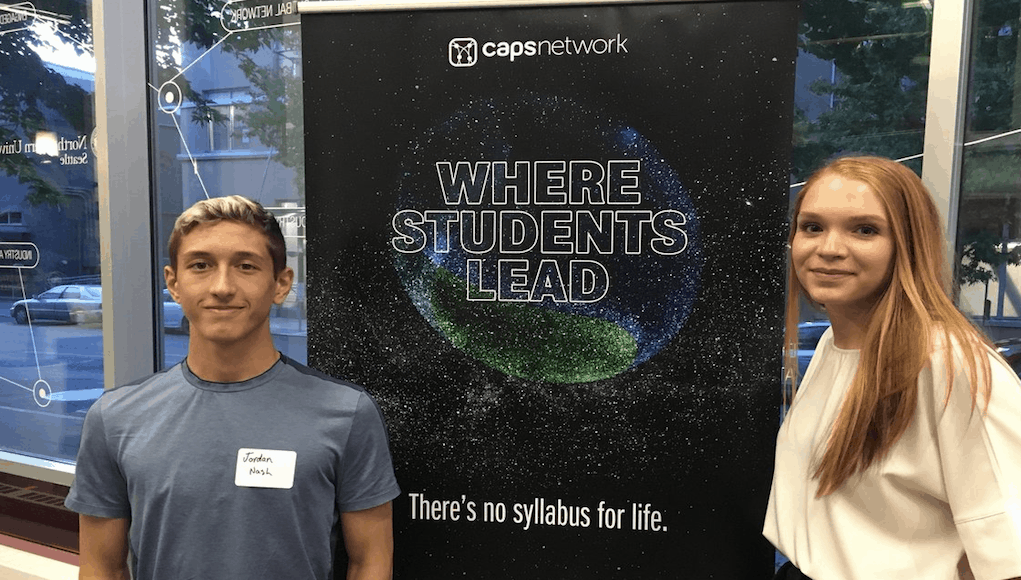
Emma Haynie and Jordan Nash (above) are running a coffee shop in town and planning a charity car show. They are juniors at Ridgefield High , 20 miles north of Portland.
Jordan admitted that he was a procrastinator in some of his courses but, he added, his real world learning experiences were teaching him persistence and project management. “There is real money involved,” said Nash.
To expand access to real world learning, Ridgefield High joined the CAPS Network, more than 100 school districts committed to expanded access to real world learning.
The Center for Advanced Professional Studies (CAPS) opened 10 years ago as a center for professions-based learning in the Blue Valley School District in southwest Kansas City. The CAPS goal is to fast forward into their future immersed in a professional culture, solving real world problems, using industry standard tools, mentored by professionals while receiving high school and college credit. You can check out there film, Where Students Leads .
Real world learning is valuable but it takes preparation and sustained commitment. Following are 20 tips on how to boost engagement and relevance with real world learning
Planning and Preparation
1. Community Engagement. If you want more youth engaged in meaningful projects, gaining the benefit of internships, pursuing valuable credentials, or hatching their first business—the place to start is community conversations about learning goals. Just ask , “What’s happening?, What does it mean? and How to prepare?” The answers will yield a rich graduate profile and support for real world learning. (See Battelle’s PortraitofaGraduate.org for examples).
2. Career Awareness. Help students develop a broad and forward-leaning view of where and how they could contribute. Cajon Valley Union School District ( @cajonvalleyusd ) systematically introduces students to the World of Work through 54 career exploration experiences between kindergarten and eighth grade. Each experience includes exploration, simulation, meet a pro and practice. (Other resources include Roadtrip Nation and Naviance .)
3. Quality Advising. Quality guidance is often delivered through an advisory system , a distributed counseling model that ensures that every student has a sustained adult relationship monitoring social and academic development and promoting broad exposure to career options. A trusted advisor and a good algorithm can provide personalized and localized career and postsecondary awareness and planning while helping young people match their strengths, interests and values with market opportunities.
4. Skills Assessment. Formal skill assessment and informal interest determination are both important to individualize a work-based learning program. Tests like ACT WorkKeys can be useful. An assessment baseline at beginning aids in the process of career development and program evaluation.
5. Time and Space. It can be challenging to make room in a busy high school schedule for work-based learning. That may mean making it a graduation requirement and reducing other requirements. Incentives for participation can also help. Students in more than 600 career academies aim at the NAFTrack diploma which requires a 120-hour certified internship. CareerWise Colorado advocates for paid apprenticeships.
6. Experience Planning. Rather than throwing students into difficult work settings, a scaffold of activities can build student identity and prepare them for success. Valuable experiences include workplace visits, job shadows, community connected projects (#16), mock interviews, and summer jobs.
Schools can also promote workplace values like respect, responsibility, curiosity and doing your best. In Denver, DSST schools give students feedback on these values on a regular basis.
7. Student Preparation. Students need job-ready skills to be successful in work-based learning. They need to know how to shake hands, how to introduce themselves, how to answer questions in an interview, how to read social situations. Orientation should include practice interactions and tips on appropriate behavior and dress. They are learning these skills at CAPS in Blue Valley Kansas (below) and across the CAPS Network .
Cristo Rey is a network of 35 urban Catholic schools where students spend a day a week in a work study. Member schools do a great job of preparing students for success in the workplace. Work-based learning preparation can be part of an advisory system.
8. Professional Learning for Educators. Key to great real world learning for students is a sustained commitment to quality learning for teachers. Members of the CAPS Network learn from and with each other. Many CAPS teachers attend the Summer Huddle .
Indiana teachers are required to engage in 15-hour externships with local businesses. While well intentioned, the quality of these experiences is often a function of local school and system leadership.
Provisioning and Managing Work-based Learning
9. Procuring Business Partners and Internship Positions. Schools, districts and networks should be creating business partner relationships that include one or more internship opportunities. Formal agreements are key to successful work-based learning experiences.
10. Internship Management. The Big Picture team created Imblaze , an internship management platform that helps young people find internships. After picking an internship, a young person attends and checks in at the site using the mobile app. The advisor receives notification that the student is on site. Mentors can provide feedback to students that advisors can review.
11. Regional Agreements. Guidelines on procuring and sharing work-based learning opportunities across regions so that there is equitable access.
12. Skills Communication. Learners that gain valuable experiences including work-based learning, certificates, entrepreneurial endeavors (the Kansas City-based Kauffman Foundation calls these market value assets ) need recognized ways to communicate their expanded capabilities. Strategies include badging, portfolios, extended transcripts, and LinkedIn profiles.
NAF career academy graduate with a NAFTrack diploma giving students hiring preference with corporate partners. Jefferson County (Louisville) students progress through key gateways including graduation with a Backpack of Success Skills (a portfolio)
Industry Certificate Programs
13. Skilled Trade Certificates. In many markets, a skilled trade certificate can be what investor Ryan Craig calls a hard sprint to a good first job. In some trades, good-paying trade jobs may also be the first step on a work and learn ladder.
ACE Leadership High School in Albuquerque ( featured here ) serves students who have or were on their way to dropping out. Projects always have a tie to a real-world challenge in architecture, construction or engineering.
In Chicago, trade unions are leading the way to develop a new high school to improve historically low participation rates of minorities in Chicago’s union apprenticeship programs.
14. Advanced Manufacturing. The Manufacturing Institute sponsors a series of skill certificates. In Wisconsin, GPS Education works with employers and school districts to offer a combination of blended class in the morning and manufacturing internships in the afternoon aiming at several industry certifications.
Northland CAPS students in Kansas City can participate in an internship at a Magna plant where they make car chassis. After graduation, young people can work as a machine operator and participate in a three-year program in maintenance tooling. Magna pays for tuition and books at the local community college where students earn an industrial maintenance certificate.
15. Robotics. The RAMTEC program at Tri-Rivers Career Center in Marion Ohio was the first to offer a robotics program that features industry certification on leading equipment. The program is now available at 22 other career centers across the state. Employers like Honda hire RAMTEC graduates and support continued learning.
Bringing the Real World into the Classroom
16. Community Connected Projects. NYC iSchool engages students in projects connected to real community issues and partners. Health Leadership High in Albuquerque surveys community healthcare providers annually to identify priority projects.
17. Mentors and Experts. Mentors can help build student identity. By meeting in person or online, mentors build confidence, workplace skills and career awareness.
Connecting with experts during a project builds relevance and depth. Cajon Valley students connect with industry experts on Nepris during projects. Educurious provides secondary school project-based units and connections to industry experts .
18. Social Capital. The potential to work with mentors and experts helps young people build their social capital. Julia Freeland Fisher makes the case that social capital often determines where a young person goes to school, the work experiences they gain, what jobs are available and how quickly careers advance. Helping young people make local and interest group connections and graduate with a robust LinkedIn profile and make a world of difference.
19. College Credit Options. Less real world learning and more a real world bargain, accumulating college credit while in high school makes sense for most students (and their families).
A loose network of Early College high schools share the goal of helping graduates earn an AA degree with their high school diploma. Texas has the most (169 with 30 more opening next year) and the best law supporting both credit and fund transfer. (See blog/podcast on a great example, Quest Early College in Humble.)
The 120 P-tech schools combine the benefits of early college with work-based learning and often employment opportunities.
Early college and P-tech schools require careful mapping of high school and college requirements and close coordination. P-tech programs may also be aligned with job certificates in high demand job clusters.
20. Simulations. Learners at Washington Leadership Academy not only participate in real work internships, they also use virtual reality to extend their experiences. Other VR applications include virtual field trips, college campus tours, and job training.
Real life learning can be motivational and valuable but it takes planning, preparation and sustained support to make it valuable for all learners.
For more, see:
- Career Ready High Schools
- Podcast: Big Picture Learning Connects Students to Internships Through ImBlaze
- Career Academy Giant NAF Gets an Upgrade, Expands Access to Work-Based Learning
- Students Earn and Learn Through Next Gen CTE Model
This post is a part of the Getting Smart Future of Work Campaign. The future of work will bring new challenges and cause us to shift how we think about jobs and employability — so what does this mean for teaching and learning? In our exploration of the #FutureOfWork, sponsored by eduInnovation and powered by Getting Smart , we dive into what’s happening, what’s coming and how schools might prepare. For more, follow #futureofwork and visit our Future of Work page.
This post includes mentions of the Cajon Valley Union School District , a Getting Smart partners. For a full list of partners, affiliate organizations and all other disclosures please see our Partner page .
This post was originally published on Forbes .

Tom Vander Ark
- @tvanderark
- @TomVanderArk
Discover the latest in learning innovations
Sign up for our weekly newsletter.
Related Reading

Professional Learning Network Pivots to Virtual
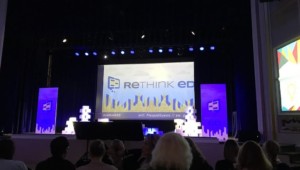
Rethink ED: 3 Hallmarks of the Future of Learning

Work Experiences Are as Important to Career Prep as School
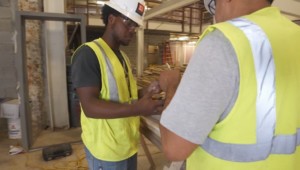
Preparing Young People for Tomorrow’s World of Work Today
Leave a comment.
Your email address will not be published. All fields are required.
Nominate a School, Program or Community
Stay on the cutting edge of learning innovation.
Subscribe to our weekly Smart Update!
Smart Update
What is pbe (spanish), designing microschools download, download quick start guide to implementing place-based education, download quick start guide to place-based professional learning, download what is place-based education and why does it matter, download 20 invention opportunities in learning & development.
More From Forbes
20 tips for real life learning.
- Share to Facebook
- Share to Twitter
- Share to Linkedin
Jordan Nash (left) and Emma Haynie (right), students at Ridgefield High.
Jordan admitted that he was a procrastinator in some of his courses but, he added, his real world learning experiences were teaching him persistence and project management. “There is real money involved,” said Nash.
To expand access to real world learning, Ridgefield High joined the CAPS Network, more than 100 school districts committed to expanded access to real-world learning.
The Center for Advanced Professional Studies (CAPS) opened 10 years ago as a center for professions-based learning in the Blue Valley School District in southwest Kansas City. The CAPS goal is to fast forward into their future immersed in a professional culture, solving real world problems, using industry standard tools, mentored by professionals while receiving high school and college credit.
Real world learning is valuable but it takes preparation and sustained commitment. Following are 20 tips on how to boost engagement and relevance with real world learning.
Planning And Preparation
1. Community Engagement. If you want more youth engaged in meaningful projects, gaining the benefit of internships, pursuing valuable credentials, or hatching their first business —the place to start is community conversations about learning goals. Just ask , “What’s happening?, What does it mean?, and How to prepare?” The answers will yield a rich graduate profile and support for real world learning. ( See Battelle’s PortraitofaGraduate.org for examples).
2. Career Awareness. Help students develop a broad and forward-leaning view of where and how they could contribute. Cajon Valley Union School District ( @cajonvalleyusd ) systematically introduces students to the World of Work through 54 career exploration experiences between kindergarten and eighth grade. Each experience includes exploration, simulation, meet a pro and practice. ( Other resources include Roadtrip Nation and Naviance .)
4. Skills Assessment. Formal skill assessment and informal interest determination are both important to individualize a work-based learning program. Tests like ACT WorkKeys can be useful. An assessment baseline at beginning aids in the process of career development and program evaluation.
5. Time And Space. It can be challenging to make room in a busy high school schedule for work-based learning. That may mean making it a graduation requirement and reducing other requirements. Incentives for participation can also help. Students in more than 600 career academies aim at the NAFTrack diploma which requires a 120-hour certified internship. CareerWise Colorado advocates for paid apprenticeships.
6. Experience Planning. Rather than throwing students into difficult work settings, a scaffold of activities can build student identity and prepare them for success. Valuable experiences include workplace visits, job shadows, community connected projects (#16), mock interviews, and summer jobs.
Schools can also promote workplace values like respect, responsibility, curiosity and doing your best. In Denver, DSST schools give students feedback on these values on a regular basis.
7. Student Preparation. Students need job-ready skills to be successful in work-based learning. They need to know how to shake hands, how to introduce themselves, how to answer questions in an interview, how to read social situations. O rientation should include practice interactions and tips on appropriate behavior and dress. They are learning these skills at CAPS in Blue Valley, Kansas (below) and across the CAPS Network .
CAPS in Blue Valley, Kansas.
Cristo Rey is a network of 35 urban Catholic schools where students spend a day a week in a work study. Member schools do a great job of preparing students for success in the workplace. Work-based learning preparation can be part of an advisory system.
8. Professional Learning For Educators. Key to great real-world learning for students is a sustained commitment to quality learning for teachers. Members of the CAPS Network learn from and with each other. Many CAPS teachers attend the Summer Huddle .
Indiana teachers are required to engage in 15-hour externships with local businesses. While well intentioned, the quality of these experiences is often a function of local school and system leadership.
Provisioning And Managing Work-Based Learning
9. Procuring Business Partners And Internship Positions. Schools, districts and networks should be creating business partner relationships that include one or more internship opportunities. Formal agreements are key to successful work-based learning experiences.
10. Internship Management. The Big Picture team created Imblaze , an internship management platform that helps young people find internships. After picking an internship, a young person attends and checks in at the site using the mobile app. The advisor receives notification that the student is on site. Mentors can provide feedback to students that advisors can review.
12. Skills Communication. Learners that gain valuable experiences including work-based learning, certificates, entrepreneurial endeavors (the Kansas City-based Kauffman Foundation calls these market value assets ) need recognized ways to communicate their expanded capabilities. Strategies include badging, portfolios, extended transcripts and LinkedIn profiles.
NAF career academy graduate with a NAFTrack diploma giving students hiring preference with corporate partners. Jefferson County (Louisville) students progress through key gateways including graduation with a Backpack of Success Skills (a portfolio).
13. Skilled Trade Certificates. In many markets, a skilled trade certificate can be what investor Ryan Craig calls a hard sprint to a good first job. In some trades, good-paying trade jobs may also be the first step on a work and learn ladder.
ACE Leadership High School in Albuquerque ( featured here ) serves students who have or were on their way to dropping out. Projects always have a tie to a real world challenge in architecture, construction or engineering.
In Chicago, trade unions are leading the way to develop a new high school to improve historically low participation rates of minorities in Chicago’s union apprenticeship programs.
14. Advanced Manufacturing. The Manufacturing Institute sponsors a series of skill certificates. In Wisconsin, GPS Education works with employers and school districts to offer a combination of blended class in the morning and manufacturing internships in the afternoon aiming at several industry certifications.
Northland CAPS students in Kansas City can participate in an internship at a Magna plant where they make car chassis. After graduation, young people can work as a machine operator and participate in a three-year program in maintenance tooling. Magna pays for tuition and books at the local community college where students earn an industrial maintenance certificate.
15. Robotics. The RAMTEC program at Tri-Rivers Career Center in Marion Ohio was the first to offer a robotics program that features industry certification on leading equipment. The program is now available at 22 other career centers across the state. Employers like Honda hire RAMTEC graduates and support continued learning.
Bringing The Real World Into The Classroom
16. Community Connected Projects. NYC iSchool engages students in projects connected to real community issues and partners. Health Leadership High in Albuquerque surveys community healthcare providers annually to identify priority projects.
17. Mentors And Experts. Mentors can help build student identity. By meeting in person or online, mentors build confidence, workplace skills and career awareness.
Connecting with experts during a project builds relevance and depth. Cajon Valley students connect with industry experts on Nepris during projects. Educurious provides secondary school project-based units and connections to industry experts .
18. Social Capital. The potential to work with mentors and experts helps young build their social capital. Julia Freeland Fisher makes the case that social capital often determines where a young person goes to school, the work experiences they gain, what jobs are available and how quickly careers advance. Helping young people make local and interest group connections and graduate with a robust LinkedIn profile and make a world of difference.
19. College Credit Options. Less real world learning and more of a real world bargain, accumulating college credit while in high school makes sense for most students (and their families).
A loose network of Early College high schools share the goal of helping graduates earn an AA degree with their high school diploma. Texas has the most (169 with 30 more openings next year) and the best law supporting both credit and fund transfer. (See blog/podcast on a great example, Quest Early College in Humble.)
The 120 P-tech schools combine the benefits of early college with work-based learning and often employment opportunities.
20. Simulations. Learners at Washington Leadership Academy not only participate in real work internships, they also use virtual reality to extend their experiences. Other VR applications include virtual field trips, college campus tours and job training.
For, more see:
This post includes mentions of the Cajon Valley Union School District , a Getting Smart partners. For a full list of partners, affiliate organizations and all other disclosures please see our Partner page .

- Editorial Standards
- Reprints & Permissions
- Board of Trustees
- Vision, Mission, Beliefs, and Values
- Professional Learning Definition
- Advertise with Learning Forward
- News & Media
- Work for Learning Forward
- Powered by Title II
- Data Summaries
- Standards for Professional Learning
- Standards Assessment Inventory
- Search Our Resources
- The Learning Professional
- Research and Reports
- Newsletter Archive
- Tools for Learning Schools
- What we Offer
- Assess your Learning
- Annual Conference
- Leadership Team Institute
- Online Courses
- Journal Issues
- Digital Downloads
- Skip to primary navigation
- Skip to main content
- Skip to footer

Learning Forward
Equity and excellence in teaching and learning.
- Become a member today!
- Career center

KEEP GROWING
Real learning happens in real life, by jim knight.
Read the remaining content with membership access. Join or log in below to continue.
Sed ut perspiciatis unde omnis iste natus error sit voluptatem accusantium doloremque laudantium, totam rem aperiam, eaque ipsa quae ab illo inventore veritatis et quasi architecto beatae vitae dicta sunt explicabo. Nemo enim ipsam voluptatem quia voluptas sit aspernatur aut odit aut fugit, sed quia consequuntur magni dolores eos qui ratione voluptatem sequi nesciunt. Neque porro quisquam est, qui dolorem ipsum quia dolor sit amet, consectetur, adipisci velit, sed quia non numquam eius modi tempora incidunt ut labore et dolore magnam aliquam quaerat voluptatem.
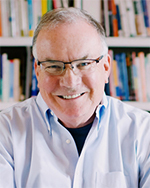
- Jim Knight /author/jim-knight ‘Data’ shouldn’t be a dirty word
- Jim Knight /author/jim-knight Coaching with impact: Enacting partnership principles through the Jim Knight coaching model
- Jim Knight /author/jim-knight When times are tough, show compassion.
- Jim Knight /author/jim-knight What I’ve learned from a traumatic accident
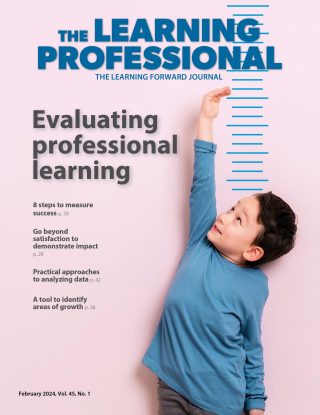
Evaluating Professional Learning

7 reasons to evaluate professional learning
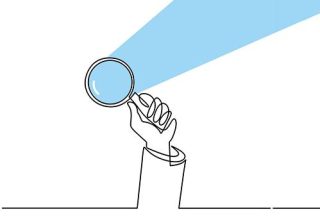
Look beyond the satisfaction survey
Search the learning professional, published date, current issue.

Recent Issues

TAKING THE NEXT STEP
December 2023.
Professional learning can open up new roles and challenges and help...

REACHING ALL LEARNERS
October 2023.
Both special education and general education teachers need support to help...

THE TIME DILEMMA
August 2023.
Prioritizing professional learning time is an investment in educators and...

ACCELERATING LEARNING
Acceleration aims to ensure all students overcome learning gaps to do...

504 South Locust St. Oxford, OH 45056 800-727-7288 or 513-523-6029 Fax: 513-523-0638 Email Us
- Privacy Policy
What is Authentic Learning and How Do I Use it?
As teachers, we are constantly searching for articles, books, or advice on how to make learning stick with our students. In our classrooms, we want engaged learners who retain what they have learned and apply it in their lives for years to come. But how do we actually make this happen?
What can we do to ensure our students are getting the most out of every moment during school? There is definitely one surefire way to do this and it goes by the name of Authentic Learning .
Authentic Learning – A Loose Definition
What comes to mind when you hear the words “Authentic Learning”? Maybe you imagine a hands-on learning experience, learning from credible sources, or maybe nothing at all.
Authentic Learning has a myriad of definitions, but what it boils down to is making what your students learn meaningful by engaging them in relevant and real-world learning .
In education, authentic learning is an instructional approach that allows students to explore, discuss, and meaningfully construct concepts and relationships in contexts that involve real-world problems and projects that are relevant to the learner.
-Donovan, Bransford, & Pellegrino, 1999
According to the Authentic Learning creator and guru, Steve Revington, Authentic Learning “is real life learning. It is a style of learning that encourages students to create tangible, useful products to be shared with their world.”
Not only are we teachers bringing in real world context to our classrooms, but our students are taking real world issues and problems and working to solve them and developing solutions applicable to the world or community around them. This is the future of learning. Students will become adults in a world more complex than our own and will have to solve real world problems creatively and collaboratively. So why not start them on the path for success?
Aspects of Authentic Learning
Now that you have an idea of the definition of Authentic Learning, let’s dive into the aspects that make Authentic Learning what it is.
Learning as an Active Process
This means that students are not just sitting at their desks listening to lecture after lecture . This is not teacher directed learning. It is student-led learning where your class is up and moving and exploring the world around them. This could look like something as simple as taking a community walk, field trip or even virtually connecting with other students or relevant special interest groups.
Self-Directed Inquiry
If you are familiar with the Inquiry Cycle or Inquiry Based Learning , this will come naturally to your classroom. If not, this just means that the learning going on in your classroom is led by your students’ questions and curiosities . The questions they have will guide your lessons to exploring and researching the answers and promote independent inquiry in your students.
Problem Solving
Problem solving in this case refers to the real-world problems your students may be facing or witnessing in their communities or beyond. If you are familiar with the PYP this is where your student-led ‘Action’ comes into play. Social activism and justice can take the center stage in your classroom.
It may require higher level thinking from your students to go beyond themselves and see larger problems in their communities (not just a personal problem like Johnny stealing a block from Susie), however, students of any age are capable of accomplishing this. It is just necessary to give them the tools beforehand.
You can help guide your students by taking field trips to local charities or reading books about global problems. Here you can start to come up with actual solutions your students can create and promote to the community.
Reflection in Real World Contexts
Really focus on real world issues that garner an emotional connection with your students. Authentic Learning is about making learning meaningful and what better way to do so than to focus on your students and things that directly impact them or ignite passion in them? Find books, films, or pictures of children facing challenges or have students share problems they may know about or have faced themselves. Once students become emotionally invested in their learning that’s when the learning sticks and continues to grow as they do.
Your Journey Towards Authentic Learning
At this point you may be asking yourself, “How do I apply this to my classroom? How do I make learning meaningful and authentic?” It all may seem a bit overwhelming and complicated, but I promise it is a lot simpler than you may think.
Get to Know Your Students
Ask yourself these questions:
- Where do my students come from?
- What is the family dynamic/socioeconomic status/culture?
- What does each student enjoy doing? Reading? Making? Watching? Eating? What beliefs do my students have?
The answers to these questions can be found by talking to your students. Observe them during play. Ask them these questions! Once you have the answers, it is easy to start bringing in material or lessons that make a connection with your students.
Get to Know Your Families
It’s just as important to get to know the families of your students, as it is to know your students. Find out the answers to these questions:
- Who makes up the family unit?
- Where do they come from?
- What do they do?
- What do they enjoy doing together?
I suggest setting up an opportunity at the beginning of the school year for you to get to sit down and talk to the families to get to know them and their children.
Get to Know Your Community
- Really find out where your students are coming from especially if you are not from the area or are new to the area. Ask these questions:
- What are the demographics?
- What is your community known for or proud of?
- What are some issues or problems facing your community in general?
Go through and experience your community as if you were one of your students. See it from their perspective.
Get to Know Your School and Yourself
Really take time to reflect on your personal beliefs about learning, about your community or about your students. Take note of what you believe is important and what your teaching philosophy is. Really ask yourself these questions:
- What might be some outdated thoughts or practices on learning do I or my school have?
- What learning programs are already in place?
- How can I change or work with them to make learning more meaningful?
- What learning programs already support Authentic Learning?
- What might be holding me back from implementing Authentic Learning in my classroom?
Getting to know ourselves as teachers and as people will help us to better connect with our students and make their learning more meaningful.
Once a child connects to learning on a personal level and can see how it relates to their world, the possibilities for growth are endless. I hope you found something that speaks to you here and that you feel inspired to bring Authentic Learning into your own classrooms.
About The Author
Maggie Sabin Primary Teacher
Maggie Sabin is a Primary Teacher at Amsterdam International Community School . She has a Master’s in Early Childhood Education and has been teaching Early Years for eight years. She has experience with IB Curriculum, the PYP, IPC, Reggio Emilia and Responsive Classroom.
Recent post
What all content areas can learn from CTE’s Competency-Based Grading
The Revolution of CTE and Reimagining of Secondary Education
New Release: Atlas AI

- For Journalists
- Media Library

Kayne Exemplifies Real Learning for Real Life
By Dan Sheridan
Meet Dr. Jon Kayne, Professor of Clinical Counseling and Psychology at Bellevue University. Bellevue’s Master of Science in Clinical Counseling degree is accredited by CACREP , the Council for Accreditation of Counseling and Related Educational Programs. Kayne not only teaches the program, he is a practitioner; a living example of Bellevue’s motto – “Real Learning for Real Life.”
Kayne, however, didn’t become what he is today overnight. From his youth, Kayne wanted to serve humanity.
“As long as I can remember, even when I was a kid in school, I wanted to be of service to others. I enjoyed helping others,” he said.

“I was one of those idealists who back in those old days joined to serve my country and fellow-citizens,” he said.
Though he enjoyed his military experience, it wasn’t his passion. So, upon his return to civilian life, he tried college again while working a variety of jobs, but he still wasn’t satisfied.
“I was then provided with an opportunity to work in the Middle East, Israel. After a few years working on a border settlement, I came back home and tried college again, but it still didn’t click for me so I became a law enforcement officer. Keep in mind that I joined law enforcement with the mindset that I was going to be helping people.”
Two college tries, the military, law enforcement, and overseas work turned out to be, though he didn’t realize it at the time, necessary life experiences teaching him a very important lesson.
“I came to the realization,” Kayne said, “that the idea of helping people was not a white knight kind of thing where you’re going to rescue people, but instead they really needed someone to listen to them and work with them. With this new realization I was propelled back to college and from that point on there was no stopping me. I got my master’s in clinical social work, then my first job in the field, and while working full time I got my doctorate.”
Kayne was finally living his passion, not with a night stick or M-16, but with his ears providing life-changing service to others. After many years in the clinical counselling field, he came to Bellevue University.

These “side jobs” include seeing vets at Bellevue University’s Military Veteran Service Center; he’s the state wide clinical director through the Nebraska Department of Emergency Medical Services for a critical incident stress management program serving traumatized first responders; and he serves in the Douglas County Jail as an advisor for their veterans unit.
Kayne has watched Bellevue University grow over the last 21 years, especially under the leadership of its President, Dr. Mary Hawkins.
“Dr. Hawkins’ vision has taken this university from being just another private university to being a contender within its class and I am proud to be part of this endeavor.”

“What makes Bellevue’s program unique is that just about our entire faculty have ongoing experience seeing clients themselves. Many people who go into college teaching stop doing the counseling and focus on the teaching, we live up to Bellevue’s motto, ‘Real Learning for Real Life.’”
Kayne has touched so many lives, especially his students. Diane Braun, an Adult Behavioral Health Clinical Supervisor with Lutheran Family Services (LFS) in Omaha, Nebraska, says of her former Professor and now Mentor,
“Dr. Jon Kayne is my mentor and I am so grateful that I get to continue to work with him in the outside world. I remember the first day I walked into my master’s class, I was so nervous wondering if I should take this big step, I just wanted to run out of the room instead. Then in walks Dr. Kayne calming me through his wisdom by saying ‘the first thing you have to learn how to do is just listen; let them tell their story.’ I never turned back after that. Those simple words stuck with me.”
Upon hearing about testimonies of former students like Braun’s, Kayne thankfully said, “I wouldn’t be doing this if influencing students wasn’t my goal.”
Dr. Kayne encourages those who think they are getting a late start in life. It took him many years to be able to live his passion. “I absolutely believe if I had not done all those things I would not be as good at what I do as I am today.”
Summing up his life’s work, Kayne said,
“I heard a chaplain once sum it up as a ministry of presence. I really believe that. It’s a therapy of just being there for people and listening.”
Home — Essay Samples — Education — Study — The Role Of Learning In My Life
The Role of Learning in Life, and Its Factors
- Categories: Knowledge Study
About this sample

Words: 1084 |
Published: May 7, 2019
Words: 1084 | Pages: 3 | 6 min read
Table of contents
What is learning (essay), individual learning differences, works cited.
- Toffler, A. (n.d.). Alvin Toffler Quotes. Retrieved from https://www.goodreads.com/author/quotes/2701.Alvin_Toffler
- McLeod, S. (2018). What is Learning? Simply Psychology. Retrieved from https://www.simplypsychology.org/learning.html
- Sternberg, R. J., & Williams, W. M. (2010). Educational Psychology. Pearson.
- Woolfolk, A., Winne, P. H., & Perry, N. E. (2019). Educational Psychology. Pearson.
- Fisher, R., & Williams, J. (2013). Unlocking Learning and Teaching with ICT: Identifying and Overcoming Barriers. Routledge.
- Pressley, M., & McCormick, C. B. (2007). Child and Adolescent Development for Educators. Guilford Press.
- Darling-Hammond, L., & Bransford, J. (Eds.). (2005). Preparing Teachers for a Changing World: What Teachers Should Learn and Be Able to Do. Jossey-Bass.
- Tomlinson, C. A., & Moon, T. R. (2013). Assessment and Student Success in a Differentiated Classroom. ASCD.
- Vygotsky, L. S. (1986). Thought and Language. MIT Press.
- National Research Council. (2000). How People Learn: Brain, Mind, Experience, and School. National Academies Press.

Cite this Essay
Let us write you an essay from scratch
- 450+ experts on 30 subjects ready to help
- Custom essay delivered in as few as 3 hours
Get high-quality help

Prof. Kifaru
Verified writer
- Expert in: Life Education

+ 120 experts online
By clicking “Check Writers’ Offers”, you agree to our terms of service and privacy policy . We’ll occasionally send you promo and account related email
No need to pay just yet!
Related Essays
2 pages / 713 words
1 pages / 416 words
5 pages / 2197 words
2 pages / 816 words
Remember! This is just a sample.
You can get your custom paper by one of our expert writers.
121 writers online
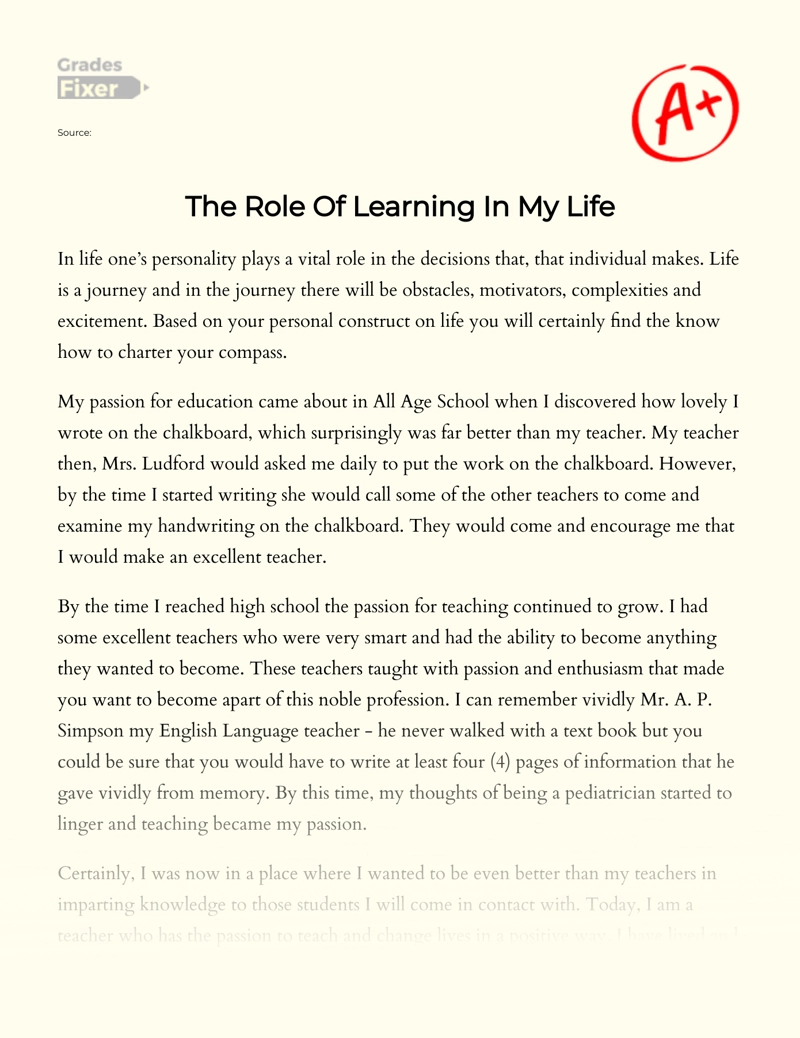
Still can’t find what you need?
Browse our vast selection of original essay samples, each expertly formatted and styled
Related Essays on Study
We People live in the present. We plan for and worry about the future. History, however, is the study of the past. Everything that has been done is “history”, meaning that history directly affects us every day, with today’s [...]
Paulo Freire's essay, "The Banking Concept of Education," challenges traditional educational paradigms and offers a thought-provoking critique of the way knowledge is imparted in traditional classrooms. In this essay, we will [...]
Academic success is of paramount importance in college as it lays the foundation for future opportunities and personal growth. However, college presents various challenges that can hinder students' academic performance. To [...]
My desire to pursue a Business degree stems from my profound curiosity about the field. I am eager to delve into the intricacies of business operations and explore the strategies that drive increased [...]
Rand (2011) states that “I just finished teaching a graduate course in which the students each visited six different early childhood classrooms. When they gave reports to the class about what was interesting and what they [...]
My desire to study engineering started with computing where I learnt programming in several languages, such as Python and HTML5. Furthermore, I have repaired, maintained and adapted computers, using a problem solving approach to [...]
Related Topics
By clicking “Send”, you agree to our Terms of service and Privacy statement . We will occasionally send you account related emails.
Where do you want us to send this sample?
By clicking “Continue”, you agree to our terms of service and privacy policy.
Be careful. This essay is not unique
This essay was donated by a student and is likely to have been used and submitted before
Download this Sample
Free samples may contain mistakes and not unique parts
Sorry, we could not paraphrase this essay. Our professional writers can rewrite it and get you a unique paper.
Please check your inbox.
We can write you a custom essay that will follow your exact instructions and meet the deadlines. Let's fix your grades together!
Get Your Personalized Essay in 3 Hours or Less!
We use cookies to personalyze your web-site experience. By continuing we’ll assume you board with our cookie policy .
- Instructions Followed To The Letter
- Deadlines Met At Every Stage
- Unique And Plagiarism Free
The Joy of Teaching
Sharing creative ideas and lessons to help children learn.

Real-World Writing Free Lessons and Activities
October 26, 2021 by Evan-Moor | 0 comments

It’s a common misconception that students’ academic writing only benefits them in the classroom. With real-world writing projects and instruction, students will learn how to apply their writing skills in authentic career settings! Weekly Real-World Writing is a classroom resource that supplements writing instruction with applicable, real-life examples and activities.
Why is Real-World Writing Important? While developing students’ writing skills is critical for their academic success, it’s also a vital part of their interaction in the “real world.” What this resource aims to do is demonstrate how students can use the skills they’re learning right now —in their everyday lives, outside of school.
Students will learn new skills, as well as how to apply what they already know in realistic, engaging ways. They will also be encouraged to engage in the world around them and use their personal skills and strengths to make a difference.
Motivating Reluctant Writers Real-world applications of writing are also an opportunity to motivate students who may be reluctant to write. Students who dislike writing probably haven’t experienced writing about something that really interests them. With realistic opportunities, students can apply their skills to topics or forms of writing that engage them personally and show writing as a skill outside of the classroom.
Motivate students to write by offering creative outlets and real-world topics that apply to them, as well as encouraging the idea of “no wrong answers” with writing assignments.

Each unit includes:
- Teacher overview
- Graphic organizers
- Two writing prompts
- Additional extension activities
Invitation-Writing Activity Grades 1–2

After reviewing writing examples and learning how to organize information, students will have two writing tasks where they can write invitations to a graduation party and a Valentine’s Day party. They can use their new skills to write the invitation on the template provided, and then decorate the invitations too! The extension activity allows students to get creative and make up their own holiday, event, or party they want to invite friends and family to.
Meal-Review Activity Grades 3–4

Writing a Blog Activity Grades 5–6

In the graphic organizer section, students will identify their ideas for the focus, details, organization, and graphics of their blog post, along with a helpful proofread checklist that will keep their work error free.

The extension activity lets students write a blog post about anything they want! This sparks interest, engages students, and motivates reluctant writers.
Real-world writing helps students make connections between real-life situations and the skills they are learning within the classroom. The activities within Weekly Real-World Writing not only provide the writing practice students need, but the lessons also include creative outlets that teach important skills for every type of learner in the classroom. Not everyone will become a writer in a future career, but every student will need real-world writing experience to succeed.

Leave a Reply Cancel reply
Subscribe Today!
Sign-up for education inspiration for PreK–8 teachers and parents.
Email address:
Grade Level Pre-K Kindergarten 1st Grade 2nd Grade 3rd Grade 4th Grade 5th Grade 6th Grade 7th Grade +
Profession Teacher Homeschooler Parent School Admin Other
By submitting this form, you are consenting to receive emails from Evan-Moor. You can unsubscribe at any time by using the Unsubscribe link found at the bottom of every email.
Experiential Essay (Real-Life Writing)
A requirement for this class is a “real-life” essay or letter detailing a true experience you had; you should submit this to a real person or company.
The time has come to decide on your real-life, experiential essay or letter. For this final paper/essay assignment, you should be able to plan, write a draft, edit/proofread a piece of writing that you will be able to send to a real person. There is no “right” or “wrong” topic, but here are some possible ideas to consider:
Write a complaint about a product you purchased which disappointed you. Maybe you bought a used Iphone that died after a week, or maybe you were deceived by a company in some way; for example, maybe you were bullied into buying rental car insurance that you did not need. Possibly you were wronged by some professional person or agency; for example, my dentist lied to me and told me I would have a tooth extracted, but she really performed very painful and unwanted gum surgery. (See my post below). On the other hand, maybe you are very happy/thrilled with some new product; for example, your brittle dry hair is shiny and soft after using Kerastase hair conditioner. Or, maybe you just stayed in a hotel where the manager went above and beyond what you expected. For example, the owners of a B & B in nearby Little Falls shoveled out my buried car and drove me to a hospital when I suffered an asthma attack. Another idea? Maybe you just want to write a letter of thanks to a teacher or professor who really made a difference in your education. I have written such letters to my dissertation advisor and another professor at Syracuse University.
1. GO to the discussion forum #9. POST your original idea for a real-life piece of writing. IMPORTANT:
READ WHAT I WROTE BACK TO YOU IN THE DISCUSSION. In some cases, I said you had a very workable topic; in others, I suggested you think of a different experience for your letter.
2. Decide on your topic
3. Write a draft of your letter/essay.
4. POST IT IN DISCUSSION FORUM #10. THIS DISCUSSION IS DIFFERENT, SINCE IT IS ALSO A PEER REVIEW.
THIS IS A DISCUSSION FORUM IN FORMAT–SO, FIRST POST YOUR OWN LETTER.
5. Then look at your partner’s letter and complete the required peer review.
I have matched you up with a classmate, and you need to take a careful look at this person’s draft and make suggestions for improvement. This is your final DISCUSSION GRADE for the course. (WORTH 100 POINTS). Of course, your partner needs to have a letter for you to read! And both of you need to work together on this assignment! Please contact me if your partner is missing! I will make other arrangements for you.
6. SUBMIT your edited/proofread letter in the MODULE #6 SafeAssign dropbox.
- Experiential Essay (Real-Life Writing). Authored by : Faye Eichholzer. Provided by : Herkimer College. Located at : http://NA . Project : ATD Course. License : CC BY: Attribution
- Grades 6-12
- School Leaders
FREE Book Bracket Template. For March and Beyond!
65+ Real-World Project-Based Learning Ideas for All Ages and Interests
Find and implement solutions to real-world problems.
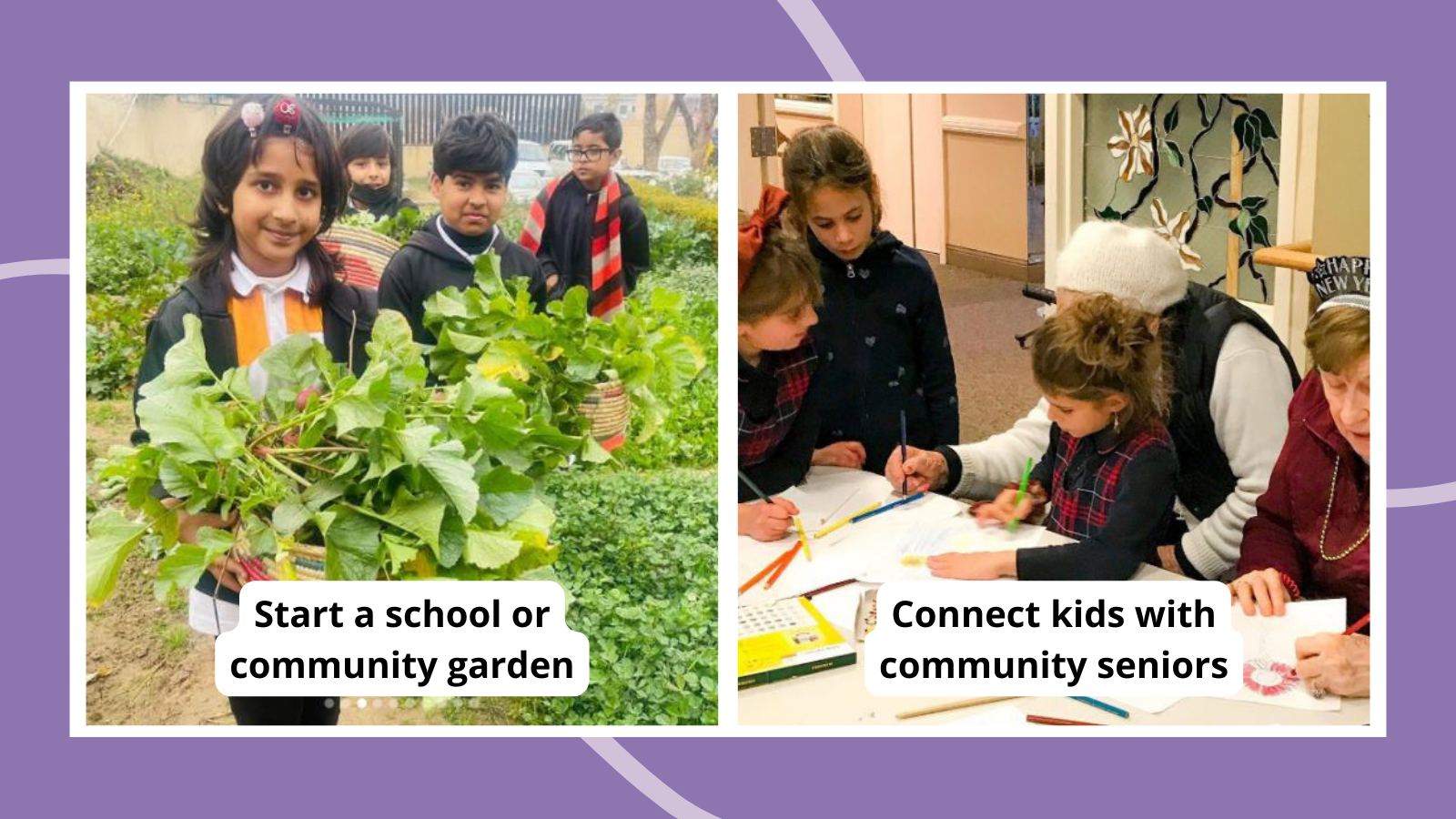
Project-based learning is a hot topic in many schools these days, as educators work to make learning more meaningful for students. As students conduct hands-on projects addressing real-world issues, they dig deeper and make personal connections to the knowledge and skills they’re gaining. But not just any project fits into this concept. Learn more about strong project-based learning ideas, and find examples for any age or passion.
What is project-based learning?
Project-based learning (PBL) uses real-world projects and student-directed activities to build knowledge and skills. Kids choose a real-world topic that’s meaningful to them (some people call these “passion projects”), so they’re engaged in the process from the beginning. These projects are long-term, taking weeks, months, or even a full semester or school year. Students may complete them independently or working in small groups. Learn much more about project-based learning here.
What makes a good PBL project?
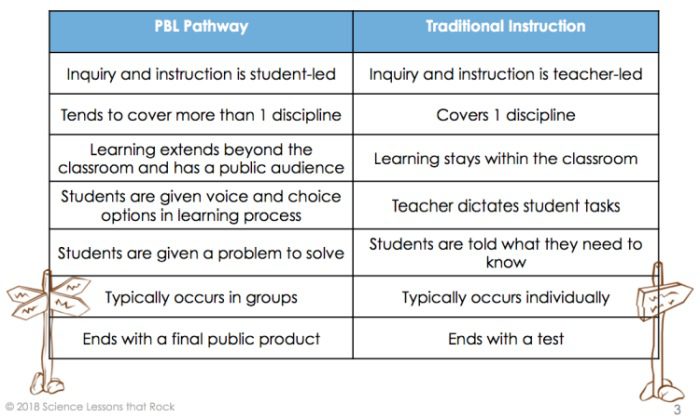
In many ways, PBL is more like the work adults do in their daily jobs, especially because student efforts have potential real-world effects. A strong PBL project:
- Addresses a real-world issue or problem
- Requires sustained and independent inquiry, in and out of the classroom
- Allows students voice and choice throughout the project
- Combines elements of many disciplines
- Includes collaboration with public partners, such as universities, community organizations, or businesses
- Produces a public product that is seen by those outside the school community
- Covers a complete process, including activities like research, design, production, marketing or public awareness, and enlisting supporters or investors
Outdoor Project-Based Learning Ideas

- Create a new local park, or improve an existing one by adding new features or providing needed maintenance.
- Plant a community garden to provide food for a soup kitchen, food pantry, or other organization.
- Design and create a butterfly, pollinator, or other wildlife garden to support the local ecosystem.
- Build a new walking or biking trail that’s safe for people of all ages to use.
- Devise and implement a way to reduce litter in your community.
- Set up and manage a school or community compost pile, and distribute the resulting soil to those who need it most.
- Find and help the public use a new way to grow food that requires less soil, water, or fertilizers, which are in short supply in some parts of the world.
- Design, build, and install a completely unique piece of playground equipment that serves a specific purpose or need.
School Community Project-Based Learning Ideas
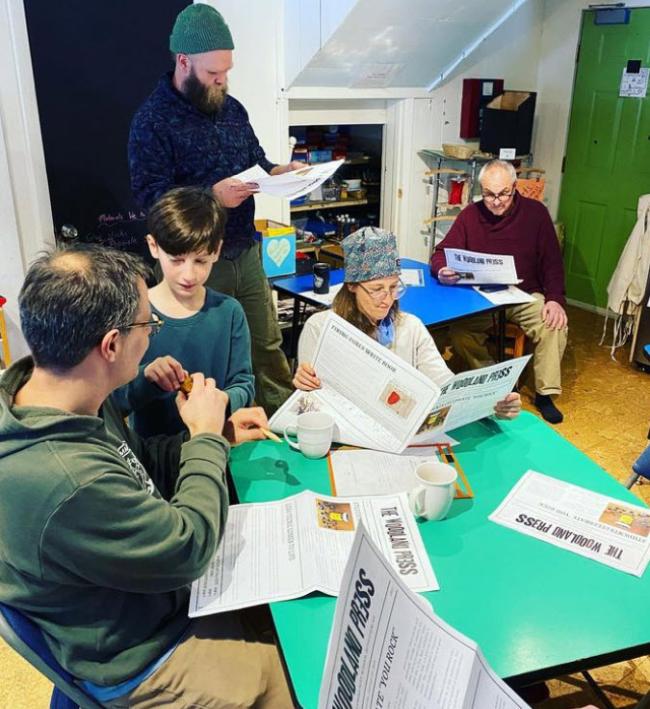
- Start a comprehensive recycling program at school, or substantially improve participation in an existing one.
- Add collaborative artwork like murals or other displays to school hallways, bathrooms, or grounds.
- Determine a location or program at your school that needs improvement, then make a plan, raise the funds, and implement your ideas.
- Come up with ways to celebrate your school’s diversity and improve relationships between all students.
- Start and run a school store , including inventory, financial plans, and marketing.
- Write a school handbook for new students, with tips and tricks for helping them feel at home.
- Figure out how to offer healthier, better-tasting meals and snacks in the school cafeteria.
- Implement a mentoring program for older students to help younger students, with planned activities and appropriate training for older students.
- Design and propose a new style of grading system that ensures equity.
- Find ways to improve the indoor recess experience at your school.
- Set up and run a new school newspaper, magazine, podcast, video channel, etc.
Greater Community Project-Based Learning Ideas
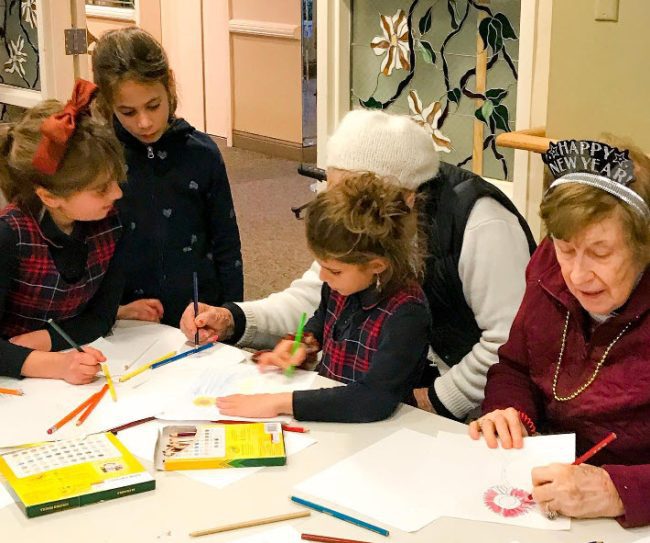
- Coordinate a community art project in a central location to celebrate local culture or artists.
- Set up a program for schoolkids to socialize with senior citizens in nursing homes, hospitals, or retirement communities.
- Create a program to offer free translation services for ESL families in the community.
- Help a local animal shelter improve its facilities, or find new ways to match homeless pets with their forever families.
- Build and maintain Little Free Libraries around your community, especially in underserved areas.
- Help local businesses become more environmentally conscious, increasing sustainability and decreasing waste.
- Create and lead a walking tour of your community, highlighting its culture, history, landmarks, and more.
- Find a way to record and celebrate local voices in your community’s history.
- Come up with ideas for welcoming immigrants and other newcomers to your community.
- Set up a series of events that will encourage the community to mix and experience each others’ foods, cultures, and more.
- Create and implement a new program to inspire a love of books and reading in preschool students.
- Set up and help run a new charitable organization your community needs.
Social Issues Project-Based Learning Ideas
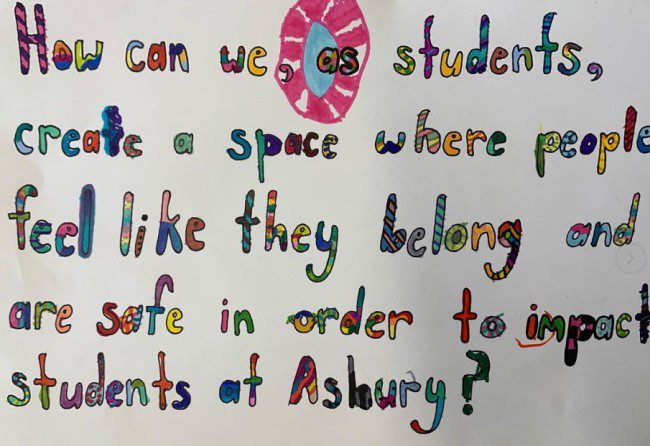
- Start an awareness campaign on a topic that’s important to you, like anti-bullying, healthy living, protecting the environment, civil rights, equality and equity, etc.
- Come up with and implement ways to increase voter turnout in your community, especially among younger voters.
- Write, record, and share with a wider audience your own TED Talk–style video on an issue that hasn’t been covered yet or on which you have a unique perspective.
- Devise and implement ways for unheard voices to be amplified in your school or community.
- Write and publicly perform a play that highlights a social issue that’s important to you.
- Look for areas in your community that present challenges to those with disabilities, and help to improve them to overcome those challenges.
- Research, write, and publicly present and defend a position paper on an issue that’s important to your community.
- Choose a real court case, then research the law and work with legal experts to prepare and present your own case as you would in a courtroom.
- Write, edit, seek, and incorporate real-world feedback, and publish or publicly present your own book, poem, or song on an issue that’s important to you.
- Start a program to teach a specific group (e.g., preschoolers, senior citizens, business owners) to care for and protect the environment.
- Plan and hold a fundraiser to support an issue you care about.
- Choose a law you feel is unjust, and write, research, and publicly present and defend a position paper about your desired change.
STEM Project-Based Learning Ideas

- Create an app that meets a specific purpose for a specific audience.
- Invent something new that the world needs, and then fund, create, and sell your product in the community.
- Design a game to help students learn important STEM concepts.
- Find a simple way to improve an existing product, especially if it cuts costs or improves environmental sustainability.
- Explore ways to reduce the amount of waste we produce, especially plastic and other landfill-bound items.
- Write a book or graphic novel that’s entertaining but also teaches kids about science or math.
- Devise new ways to provide clean drinking water to communities where water is scarce.
- Build an effective solar oven people can use to cook during extended power outages, or in areas where electricity isn’t available.
- Work with a university or STEM organization to gather, analyze, and present real-world scientific data.
- Design a building to fit a specific purpose or need, including researching the requirements and zoning laws, accurately drafting a plan, determining the costs, and presenting the plan to the proposed client.
- Create an interactive hands-on exhibit to teach people about STEM concepts.
- Determine a type of website you believe is missing, then research, build, and publish the site you envision.
Creative Arts Project-Based Learning Ideas

- Organize an art show for the community, seeking out those who ordinarily might not have a chance to display their work.
- Create and teach an art class in your area of expertise to children, the elderly, or another segment of the population.
- Design a mural for an area in your community that needs beautification, and seek funding or other assistance from community members to install it.
- Write a play about a topic that’s meaningful to you or your community. Work with the community to stage a performance for all to attend.
- Invite local dancers to perform at a school or community Festival of Dance, highlighting a variety of cultures and dance styles.
- Start a regular writer’s workshop where community writers can come together to share and seek feedback. Invite local authors or publishing experts to speak as guests.
- Collect stories, poems, and essays from local authors, and put them together into a book. Sell the book to raise money for a cause that’s important to local writers.
- Gather singers or instrumentalists from your community into a choir or band. Put on a concert to raise money for a special cause, or take your choir on tour to local retirement homes, hospitals, etc.
- Write a song about a person or cause that’s important to you. Produce and record the song, then find a way to share it with others.
- Make a short film about a local hero, community event, or local place. Invite others to do the same, and organize a local film festival.
What are some your favorite project-based learning ideas? Come share your thoughts in the We Are Teachers HELPLINE group on Facebook !
Plus, meaningful service learning projects for kids and teens ..
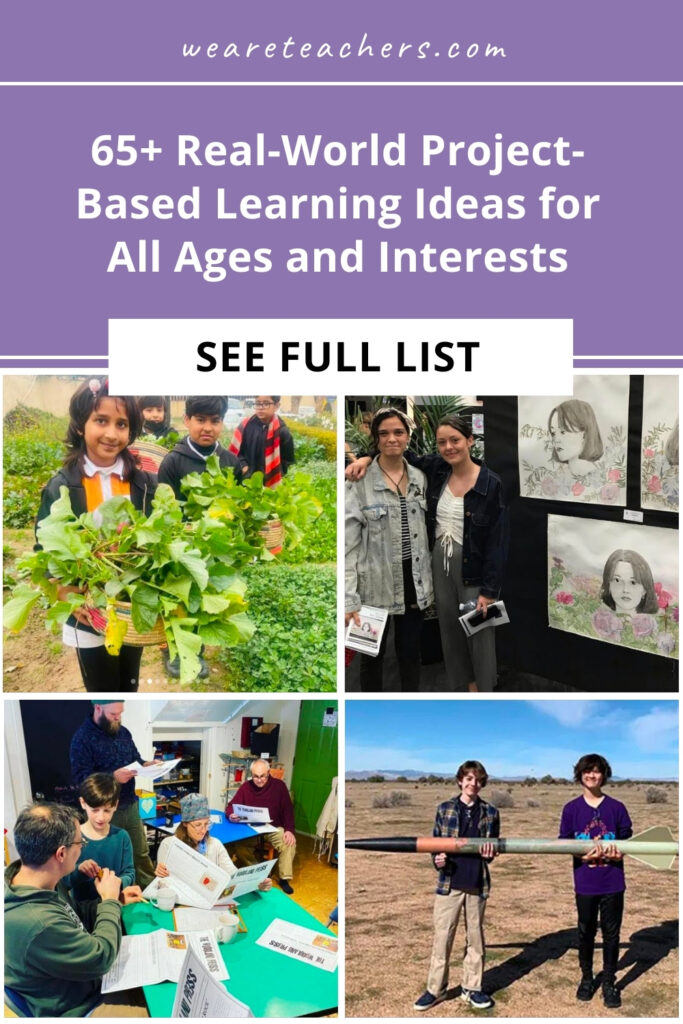
You Might Also Like

What Is Project-Based Learning and How Can I Use It With My Students?
There's a difference between regular projects and true-project based learning. Continue Reading
Copyright © 2023. All rights reserved. 5335 Gate Parkway, Jacksonville, FL 32256
- Select a Perspectives central text to read aloud.
- Determine what themes, messages, information and facts are being communicated through the text.
- Brainstorm possible objects that can be distributed among students and used as a manipulative during the read aloud. Note that the concept of realia can include music.
- Share authentic replicas (instead of relying on still photos only) for objects that may be unfamiliar to children (e.g., for a unit on transportation, bring in replicas of unfamiliar modes such as gondolas or hot air balloons).
- When sharing historical accounts in text, try to complement these with exploration of real objects at a museum (e.g., cars, televisions, telephones and washing machines from previous eras). Encourage children to think about dimensionality, function and what they learned from the real object that they would not have learned from the picture.
- Direct students to connect the object to their understanding of the central text while they listen.
- How is the object related to the text?
- How does the object represent the characters in the text?
- How does the object relate to the speaker of the text?
- How can the object help you remember the message or theme of the text?
- What, if any, other objects could represent the text’s message or theme?
English language learners
This strategy elicits Total Physical Response (TPR), which lets English language learners engage the text by moving, touching, pointing and role-playing.
Connection to anti-bias education
Realia encourages participation. Students hear the text and directly associate their comprehension to the object placed before them; manipulating the object during the read aloud solidifies their understanding of the text’s message. Extending the after-reading questions to include what other objects might serve as realia for the same text encourages students to pull in their individual perspectives and experiences.
Sample Realia chart:
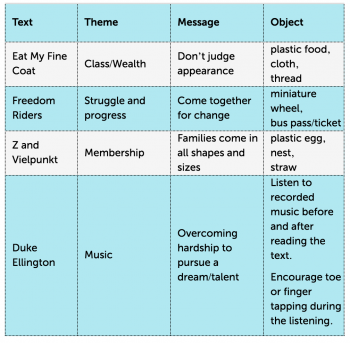
- Helping others in need.
- Gabe is Awesome
- Truth to power
- Google Classroom
Sign in to save these resources.
Login or create an account to save resources to your bookmark collection.

New Virtual Workshops Are Available Now!
Registrations are now open for our 90-minute virtual open enrollment workshops. Explore the schedule, and register today—space is limited!
Get the Learning for Justice Newsletter
- SUGGESTED TOPICS
- The Magazine
- Newsletters
- Managing Yourself
- Managing Teams
- Work-life Balance
- The Big Idea
- Data & Visuals
- Reading Lists
- Case Selections
- HBR Learning
- Topic Feeds
- Account Settings
- Email Preferences
How People Are Really Using GenAI
- Marc Zao-Sanders

The top 100 use cases as reported by users on Reddit, Quora, and other forums.
There are many use cases for generative AI, spanning a vast number of areas of domestic and work life. Looking through thousands of comments on sites such as Reddit and Quora, the author’s team found that the use of this technology is as wide-ranging as the problems we encounter in our lives. The 100 categories they identified can be divided into six top-level themes, which give an immediate sense of what generative AI is being used for: Technical Assistance & Troubleshooting (23%), Content Creation & Editing (22%), Personal & Professional Support (17%), Learning & Education (15%), Creativity & Recreation (13%), Research, Analysis & Decision Making (10%).
It’s been a little over a year since ChatGPT brought generative AI into the mainstream. In that time, we’ve ridden a wave of excitement about the current utility and future impact of large language models (LLMs). These tools already have hundreds of millions of weekly users, analysts are projecting a multi-trillion dollar contribution to the economy, and there’s now a growing array of credible competitors to OpenAI.
- Marc Zao-Sanders is CEO and co-founder of filtered.com , which develops algorithmic technology to make sense of corporate skills and learning content. He’s the author of Timeboxing – The Power of Doing One Thing at a Time . Find Marc on LinkedIn or at www.marczaosanders.com .
Partner Center
This east coast district brought a hollywood-quality experience to its students.

- Share article
Writing has long been an interest for Riley Brooker, but it had been fading.
Then, last school year, she had the chance to work directly with entertainment industry professionals to participate in writing and producing a short, cinema-quality film. The hands-on experience completely changed her outlook about the future, reigniting a passion for storytelling that otherwise might have faded away and perhaps altering her career trajectory.
The filmmaking experience in the Hampton City Schools, a 20,000-student district in Virginia, is the product of a partnership between the district and a company started by two TV actors that pairs entertainment industry leaders with Hampton students, teaching them how to direct, act, edit, and produce short films. Students have submitted some of the films to professional film festivals, where they’ve been shown, and they can earn real IMDb credits for their work, giving their resumes an early boost.
The program, called Hollywood to Hampton, began last school year and is a unique example of career and technical education that pairs high school learning with applied career experience at a time when more teens are questioning the value of a college degree and more companies appear to value experience over post-secondary education.
Students like Brooker who have participated say the program has exposed them to opportunities they hadn’t even considered before, and now they are considering careers in the entertainment industry. Even if the experience doesn’t lead to an entertainment career, it pushes students to embrace new skills and sharpen their writing and teamwork abilities.
“I had written a lot prior to the program, but it had been a dying passion. When I was given the opportunity to work with Next Gen, it set off a spark in me and gave me the confidence to continue with what once brought me so much joy,” said Brooker, now a high school senior. “This hasn’t just given me an outlet for my creativity, but it’s also inspired new goals for my future career, all ones that I had previously imagined impossible.”

Jacob Young (who played JR Chandler on the long-running soap opera “All My Children”) said he and Trent Garrett (who starred in the TV series “Andi Mack” and appeared in three episodes of “New Girl”) dreamed up Next Generation Storytellers, the company at the center of the collaboration with Hampton City Schools, during the pandemic when the entertainment industry, like so many others, shut down. Many actors and others in the industry were leaving Los Angeles—the industry’s longtime epicenter—as most activities moved online, allowing more flexibility in where people lived. That is how many things have remained, Young said.
“It dawned on us that this would be a great opportunity for us to connect with different parts of the country that may not have the same resources and with people who may not have the ability to move all the way to L.A. to pursue a potential career,” Young said. “We want people all across the country to understand this is something they could achieve in any market.”
Garrett is from Hampton, and his father, a local businessman, connected school district leaders with the actors, Young said. They worked together to set up the program, whose inaugural year was 2022-23.
Getting guidance from industry professionals
The Hampton school district offers two courses in conjunction with Next Generation Storytellers: Screenwriting 101, an eight-week class open to any student who wants to participate, and Movies 101, for which students must apply and be accepted.
In each class, students spend several weeks learning about the basics and intricacies of the entertainment industry, from genres of films to character archetypes. They review scripts and learn how to correctly format one of their own, then get feedback from their peers and professionals. They receive acting coaching and learn about lighting and directing a film as part of a curriculum school district leaders developed with Garrett and Young.
Hampton teachers lead the classes, but for each lesson, an industry professional with relevant experience appears via Zoom to discuss their work and answer students’ questions. Tracey Edmonds, who produced both the movie and TV series “Soul Food,” and David Janollari, who produced popular shows including “Six Feet Under,” have been among the class guests that Next Generation Storytellers has booked.
The lessons students learn go beyond the technical aspects of script writing and filmmaking.
“You wouldn’t believe it, but we’ve spent a lot of time on social-emotional skills, too, because it’s like, ‘Look, we understand these scripts are your babies,’ but there are days that aren’t going to go according to plan at all, and you have to pivot without getting upset,” said Kate Maxlow, Hampton’s director of curriculum, instruction, and assessment. (Maxlow was selected as a 2024 Education Week Leader to Learn From in February for her work involving students in a district curriculum overhaul.)

Young added: “You can have a complete outline of what you want to accomplish in filming on a given day, but then all of a sudden it decides to rain, or a fire alarm keeps going off because of the fog machine you’re using. Rather than the entire day imploding, you figure out how to cut the noise in post-production and use the strobe light to improve on the original idea.”
The final products have a lasting impact
Students in Screenwriting 101 each wrote and submitted scripts that students in the Movies 101 course could decide to make into a short film. Students submitted more than 60 scripts before district curriculum leaders and film industry professionals whittled the list down to eight. From there, a panel of educators, community members, and professionals with various levels of expertise reviewed the scripts and narrowed the selection to the four films the students ultimately produced.
As part of the partnership’s inaugural year, student groups from each of Hampton’s four high schools made one of the four films. The films are fully produced, directed, and edited by students. The actors are—of course—students, too.
The final products premiered at the first Next Generation Storytellers Film Festival in late September . Young described the event as a “mini-Oscars or Golden Globes,” where students dressed up in formal attire (often their prom outfits) and attended a ceremony where they received awards, including for best picture, best original screenplay, and best actor.

This year’s festival is expected to also have entrants from students in Newport News, Va., and Charleston, S.C.
The four films Hampton students made were then submitted and screened at a professional film festival.
Once students had produced their films, curriculum leaders in Hampton crafted lessons around them to use in other high school English courses, expanding the impact of the program beyond just those who participated in the filmmaking courses, Maxlow said.
“These are stories written by students, filmed by students, acted by students, and now they’re going to go into our curriculum to now be lessons for younger students as well,” Maxlow said. “It’s going to live on in Hampton City Schools—future generations are going to use your movie in things like English class as a part of making inferences or understanding themes or etcetera.”
‘This could be a lifetime thing’
Students are reaping the benefits of the courses even after they complete their scripts and films. Many enter the classes anxious and nervous about the process but leave filled with self-confidence and pride in their work, said Jennifer Oliver, Hampton’s director of community and government relations.
One student decided to change their college plan to pursue an entertainment industry-related degree, Oliver said. Some students have been approached by talent scouts.
Antonio Pitts, a junior, said participating in the Hollywood to Hampton program “transformed” his life and “ignited a passion for storytelling.” He plans to pursue acting further in the coming years, he said.
Young said it’s testimony from students like Pitts that confirms the work he set out to do through Next Generation Storytellers is worthwhile.
“Here are these students who are seeing this isn’t a one-time thing,” Young said. “This could be a lifetime thing.”
Sign Up for EdWeek Update
Edweek top school jobs.

Sign Up & Sign In

Guest editorial: special issue on reinforcement learning for real life
- Published: 02 August 2021
- Volume 110 , pages 2291–2293, ( 2021 )
Cite this article
- Yuxi Li 1 ,
- Alborz Geramifard 2 ,
- Lihong Li 3 ,
- Csaba Szepesvari 4 &
- Tao Wang 5
2217 Accesses
3 Altmetric
Explore all metrics
Avoid common mistakes on your manuscript.
Reinforcement learning (RL) is a general paradigm for learning, predicting, and decision making, with broad applications in sciences, engineering and arts. RL has seen prominent successes in many problems, such as Atari games, AlphaGo, robotics, recommender systems, and AutoML. However, applying RL in the real world remains challenging. A natural question arises: What are the challenges and how to address them?
The main goals of the special issue are to: (1) identify key research problems that are critical for the success of real-world applications; (2) report progress on addressing these critical issues; and (3) have practitioners share their successful stories of applying RL to real-world problems, and the insights gained from the applications.
We received 60 submissions, following an open call for papers successfully applying RL algorithms to real-life problems and/or addressing practically relevant RL issues, with respect to practical RL algorithms, practical issues, and applications. After a rigorous reviewing process, we accepted 11 articles, each of which was assessed by at least three reviewers, with one, mostly two, or three rounds of revisions.
In the article titled “Inverse Reinforcement Learning in Contextual MDPs”, the authors Stav Belogolovsky, Philip Korsunsky, Shie Mannor, Chen Tessler, and Tom Zahavy formulate the contextual inverse RL problem as a non-differential convex optimization problem and adapt descent methods to compute its subgradients, with both theoretical and empirical analysis, in particular, for zero-shot transfer to unseen contexts, and with applications to sepsis treatment.
The authors Ioannis Boukas, Damien Ernst, Thibaut Théate, Adrien Bolland, Alexandre Huynen, Martin Buchwald, Christelle Wynants, and Bertrand Cornélusse in the article titled “A Deep Reinforcement Learning Framework for Continuous Intraday Market Bidding” study the strategic participation of energy storage to maximize profits in a continuous intraday market with a centralized order book, considering operational constraints, using an asynchronous fitted Q-iteration algorithm for improved sample efficiency.
In the article titled “Bandit Algorithms to Personalize Educational Chatbots”, the authors William Cai, Josh Grossman, Zhiyuan Jerry Lin, Hao Sheng, Johnny Tian-Zheng Wei, Joseph Jay Williams, and Sharad Goe develop a rule-based chatbot to explain math concepts, provide practice questions, and offer tailored feedback. They show that a contextual bandit approach outperforms A/B testing with lower cost for personalization in a live deployment of an educational conversational agent.
The authors Gabriel Dulac-Arnold, Nir Levine, Daniel J. Mankowitz, Jerry Li, Cosmin Paduraru, Sven Gowal, and Todd Hester identify nine challenges for RL to be deployed in real-life scenarios, formulating each challenge in MDP, analyzing its effects on recent RL algorithms, presenting existing efforts to address it, and open source a suite of continuous control environments, in the article titled “Challenges of Real-World Reinforcement Learning: Definitions, Benchmarks & Analysis”.
The authors Josiah P. Hanna, Siddharth Desai, Haresh Karnan, Garrett Warnell, and Peter Stone in the article titled “Grounded Action Transformation for Sim-to-Real Reinforcement Learning” study how to transfer policies learned in simulation to real-life scenarios with a humanoid robot, in particular, with stochastic state transitions, and demonstrate performance gains in controlled experiments and with a real robot.
In the article titled “Air Learning: A Deep Reinforcement Learning Gym for Autonomous Aerial Robot Visual Navigation”, the authors Srivatsan Krishnan, Behzad Boroujerdian, William Fu, Aleksandra Faust, and Vijay Janapa Reddi introduce an open source simulator for resource-constrained aerial robots, and deploy domain randomization and hardware-in-the-loop techniques for an Unmanned Aerial Vehicles (UAVs) agent on embedded platforms, considering quality-of-flight (QoF) metrics, such as the energy consumed, endurance, and the average trajectory length, and mitigating the hardware gap w.r.t. the discrepancy in the flight time using artificial delays in training.
In the article titled “Dealing with Multiple Experts and Non-Stationarity in Inverse Reinforcement Learning: An Application to Real-Life Problems”, the authors Amarildo Likmeta, Alberto Maria Metelli, Giorgia Ramponi, Andrea Tirinzoni, Matteo Giuliani, and Marcello Restelli introduce batch model-free inverse RL approaches to handling data from multiple experts and non-stationarity in reward functions, and evaluate the performance with scenarios of highway driving, user preference inference in social networks, and water management.
In the article titled “Lessons on Off-policy Methods from a Notification Component of a Chatbot”, the authors Scott Rome, Tianwen Chen, Michael Kreisel, and Ding Zhou present their experience applying off-policy techniques to train and evaluate a contextual bandit model for troubleshooting notification in a chatbot, considering a null action, a limited number of bandit arms, small data, reward design, logging policy, and model post-training.
The authors Wenjie Shang, Qingyang Li, Zhiwei Qin, Yang Yu, Yiping Meng, and Jieping Ye in the article titled “Partially Observable Environment Estimation with Uplift Inference for Reinforcement Learning based Recommendation” propose to estimate a partially observable environment from past data by treating hidden variables as a hidden policy, with a deep uplift inference network model, and conduct experiments in both simulated and real-life environments, in particular, for a program recommender system on a large-scale riding-hailing platform.
In the article titled “Automatic Discovery of Interpretable Planning Strategies”, the authors Julian Skirzyński, Frederic Becker, and Falk Lieder propose to transform RL policies into interpretable descriptions with imitation learning, program induction, and clustering, and evaluate the performance with behavioral experiments.
The article by authors Sabina Tomkins, Peng Liao, Predrag Klasnja, and Susan Murphy on “IntelligentPooling: Practical Thompson Sampling for mHealth” undertakes a study to address the challenges of learning personalized user policies from limited data and non-stationary responses to treatments, with a high probability regret bound, an empirical evaluation, and a pilot study in a live clinical trial.
Collectively, these 11 articles illustrate the diverse range of issues currently being investigated in the field of reinforcement learning for real life.
Author information
Authors and affiliations.
Attain.ai, Edmonton, T5R 4R4, Canada
Facebook AI, Menlo Park, 94025, USA
Alborz Geramifard
Amazon, Seattle, 98121, USA
DeepMind & University of Alberta, Edmonton, T6G 2E8, Canada
Csaba Szepesvari
Apple, Cupertino, 95014, USA
You can also search for this author in PubMed Google Scholar
Corresponding author
Correspondence to Yuxi Li .
Additional information
Publisher's note.
Springer Nature remains neutral with regard to jurisdictional claims in published maps and institutional affiliations.
Rights and permissions
Reprints and permissions
About this article
Li, Y., Geramifard, A., Li, L. et al. Guest editorial: special issue on reinforcement learning for real life. Mach Learn 110 , 2291–2293 (2021). https://doi.org/10.1007/s10994-021-06041-3
Download citation
Published : 02 August 2021
Issue Date : September 2021
DOI : https://doi.org/10.1007/s10994-021-06041-3
Share this article
Anyone you share the following link with will be able to read this content:
Sorry, a shareable link is not currently available for this article.
Provided by the Springer Nature SharedIt content-sharing initiative
Advertisement
- Find a journal
- Publish with us
- Track your research
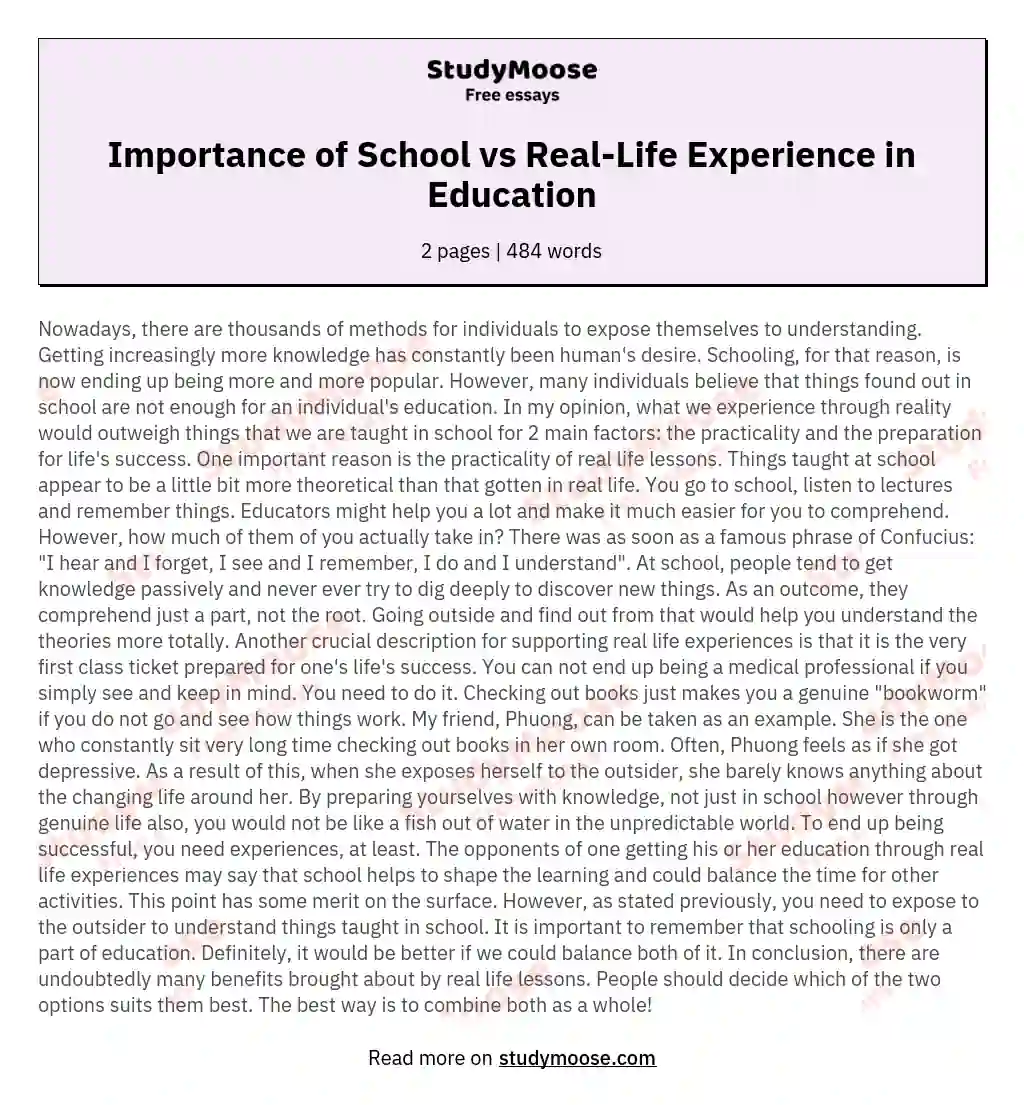
Real Learning Defined. Real Learning is learning as a life skill. It is learning from experience, from other people, from work, from feedback, and from courses and workshops. Real Learning begins when you Discover a new idea, Assess it for worthiness, Act upon it, Reflect on it, and perhaps share it with others.
Real-life experiences shape and mold us in a way that affirms our identity and purpose. This is why all life experiences outside the classroom are worth keeping and remembering. Short 1 Minute Speech on the Importance of Learning Through Experience. The learning process of a person happens throughout the course of his life.
MyWays Report 11: Learning Design for Broader, Deeper Competencies presents research, design principles, and case studies on key practices, like real-world learning, that support student development of agency, social capital, and competencies for success. Photo at top, courtesy of NGLC: Students at Vista High School engage in real-world learning.
Keep It Real. Students want to learn about things that have an impact on them in their daily lives. Example: Give students an opportunity to learn about where they live by researching how culture, religion, and traditions have shaped their community and perhaps their lives as well. As you introduce this lesson in history or social studies, remember that some students might feel proud of their ...
The learner plays an active part in the learning process. It is an individual-focused learning technique for learning from experience. A common example of real learning through experience is that of botany students. While they can simply learn about the various plants and trees by reading books on the subject, they are regularly taken on trips ...
The argument here is linking students real-life with content learnt in school encourages deep learning and equips students with higher order thinking skills (HOTS) in a natural and authentic process. It is suggested that teachers adapt Re-LiMDD in their daily teachings to resolve everyday issues occurring in the classroom; it can be directly ...
Processes also become the potent force and the content gathered is organized properly into the portfolios (Kurbel 2001 ). Learning experience in real-life approach engages all senses, letting students create a useful, shared and meaningful outcome. Many classrooms teach from either a visual or an auditory style, yet sight and hearing are only ...
Real world learning is a developing educational concept in the higher education literature. The approach contains the ethos of deep, experiential, personalised and applied learning experiences (Boss, 2015; Rau, Griffith, & Dieguez, 2019; Sharma, Charity, Robson, & Lillystone, 2018).There are several pedagogic proposals, reaching from academic programme to sector levels, suggesting curricular ...
June 18, 2014 at 4:00 a.m. EDT. Children read state-issued textbooks at a classroom of the Eleazar Lopez Contreras school in Caracas, Venezuela, on May 23, 2014. (REUTERS/Carlos Garcia Rawlins ...
Real Learning for Real Life. Leadership. Personalized Learning. Post-Secondary. 1. The digital learning revolution is a bigger deal than the printing press five hundred years ago-and it will occur over one generation rather than a century. The ability to learn anything anywhere anytime is changing life options for hundreds of millions of people.
Planning and Preparation. 1. Community Engagement. If you want more youth engaged in meaningful projects, gaining the benefit of internships, pursuing valuable credentials, or hatching their first business—the place to start is community conversations about learning goals.
The answers will yield a rich graduate profile and support for real world learning. (See Battelle's PortraitofaGraduate.org for examples). 2. Career Awareness. Help students develop a broad and ...
Real learning happens in real life By Jim Knight Categories: Change management, Coaching, Continuous improvement, Facilitation, Fundamentals, Implementation April 2021 When talking about instructional coaching, I find it helpful to divide professional learning into two different models: outside-in and inside-out. The outside-in model involves ...
According to the Authentic Learning creator and guru, Steve Revington, Authentic Learning "is real life learning. It is a style of learning that encourages students to create a tangible, useful products to be shared with their world.". Not only are we teachers bringing in real world context to our classrooms, but our students are taking ...
Bellevue's Master of Science in Clinical Counseling degree is accredited by CACREP, the Council for Accreditation of Counseling and Related Educational Programs. Kayne not only teaches the program, he is a practitioner; a living example of Bellevue's motto - "Real Learning for Real Life.". Kayne, however, didn't become what he is ...
Table of contents. The process of learning is a continuous journey that lasts a lifetime. As Alvin Toffler once said, "learning is like rowing upstream; not to advance is to drop back," and this couldn't be truer. Learning is a crucial aspect of life that allows us to grow and develop as individuals. It is not just limited to academic ...
Real-world writing helps students make connections between real-life situations and the skills they are learning within the classroom. The activities within Weekly Real-World Writing not only provide the writing practice students need, but the lessons also include creative outlets that teach important skills for every type of learner in the classroom.
A requirement for this class is a "real-life" essay or letter detailing a true experience you had; you should submit this to a real person or company. The time has come to decide on your real-life, experiential essay or letter. For this final paper/essay assignment, you should be able to plan, write a draft, edit/proofread a piece of ...
Project-based learning (PBL) uses real-world projects and student-directed activities to build knowledge and skills. Kids choose a real-world topic that's meaningful to them (some people call these "passion projects"), so they're engaged in the process from the beginning. These projects are long-term, taking weeks, months, or even a ...
Recognising RWL as an authentic assessment experience, which can be personalised to create challenging and unique learning, the concept map also ascertains that formative and group peer review and assessment will allow students to develop personal traits such as resilience, reflection and team working. Fig. 14.1. Concept map from the authors.
Realia are real-life objects that enable children to make connections to their own lives as they try to make sense of new concepts and ideas. This strategy brings the Perspectives central text to life for students by using everyday objects during the read aloud.
A dataset taken in a real-life environment was used, unlike in other studies. • Experiments were done to get the best model configurations for long-themed activities. • This work also reviews the gyroscope's real influence to the final results. • The current approaches in this field, oriented towards real life, were highly improved.
Please join the Stanford Accelerator for Learning for an exciting panel discussion featuring industry experts from Meta, Niantic (creators of Pokemon Go), Xreal, and Magic Leap on the integration of AI and augmented reality and the future of immersive learning experiences. After the discussion, get hands-on with interactive demos featuring the latest AR glasses! Speakers Alex Driskill-Smith ...
The 100 categories they identified can be divided into six top-level themes, which give an immediate sense of what generative AI is being used for: Technical Assistance & Troubleshooting (23% ...
The program, called Hollywood to Hampton, began last school year and is a unique example of career and technical education that pairs high school learning with applied career experience at a time ...
Guest editorial: special issue on reinforcement learning for real life. Reinforcement learning (RL) is a general paradigm for learning, predicting, and decision making, with broad applications in sciences, engineering and arts. RL has seen prominent successes in many problems, such as Atari games, AlphaGo, robotics, recommender systems, and AutoML.
In this 2024 edition of the guide - first published in 2020 - you will find updated data, profiles highlighting real-life stories from campus prevention professionals focused on a unique or innovative approach to the Strategic Prevention Framework, ideas for building considerations of cultural factors into each step of the SPF, and five strategies for success during times of disruption to ...
- business plan
- course work
- research paper

IMAGES
VIDEO
COMMENTS
No better way to visit this incredible archipelago of islands than from the deck of your own fully crewed sailing or motor yacht vessel. Charter or hire your special luxury or mega yacht from Luxury Yacht Vacations, Ltd.. The Mediterranean and especially the Greek islands have fascinated sailors, poets and scholars for thousands of years.
Your number one choice for VALUE Yacht Charters around the Greek Islands! Personalized Top-Quality Service. With our knowledge YOU WILL GET The Perfect Yacht for Your Requirements. Wide Choice of Top-Quality Yachts on 15 Bases for the Greek Islands. Over 2,000 Top of the Line Monohulls and Catamarans.
You also need to consider daily costs such as delicious food and mooring fees as you explore the exquisite islands of Greece. Moorings fees vary by size of boat and season, but range between 30 euro to 80 euro usually. Check availability and price up your picture-perfect yacht charter in Athens or Corfu today.
CONTACT. Nicholson Yacht Charters, Inc. 24 Mill Brook Lane. Blue Hill, Maine 04614. Tel: (617) 661-0555. (800) 662-6066. [email protected]. Sail the Greek Islands with a private yacht charter from Nicholson Yacht Charters. We offer a large fleet of luxurious catamarans and sailing yachts throughout Greece.
Luxury yacht charters in Greece. Istion Luxury Yachts is proud to offer a unique fleet of private crewed charter yachts and catamarans in Greece, the Mediterranean and the Caribbean. Whether you wish to sunbathe under the Aegean sun, spend exhilarating moments sailing between the world's most beautiful islands or simply relax on board, Istion ...
The perfect private luxury cruise holiday. Greece yacht charter is the perfect private luxury cruise holiday. Nicholson Yachts offers a wide choice of charter yachts and cruise itineraries. With over 6,000 islands in the Aegean and Ionian Sea combined, a Greece yacht charter takes island hopping to a whole new level.
Yachting through the Cyclades Islands (7 Nights) Your Greece private yacht charter begins at the port of Piraeus in Athens, where you will board your luxury motor yacht and embark on a 7 night private cruise through the Greek Isles. The yacht will be equipped with a dedicated crew giving you the flexibility to alter the itinerary when needed ...
A yacht charter in Greece offers the ultimate superyacht experience for those seeking sun-drenched days, a rich and vibrant culture, coupled with a generous portion of exclusivity and luxury.Explore ancient ruins and UNESCO World Heritage sites, indulge in award-winning cuisine, relax at exclusive beach clubs, drop anchor at uninhabited islands, or dance the night away at some of the ...
Motor yacht O' Ceanos is an excellent display of design and engineering offering charters in the East Med. Built in 2006 by Mondo Marine, she is fitted with the finest Italian fabrics, marbles and woods to make her a real European beauty. The 49.5 m sleeps 12 to 14 guests in seven cabins designed to maximize space. 49.50. Visit Greece on a ...
A. For the yacht ANATOLIE: Account name: MATSAKIS NEPA Account number: EUR 5710105082199. IBAN : GR5601727100005710105082199 Bank: PIRAEUS BANK BIC code: PIRBGRAA Agency : 84100 ERMOUPOLIS - SYROS - GREECE. Address of beneficiary: MATSAKIS NEPA Palaion Patron Germanou, 9C 84100 ERMOYPOLIS - SYROS GREECE. Tel : +30 69 78 19 66 67 or +30 69 ...
2024 Prices. ALL PRICES ARE IN EUROS FOR ONE WEEK PRIVATE CHARTER YACHT. *Rental - Weekly price with insurance and VAT **Expenses - Operating costs including : Harbor and marina fees, basic salary of 3 or 4 crew members, AND fuel expenses paid by the owner (not bad surprise in the end of the trip !)
3. Three-bedroom sailboat for eight (from USD 786) Show all photos. Renting this sailboat rental in Greece can take you on an eight-hour day trip to Agia Pelagia, a majestic, hidden seaside fishing village. You can enjoy outdoor activities such as fishing, snorkeling, and swimming.
A private yacht charter in the Aegean Sea and in the middle of the Mediterranean thru the numerous Greek Islands surrounded by the splendor of crystal clear water…. Cruise to Dodecanese and Cyclades Greek Islands and discover Rhodes, Symi, Kos, Kalymnos, Patmos, Arki, Santorini, Mykonos and many others from a different perspective.
Sailors who want more than just "tick off" the Islands, will discover from Corfu to Zakynthos plenty of lively , interesting ports, fabulous bays for swimming, and unspoiled sandy beaches framed by olive groves and bizarre rocks. [ click here to read more about these greek islands >> ] We offer Crewed Yacht Charters - Greek island cruises ...
Private Yacht Charters. With the amount of choice available, it can be difficult to choose your destination, but with a Greek island gulet cruise, you can have them all. ... Two of our most popular Greek island cruises sail from Bodrum harbour the first, cruising the north islands. After meeting your captain and crew its time to sit back, relax ...
Welcome to Boss Cruises, one of the most famous private Yacht Cruise companies to rent on Rhodes island, Greece. Your private, unique moments for sea explorers and travelers on the spectacular island of the Knights. BOSS is a beautiful 18.20 meters lux Ferretti fly bridge motor yacht, offered for private charters and one of the most affordable ...
ALPHA-2 GREECE CRUISE 2024. The best of the Greek Islands Cruise 8 days Greece cruises from Athens to Folegandros, Santorini, Paros, Delos , Mykonos, Syros, Kythnos on board a 49 passenger traditional motorsailer.
A yacht charter in Greece offers the freedom to explore secluded bays, vibrant ports, and ancient ruins at your own pace. Planning your itinerary with Danielis Yachting allows you to customize ...
Luxury Private Yacht Cruises. - Chalkidiki Greece. - Aretsou Kalamaria Thessaloniki. +30 6932 244 100. For those who want to experience the real Greek summer, "Prive Cruises" offers you the opportunity to explore the clear and clean waters of the Mediterranean sea, spending wonderful time on board. If beautiful sunsets and spectacular ...
See Four Seasons' upcoming ultra-luxury cruise with a $350,000-a-week suite bigger than most homes. Brittany Chang. Apr 14, 2024, 3:58 AM PDT. Four Seasons says its Four Seasons I yacht cruise ...
Built by the famous Dynamique Yachts shipyard and having undergone a refit in 2018, sailing Yacht Amadeus was designed to please the most demanding of yachtsmen. Built for smooth sailing, this elegant cutter rigged sloop has a sleek hull design, comfortably reaching top speeds of 12 knots and ensuring excellent sailing performance. ..... The 33.5m/109'11" 'Amadeus' sail yacht built by the ...
The 5th edition of the International exhibition of yachts and boats - Moscow Boat Show, held from March 20 to 25, 2012 will be hosted by the first pavilion of Crocus Expo International Exhibition Centre.This popular show is dedicated not only to the specialists of the market segment and professional sportsmen but also to those who consider sailing sport to be their hobby and well cherished ...
Stavros Niarchos, the great Greek benefactor and tycoon, passed away on this day in 1996, leaving behind a foundation that continues his philanthropic work. Born on July 3, 1909 in Athens, Stavros Niarchos was a self-made businessman and shipping tycoon of immense wealth who possessed an exceptional ability to make money.
Please contact CharterWorld - the luxury yacht charter specialist - for more on superyacht news item "90 Sunreef Power yacht honored with the Golden Crown in the category Discovery of the year on the Russian market".
The 35.37m/116'1" open yacht 'Pershing 115/11' was built by Pershing in Italy. Her interior is styled by Italian designer design house Fulvio de Simoni and she was completed in 2016. This luxury vessel's exterior design is the work of Fulvio de Simoni. Range & Performance.